-
Posts
840 -
Joined
-
Last visited
Content Type
Profiles
Forums
Gallery
Events
Posts posted by Jond
-
-
5a starting the prep for the decking
This mid review gets us almost halfway to “ready to deck”. I have decided I want to add the decking before the bulwarks because I can then better hold down the fresh planks with the sides open. I hope it all works out.
- 1-2 these views showing my lay out of deck beams after removal of all the bulkheads. These beams are canted and set right, so I have a little more trimming of the bulkheads to be at or below these beams as we go. In the second images I have brought out a scaled-up deck plan, so I can understand where I need “grounds” or underdeck structure to take connections of equipment etc.
- 3 this image is to celebrate a full cleaning of the work area. Something needed more often than we admit. My concurrent build, the schooner Elizabeth Howard, is at the other end of the table.
- 4 Here we see installed under structure to areas of the desk where it is needed. I have focused to get one side done and included the extended frames at this time as well. I typically use up the scraps cut from the bulkhead extensions after removing them. The soft Luan plywood is easy on drilling for pins etc., has nice thickness and is light weight. The mast step is dead center of a blkhead. I used a 1/4 hole and will cut down the 5/16 mast at the deck line.
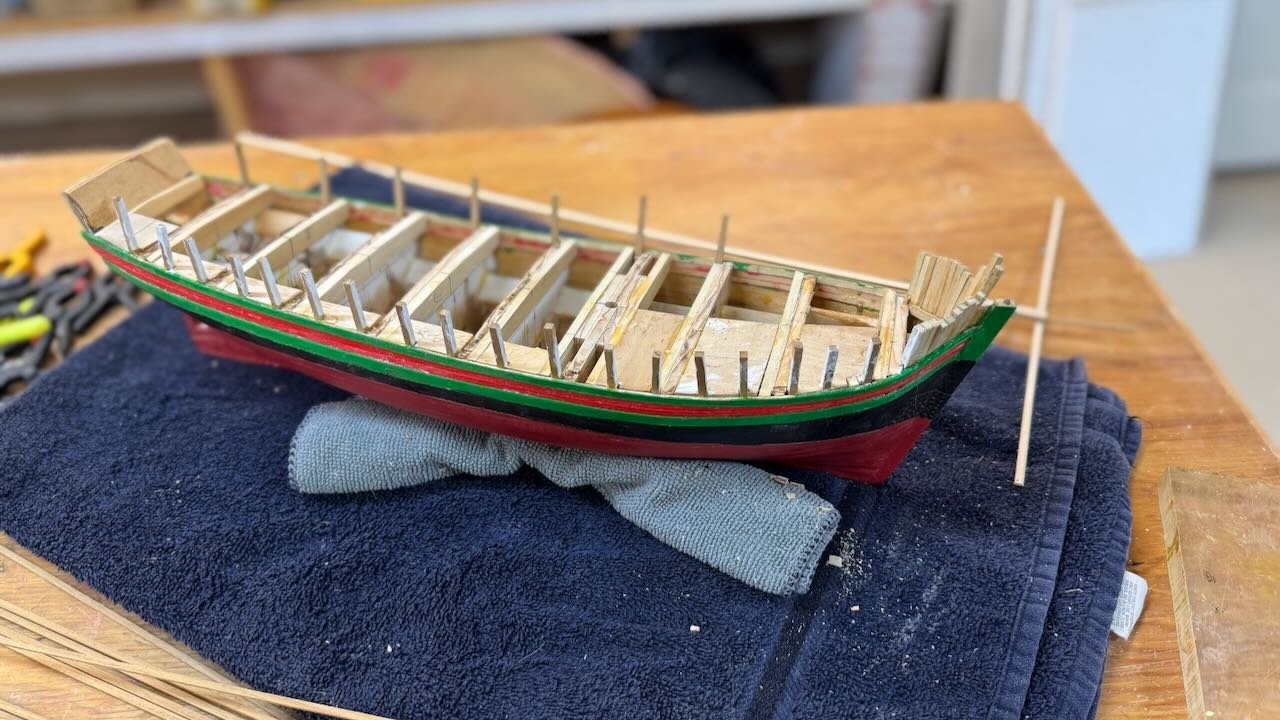
- 5-7 These 3 images show the work in the bow. I wanted to have solid cant frames at the bow as I assumed that they would have been in place. When looking at the museum pictures and others’ interpretations, I find unlike our Yankee schooners, these frames are cut off at the deck. Only a few are extended to carry the bulwarks forward to the stem. I would consider that light construction especially for arctic seas. [ not my call]. I cut them down to just above the deck.
- 8 shows the pre-stained shear plank [ outer half] installed most of the way forward. I will work on the tight bow curve in the next update.
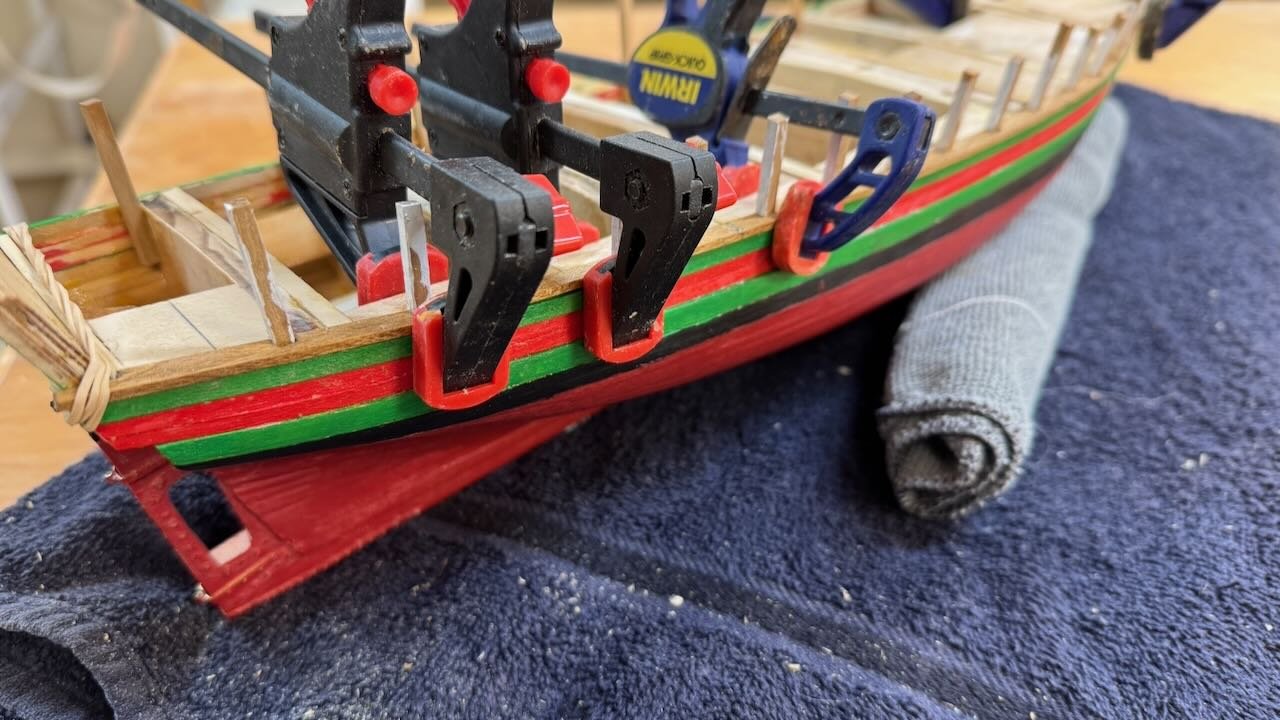
- 9-10. we had our monthly guild meeting and off I went. The second images is to highlight the privilege I had to set my model next to a beauty. The Mayflower shallop recently on the cover of NRJ is in the case. She was built by one of our members, who also is member and active at Newburyport, Ma. I took the picture saying that I hoped sitting there for an hour or so my model could improve.
-
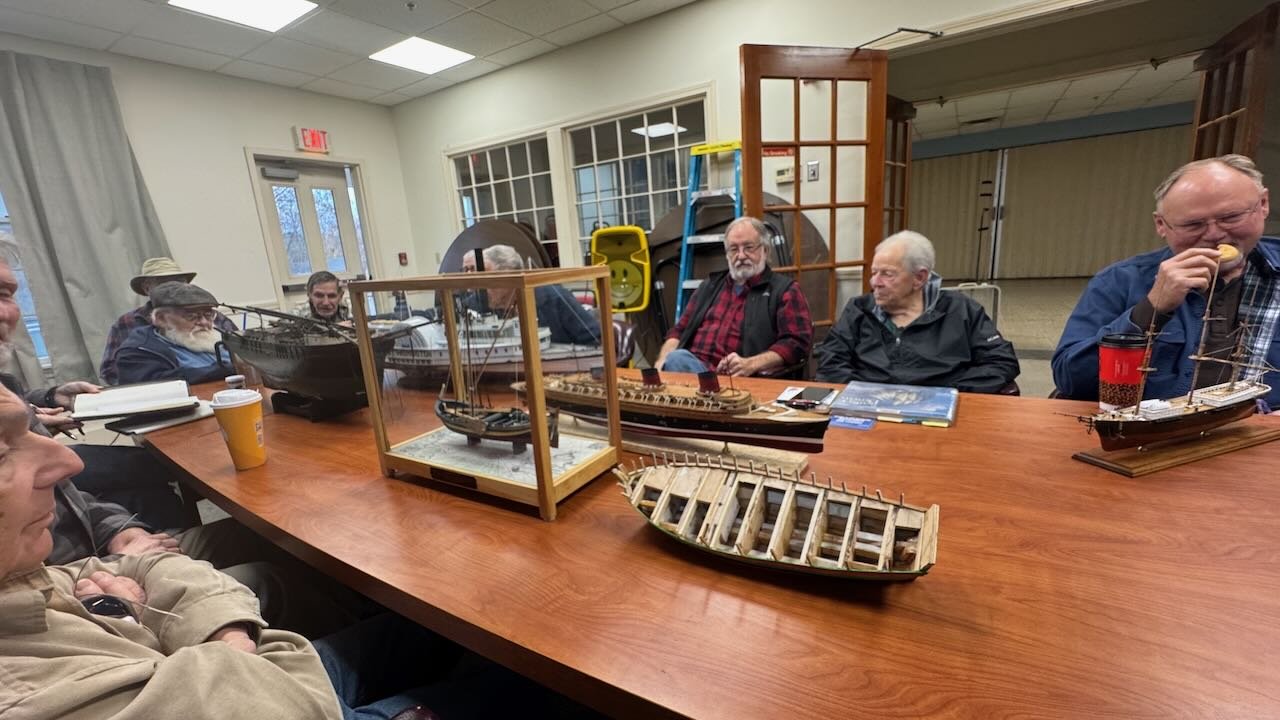
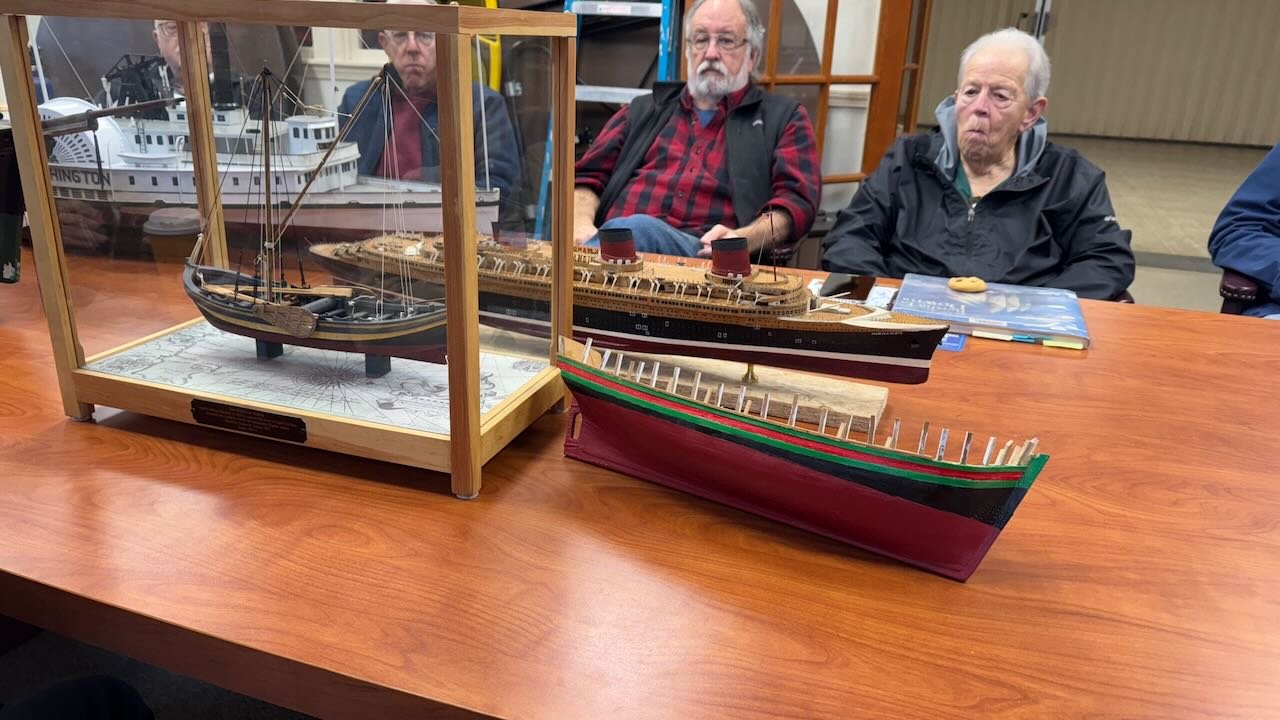
One of life’s little rewards is to occasionally be next to a master of his trade.
Cheers
- druxey, Harvey Golden, JacquesCousteau and 2 others
-
 4
4
-
 1
1
-
Dear Druxey
Thank you for dropping in. I recall sitting at a table with you at one of the last summer NRJ conferences in New Bedford I believe, where you showed us how you used simple hand tools to make a perfect mast. It was inspiring. I have to admit still well over my pay grade. When I get to it the mast on this little vessel has some twists. it is absolutely straight up per the drawings. The gaff is huge. In the Amundsen diary, the gaff broke three times.
anyway...thanks. I have replaced the damaged plank.
- Cathead, druxey and Harvey Golden
-
 3
3
-
13a deck work and standing rigging moving along
As I now divide my time between this build and the 1872 Norwegian ship Gjoa, things are not so fast. It is fun though, as Gjoa is in the hull stage as this build is into deck furniture and starting the rigging. This is a partial update.
For most of my guidance I refer to the age-old favorite book o fishing schooners by Howard Chapelle. Several similar scale schooners in the past and the detail I learned building a bigger scale bluenose several years ago. One difference from Bluenose is, from the photos of Elizabeth, lashed dead eyes were used instead of turnbuckles. Perhaps the 5 years between 1916 and 1921 made the difference. I am therefore using lashed bullseyes for many of the fixed stays that surely would have needed adjustment.
To work
- 1-3 these images show my low-tech approach to building the sliding goose neck for the jumbo boom. I took a brass channel drilled a hole on top. Then I set a tiny rivet upside down and put a cut off brass eye with system through the rivet and the hole in the channel and soldered it up. I then soldered a clevis on the end of a rod to sink into the fore end of the jumbo boom. I also added some handles to control the winch [ imagined anyway] and some chain. I am not proud of the mechanism but is represents that something would have been there.
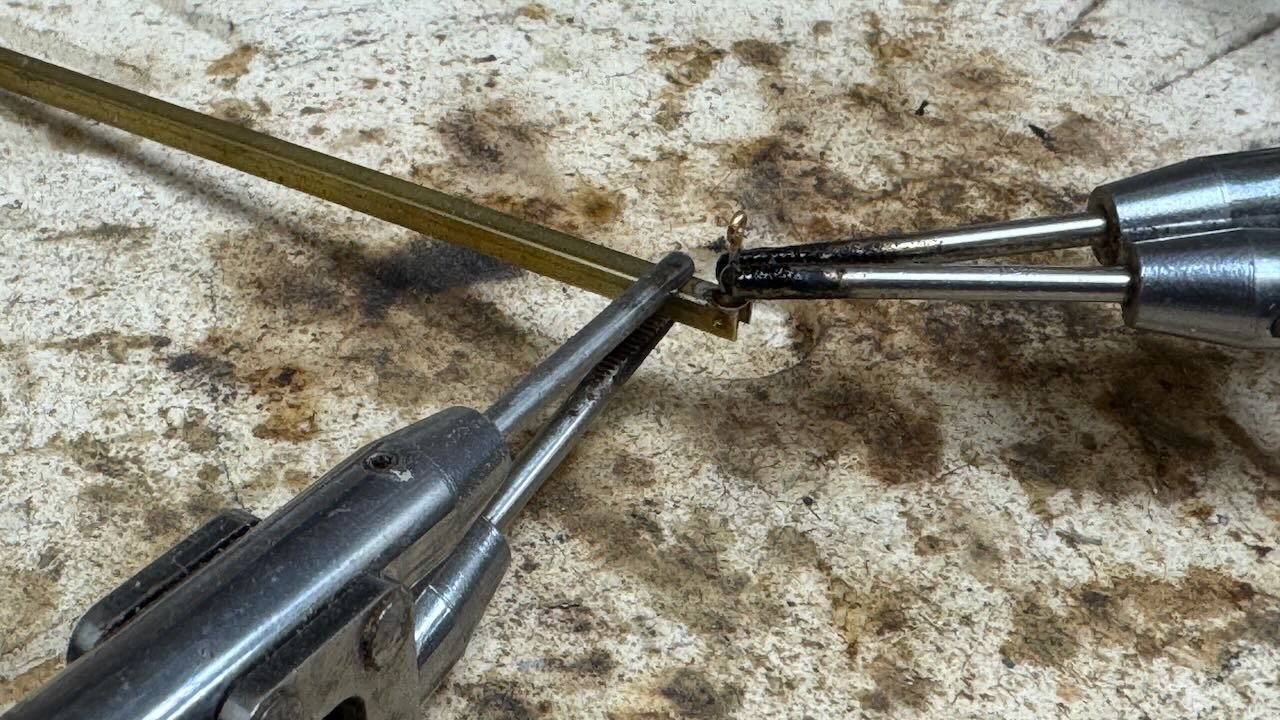
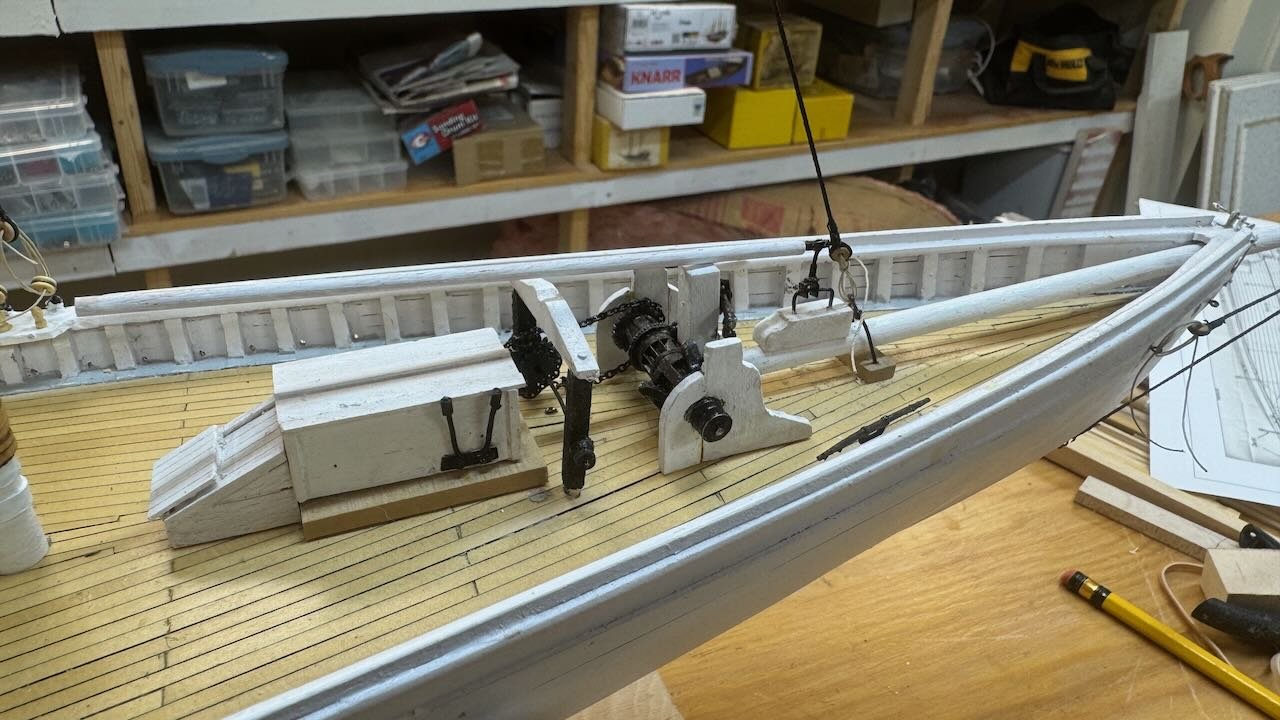
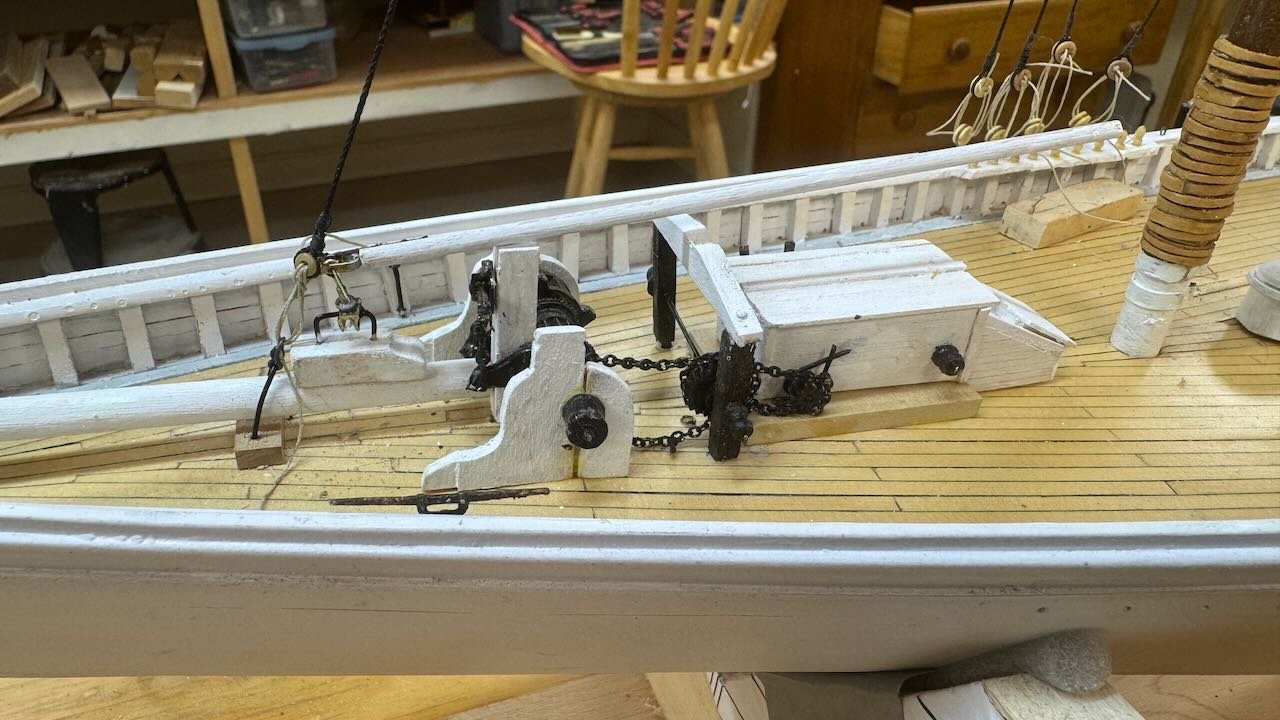
- 4-6 these images show progress making up the hardware and stringing the running rigging aloft. It is all left untied for now. When it is all in place I will have some extra hands here over the next holiday and we’ll square it all up, tighten and then lash all.
-
4b topside planking done
This update takes us through the four topside strakes below the deck and taking the hull off the jig. Then a quick look at possible ways forward. That means’, what’s next?
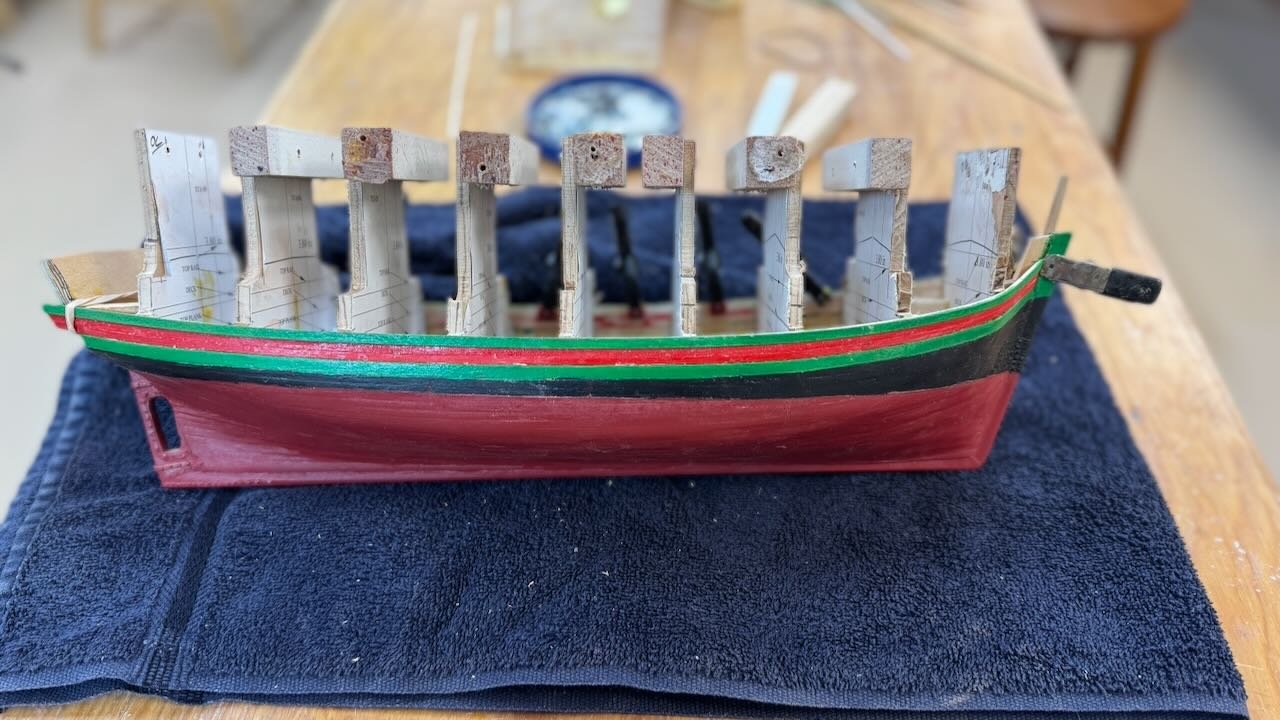
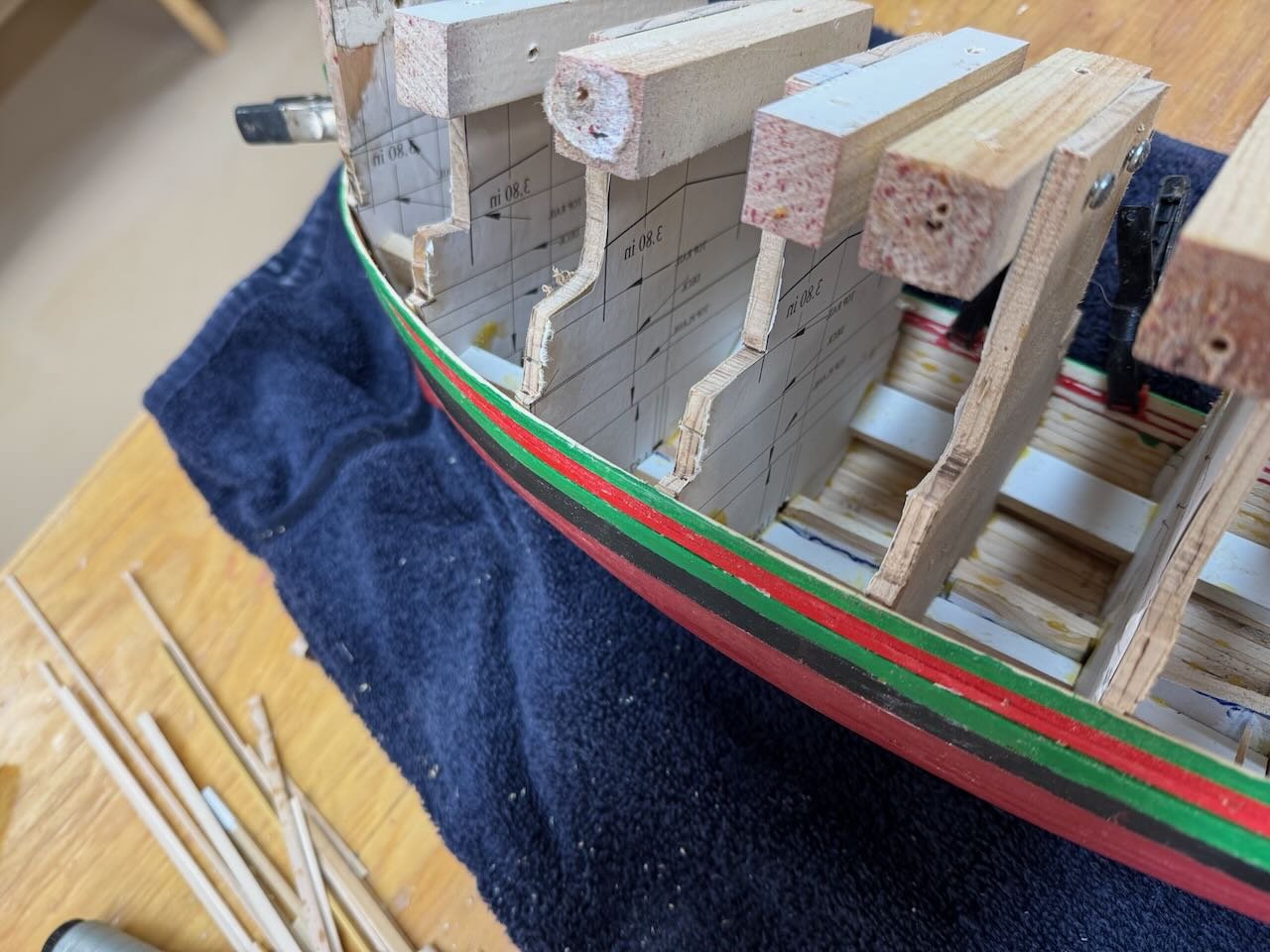
- 1-2 here we see the screws were undone holding the bulkhead blocking to the building board. Then the closeup shows the first cut back of the bulkhead at the deck level.
- 3-4 show the first cut down of the bulkheads to the top rail level.
What’s next to me is to figure out the extended frames acting as bulwark stanchions. I am going by the theory that every other frame would have been extended. I stretched a ¼ inch scale tape and found most bulkheads are 7 feet apart in scale. That would mean mid frames to be 3.5 feet or 42 inch on center. Half again would make frames at 21 inch centers, and that seems reasonable. The bow curve increases the distance between bulkhead 1 to 3 by 2 feet [ in scale].
-
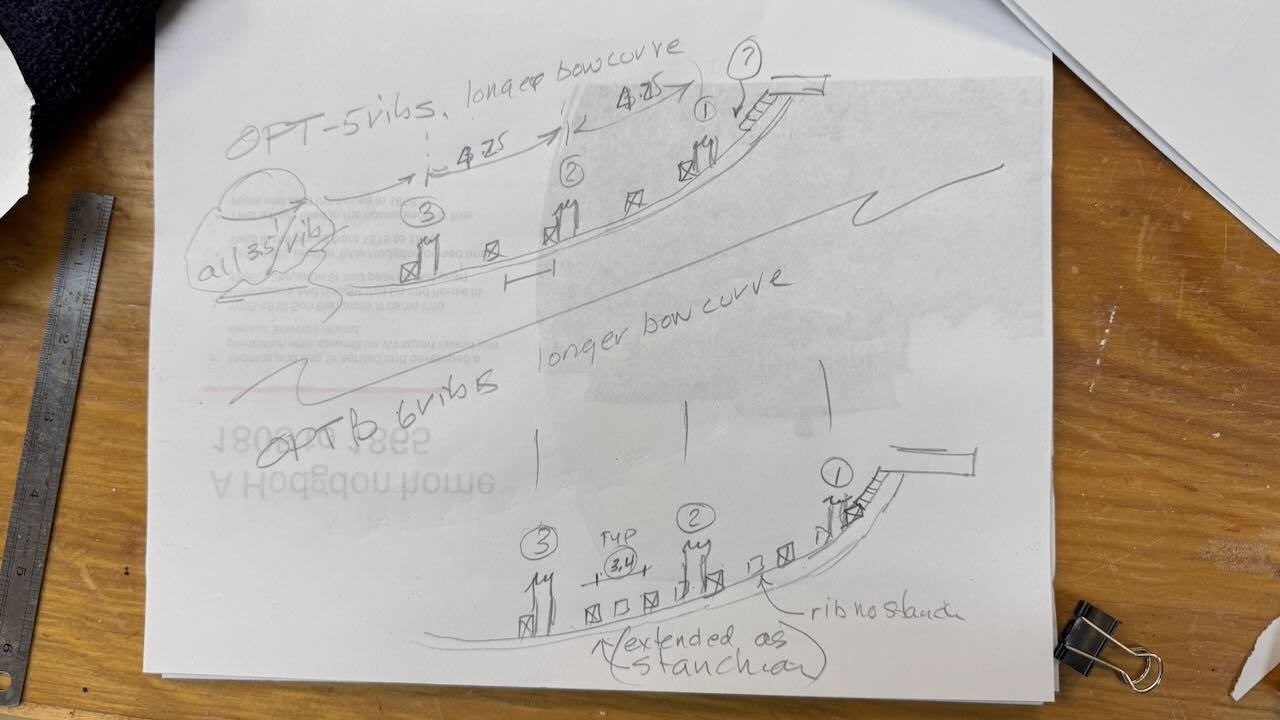 5. this hand drawn sketch shows my thought process. To continue the logic of the hull framing foreword of bulkhead 3 would continue with four stanchions [ 8 frames]. The spacing would grow however to 4.24 feet or 51 inches. I think that would be wrong. Therefore, I will use option 2 and add another stanchion [ or ttw frames ] in this area to keep more reasonable spacing. All of this thought is seat of my pants but I want to have at least thought about it.
5. this hand drawn sketch shows my thought process. To continue the logic of the hull framing foreword of bulkhead 3 would continue with four stanchions [ 8 frames]. The spacing would grow however to 4.24 feet or 51 inches. I think that would be wrong. Therefore, I will use option 2 and add another stanchion [ or ttw frames ] in this area to keep more reasonable spacing. All of this thought is seat of my pants but I want to have at least thought about it.
-
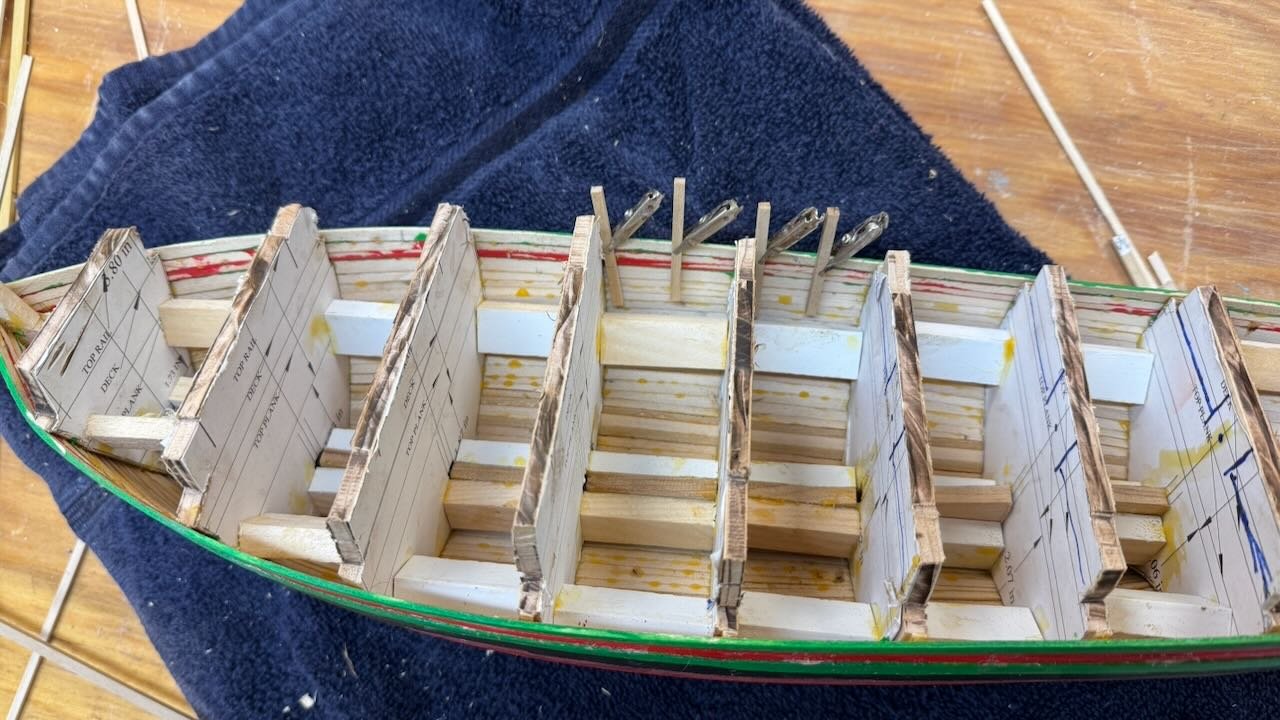 6 this view shows I have milled down some Costello strips to act as extended frames. I prefer their super smooth finish properties over a softer wood.
6 this view shows I have milled down some Costello strips to act as extended frames. I prefer their super smooth finish properties over a softer wood.
-
7
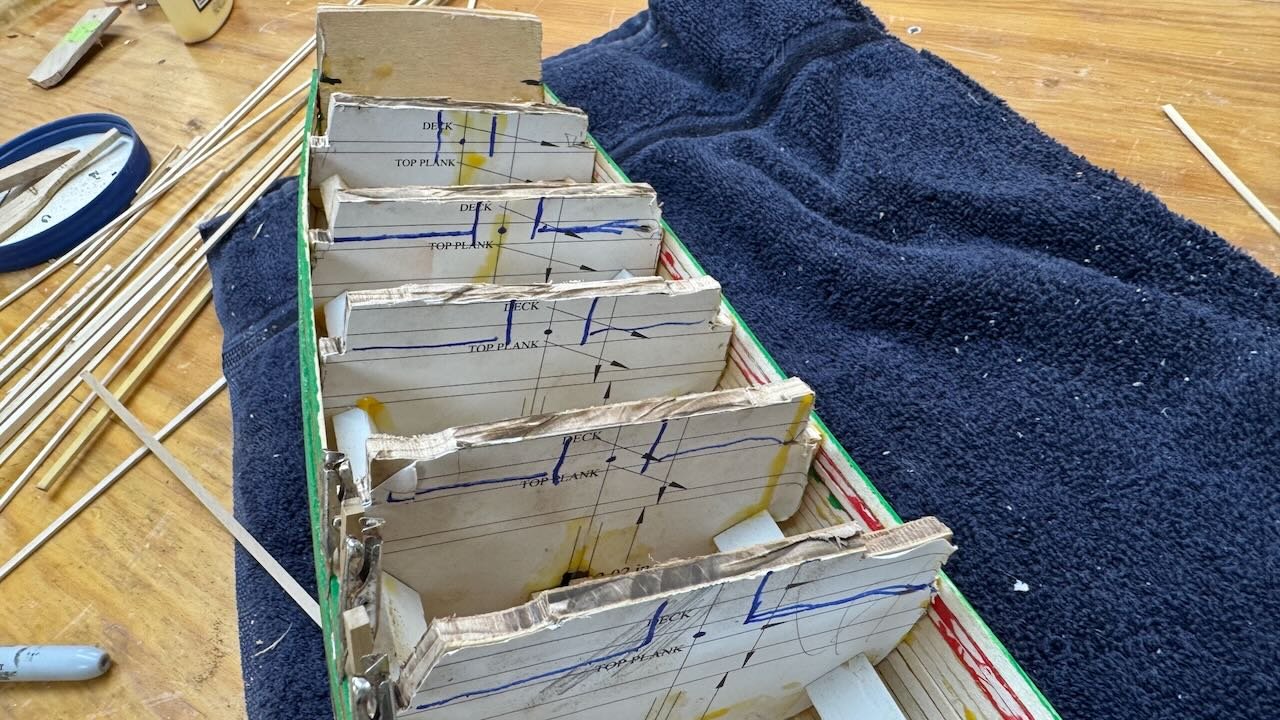 This view shows the second cut down do the bulkheads. I am cautious to remove all and for now am keeping the center section up to the rail line. I think that is waste of time for two reasons, so will likely change next week after more thought. This hull bulwarks is made up of 4 parallel strakes so probably no reason. If I make all the stanchions too high, they can get sanded back. Thus, having set them from the lines is not needed. I have learned the hard way that to build the bulwarks and then try to sand the bulkheads to use as deck framing is between awkward to impossible. So Likely I will first sand the bulk heads down, add a few thin beams to control the canter of the deck first and add tall stanchions second.
This view shows the second cut down do the bulkheads. I am cautious to remove all and for now am keeping the center section up to the rail line. I think that is waste of time for two reasons, so will likely change next week after more thought. This hull bulwarks is made up of 4 parallel strakes so probably no reason. If I make all the stanchions too high, they can get sanded back. Thus, having set them from the lines is not needed. I have learned the hard way that to build the bulwarks and then try to sand the bulkheads to use as deck framing is between awkward to impossible. So Likely I will first sand the bulk heads down, add a few thin beams to control the canter of the deck first and add tall stanchions second.
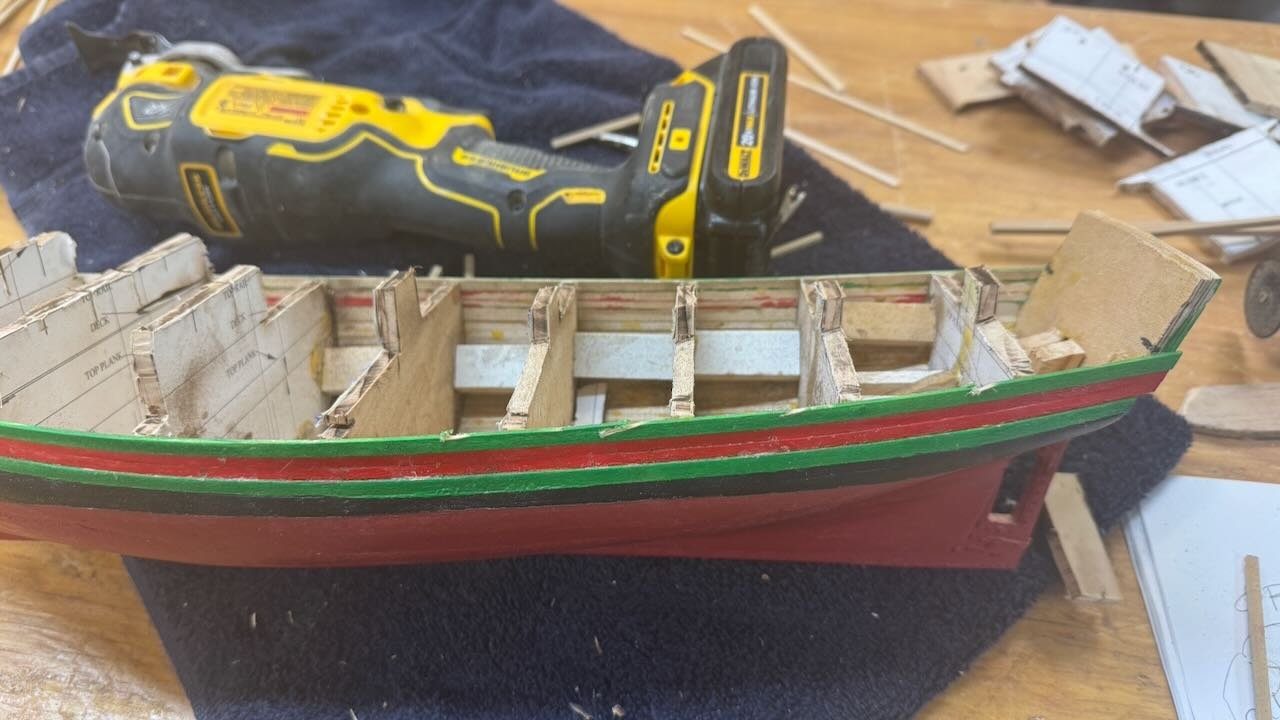
- 8. There as a oops. I foolishly thought to take my utility tool and cut smoother lines. The sideways vibration of the utility tool dug into my top strake. Oops. One step back I guess.
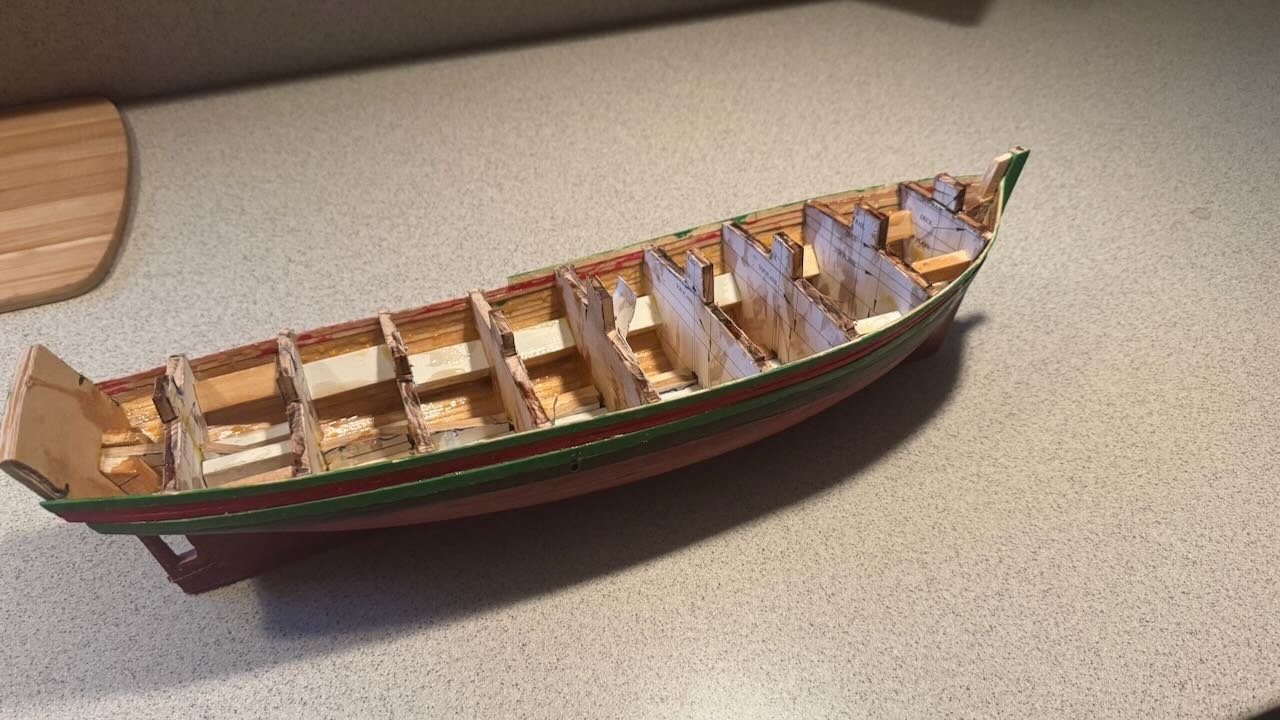
- 9. I followed Phil's advise and brushed in a light coat of resin to make the inside of the planking wicked strong. Also I needed to remove the inside blocking at the transom that would have interfered with the decking.
-
Phil
To seal the insides.......That sounds like great advice. Back when I started all this modeling, my hulls were for Radio Control sailing and both inside and outside were epoxied. Those hulls will last a long time..😀 I have never done that on my static hulls, but it makes a lot of sense to at least seal them, and I will do it. On this build , especially when the top strakes I am doing are so thin, a thin epoxy makes good sense.
thanks for the advice
Jon
-
Julie
thanks again for jumping in. I think working on the color is fun more than anything. Most of out New England builds are a bit boring. That said I fear "fiesta Green" and " real Red" respect painting that was apparently important to the crew. In Amundsen's diary he mentioned how before leaving after wintering, not only was the hull cleaned out and scrubbed, but they carried paint with them and touched it all up. It's too bad their photos are all black and white.
cheers
- sheepsail and Harvey Golden
-
 2
2
-
Harvey
thanks for dropping in. I have enjoyed your build as i have started this one and will drop back many times. Your study and work on deck and with the rigging looks great. I will highlight your source when i get to that stage. I am still not sure what i will do for setting up the scene. Perhaps when snow gets here it will come to me.
cheers
-
4 topside planking now started
This step is turning out to be a bit complicated. It is easier to show than just to go forward with words. Here is my trial [ and probable error] attempt to do this upper planking.
- 1 In this museum web photo we see green in sunlight. It is the color I am after.
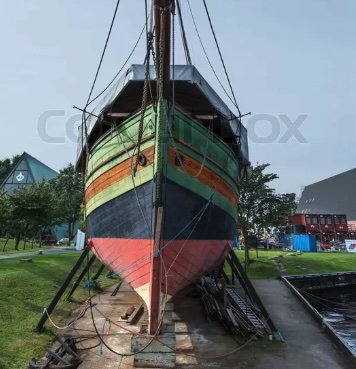
- 2 In this image I dry fit the two thin stakes to plan clamping

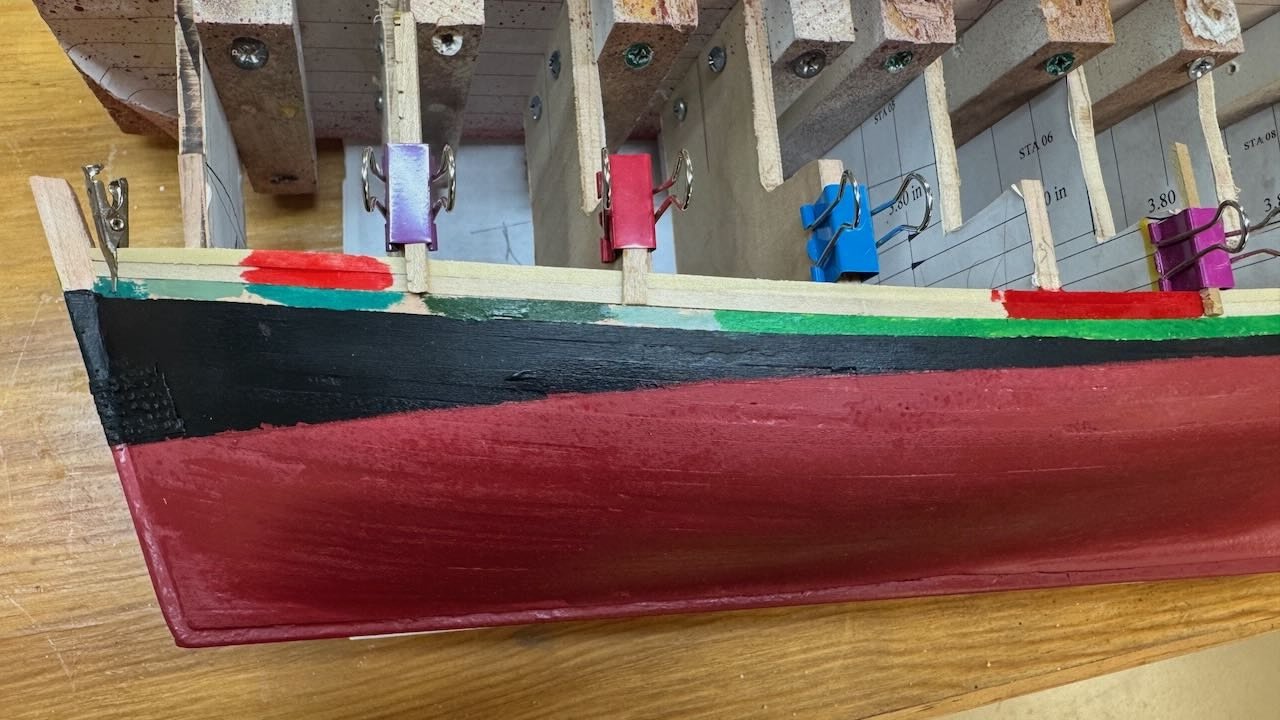

- 5 A parallel task is to build the rudder and its pintels.
- 6-7. first then, and then the second strakes set in place.

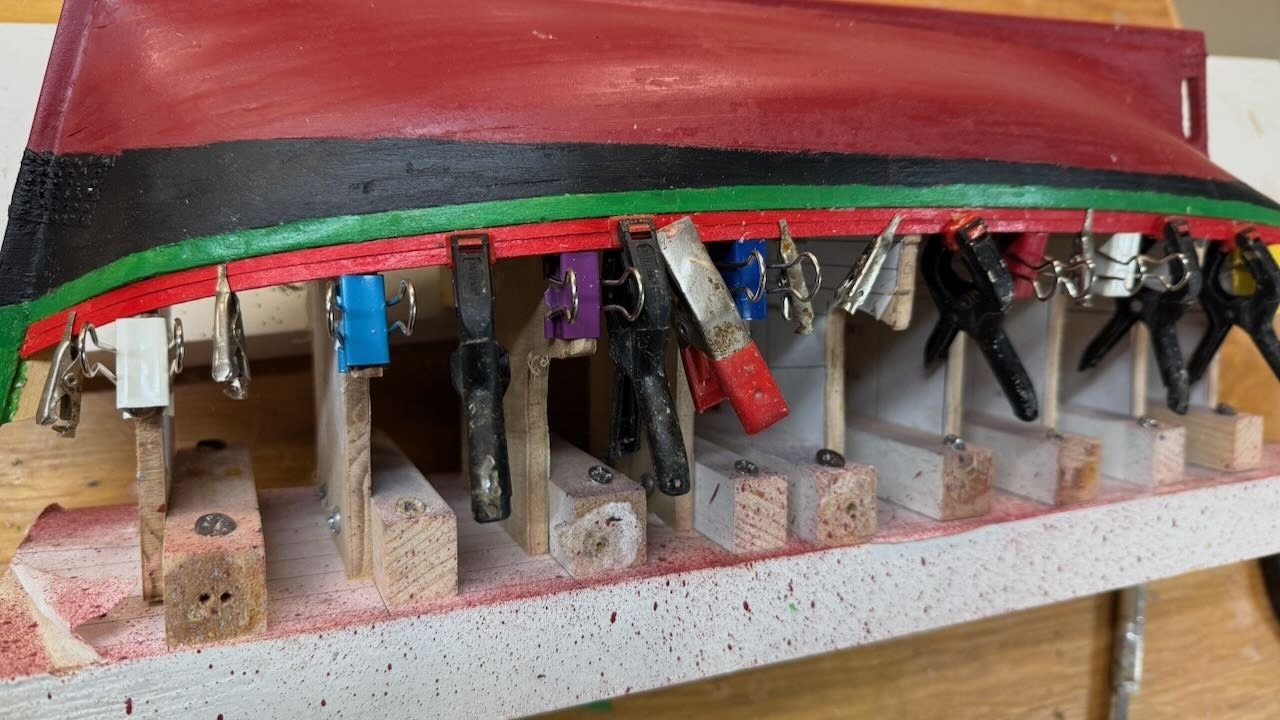
- 8-10 dry fitting the top green stake and marking the bulkhead for removal at the deck level.
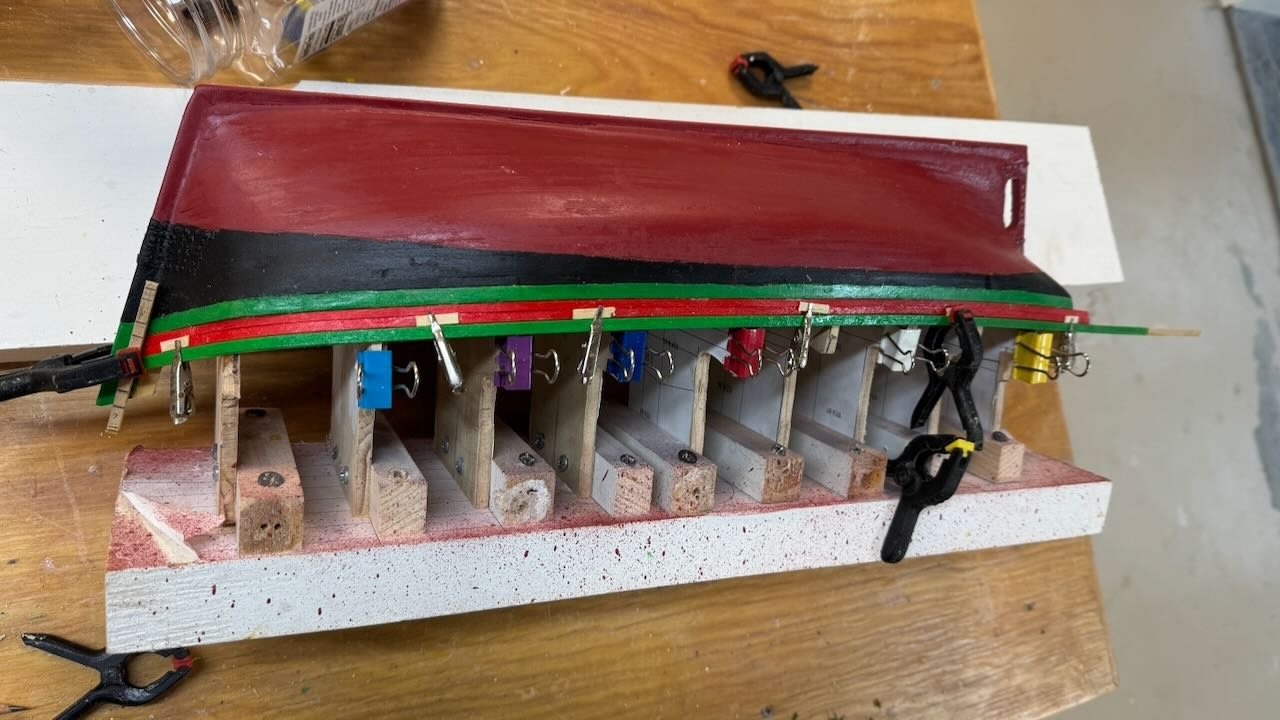
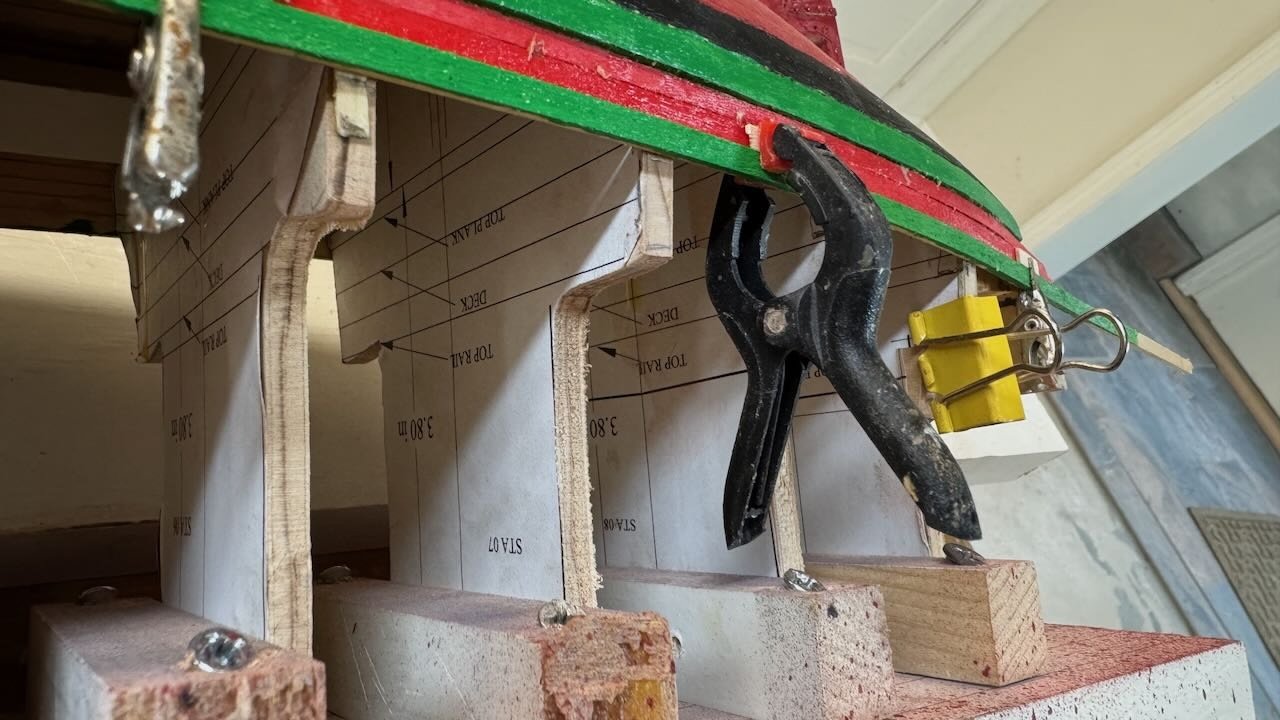
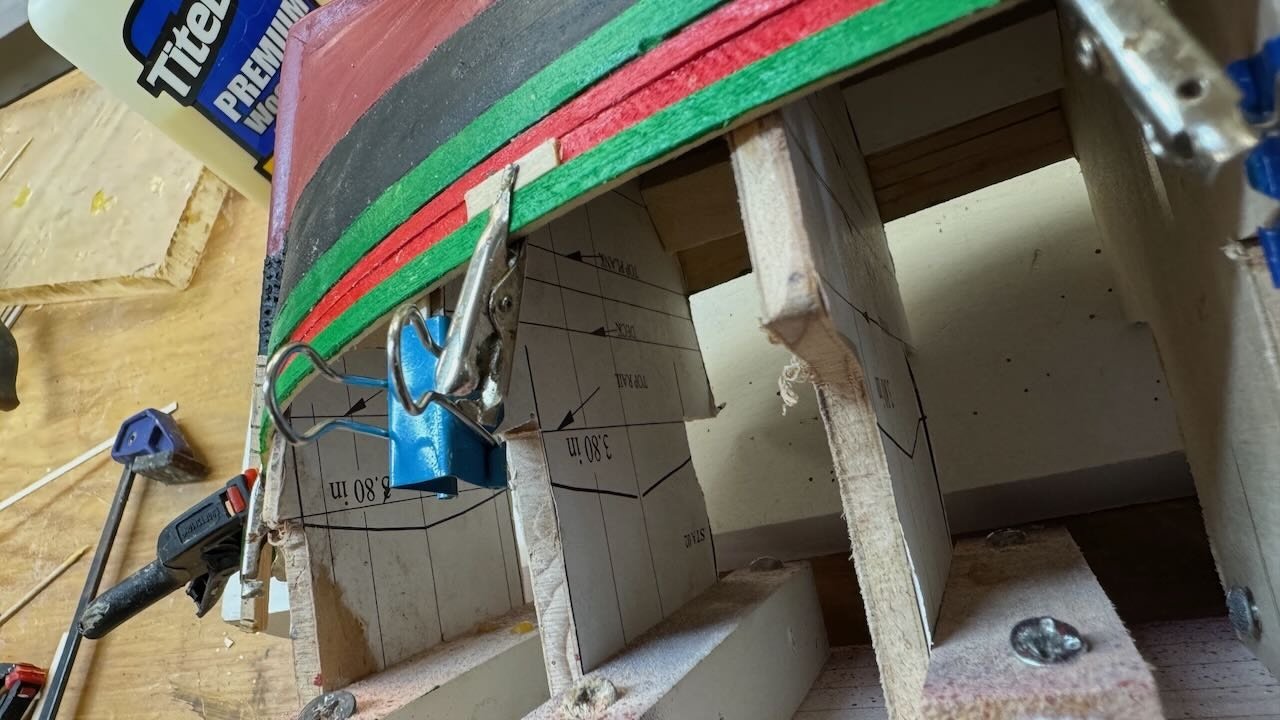
- 11-12 the bulkhead has been cut away above the deck line and the top green strake glued in place,
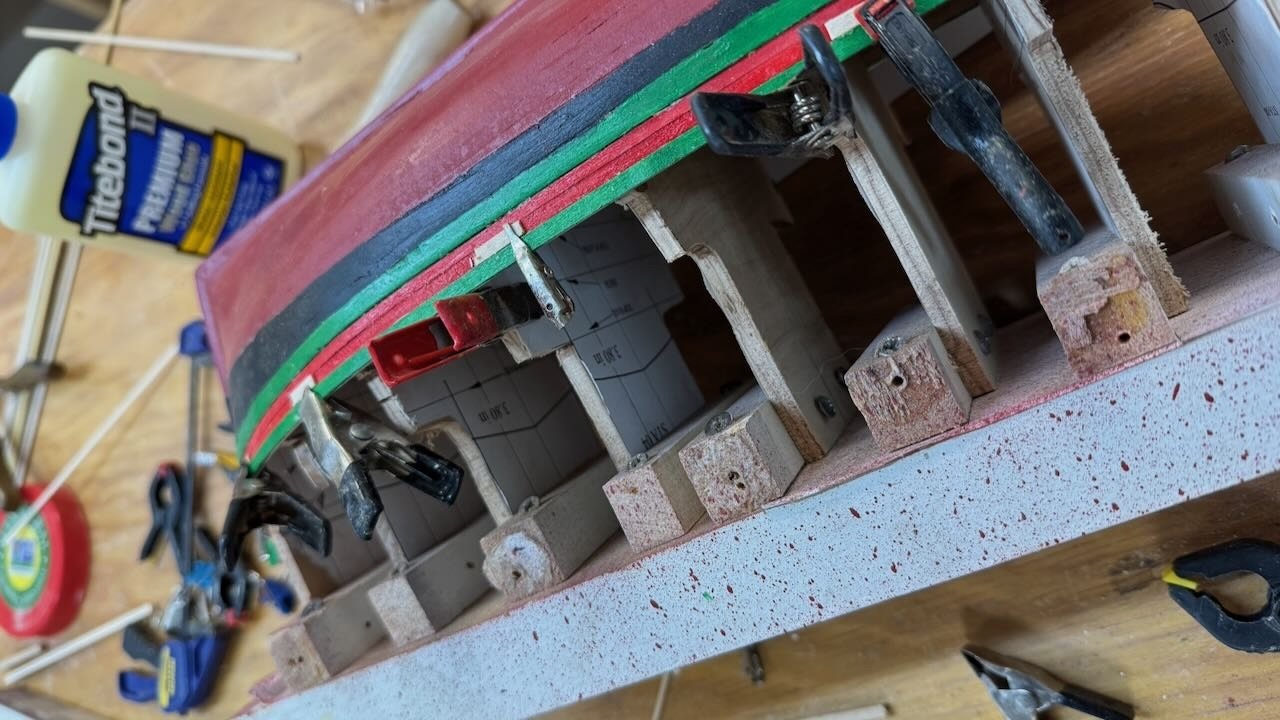
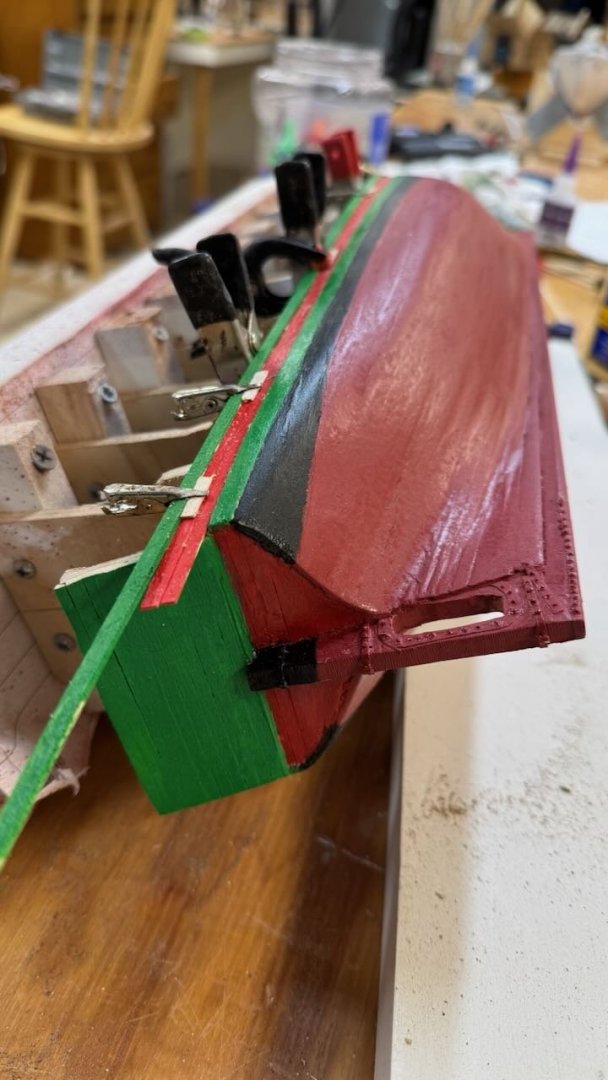
Next up is the port side . I will then plan to remove the jig to get ready for the deck. The shaer plank protrudes through the planking.All fun. I hope it works
- sheepsail, Cathead, Harvey Golden and 3 others
-
 6
6
-
Phil
What I use is one of many soldering tables I found on line several years back. I think I got mine from Rio Grande, but I'm not sure. Here is photo of one on line that looks similar I see several others and some a bit cheaper. I am a total amature when it comes to soldering or any metal work. That is one reason that I record my learning process. One major issue in these small pieces is holding them steady. These very rugged clamps are great for what I try to do making little fittings.
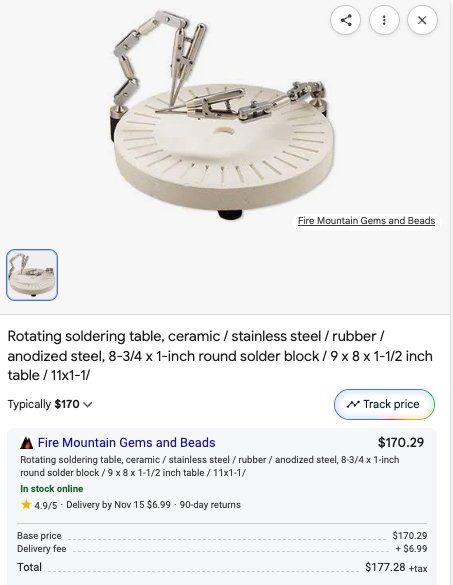
The soldering iron I bought online after watching a friend's blog from nearby in Maine. When I saw it, I bought it. I had found many of the electrical ones I tried just didn't get it and was using butane torch on everything.....too much for this size. ...this one does it quickly, so I am doing a little more each build.
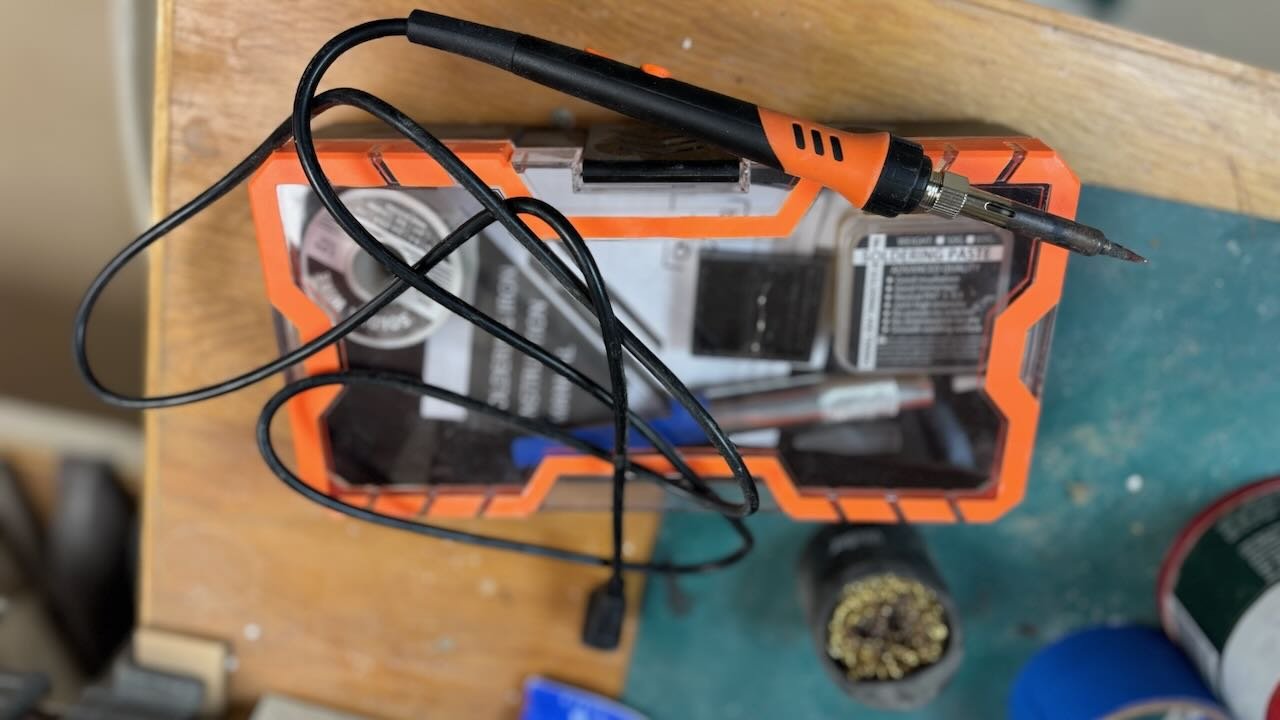
-
3b painting prep and firs paint
This update shows steps to get the lower hull ready and painted so I can removed if from the jig.
- views 7-8 show results of glazing putty repairs and marking of the waterline. the hull is wet as I just damp rubbed it to get off all the dust.
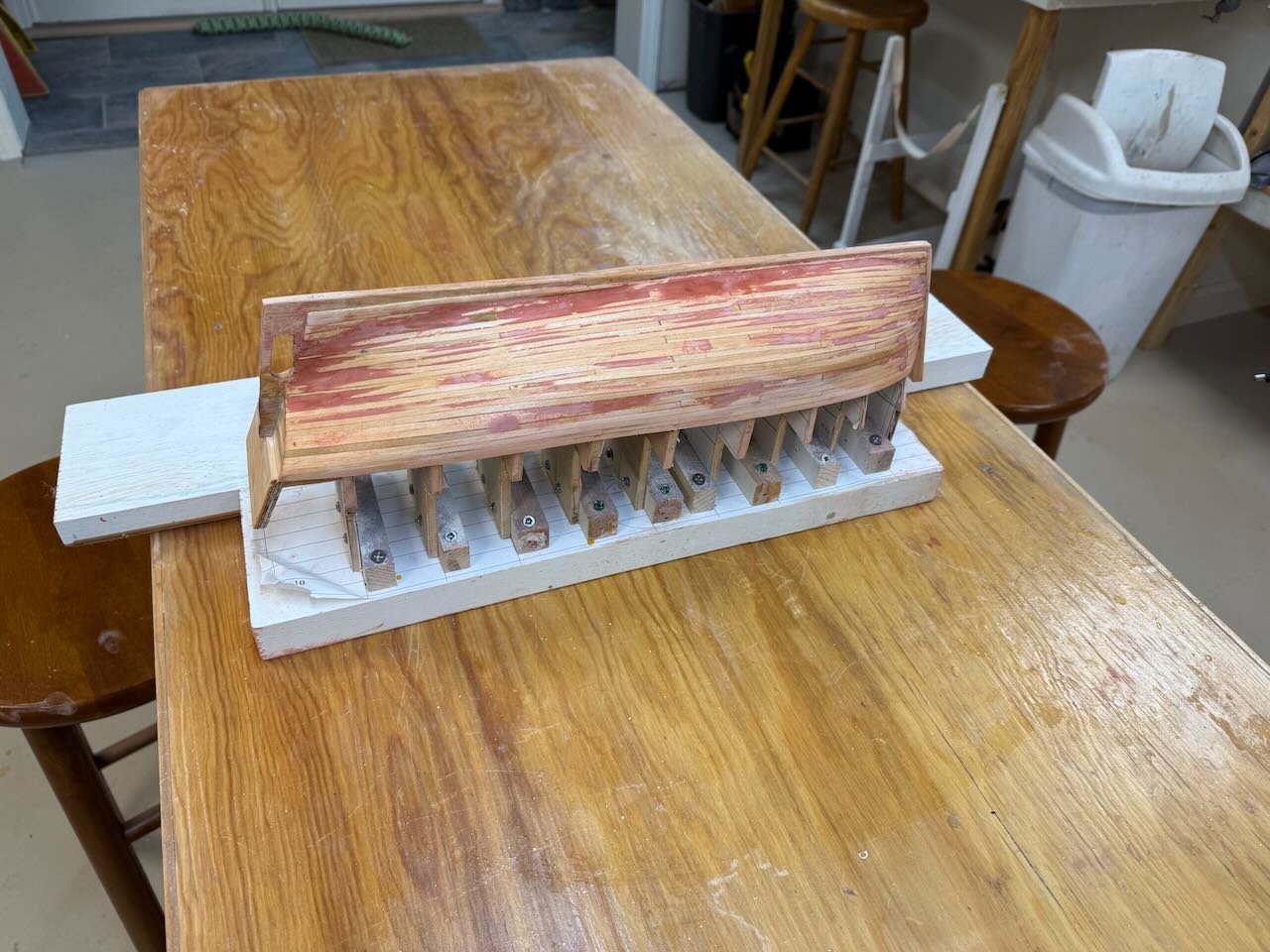
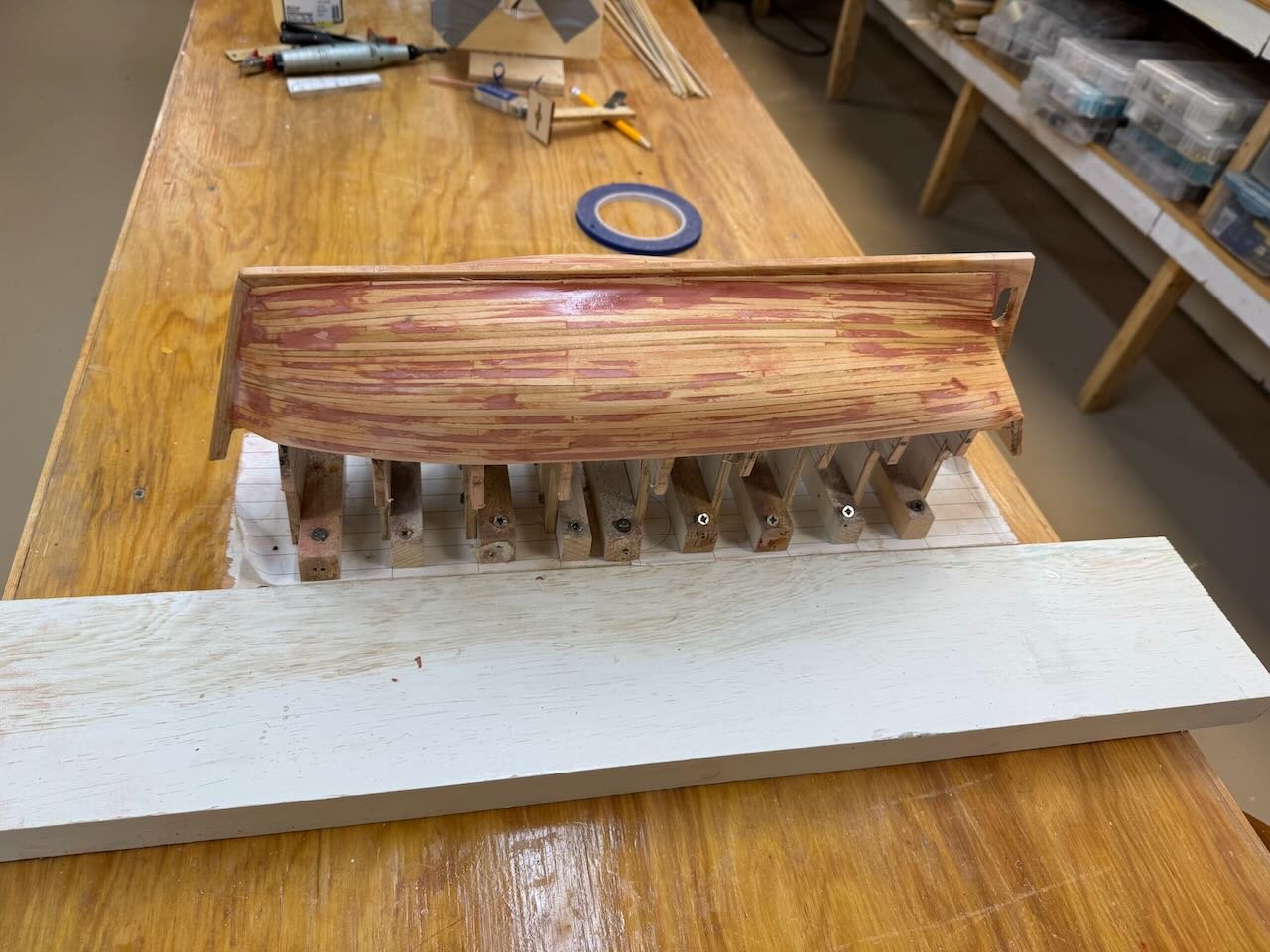
- views 9-11 show my low tech means to build the gudgeons in brass and the plates and bolt heads using mylar fishing line
- views 12-13 show taping out the black section above the water line and afyer painting it.
- views 14-15 show taping out to allow rattle can spray of heritage red for the bottom and "backside".
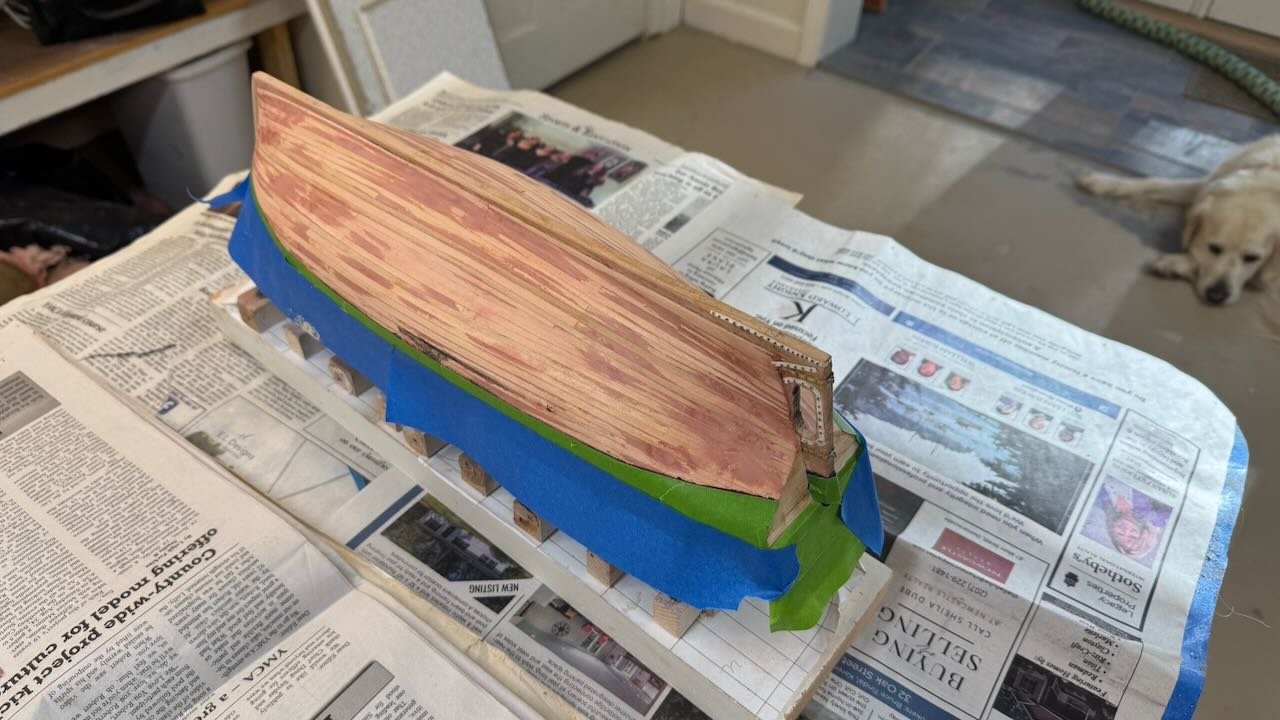

I mentioned earlier that I am trying to build this model without buying new stuff. As anyone knows, 12 years into retirement, our home collection of parts, wood etc. is ridiculous. The problem came up when I started to spray red with a can that has sat for more than a year, it wasn't pretty. We'll see in the next post how all came out.
cheers
-
3 lower planks are on …what’s next
Fumbling along I got the rest of the planks on for the lower section of the hull.
-
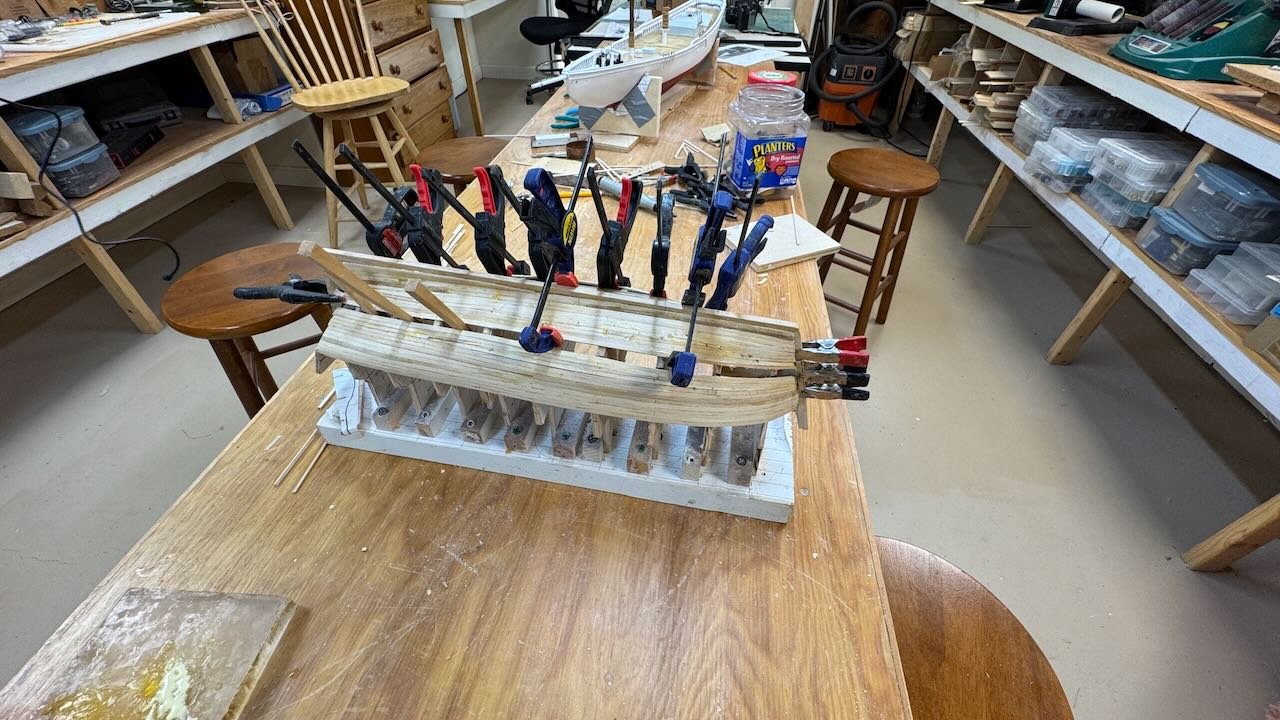
- 1 this view shows the joy when we get from clamps to wedges….I think that’s like getting to the red zone in an NFL Sunday.
- 2-5 The next four images are two sides presanding. I show the upside-down images as I will be changing away for the base board, needed up to this point, for the upper hull work as I have learned the hard way to cut out the building temporary bulkheads now. They need to be out of the way before trying to match planking and the deck line. Before that however we go to a challenge of this build.
-
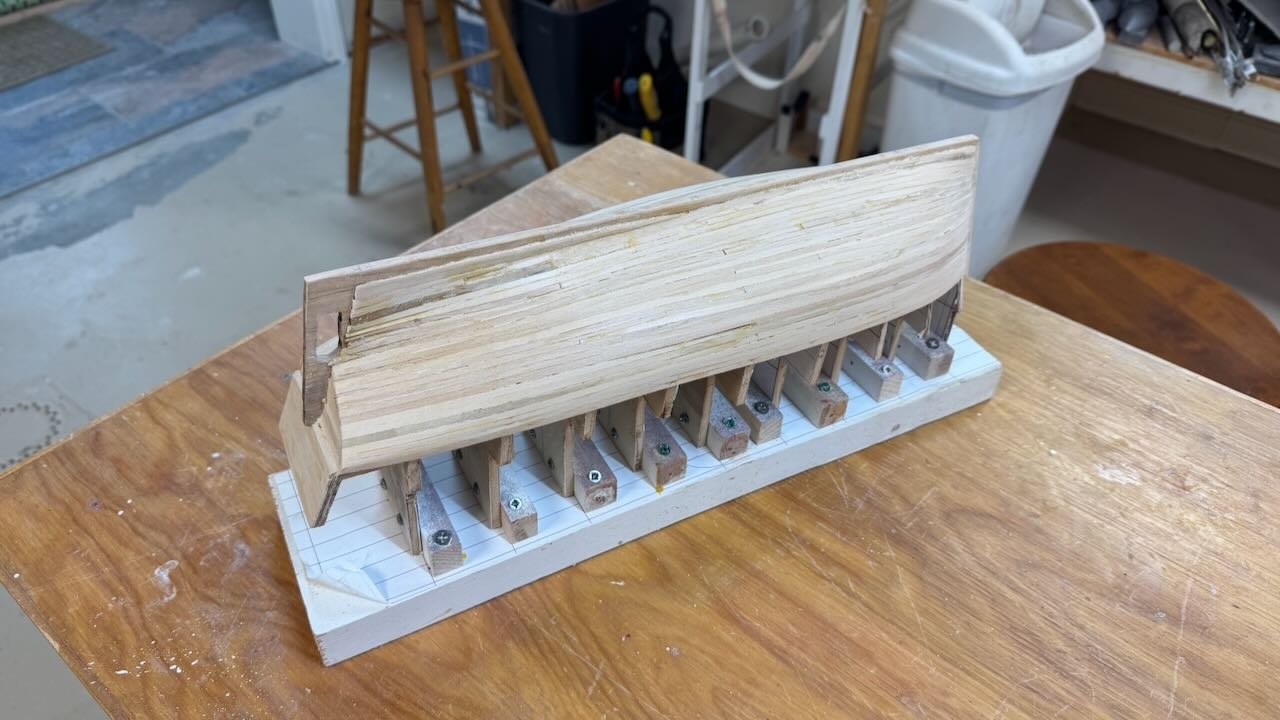
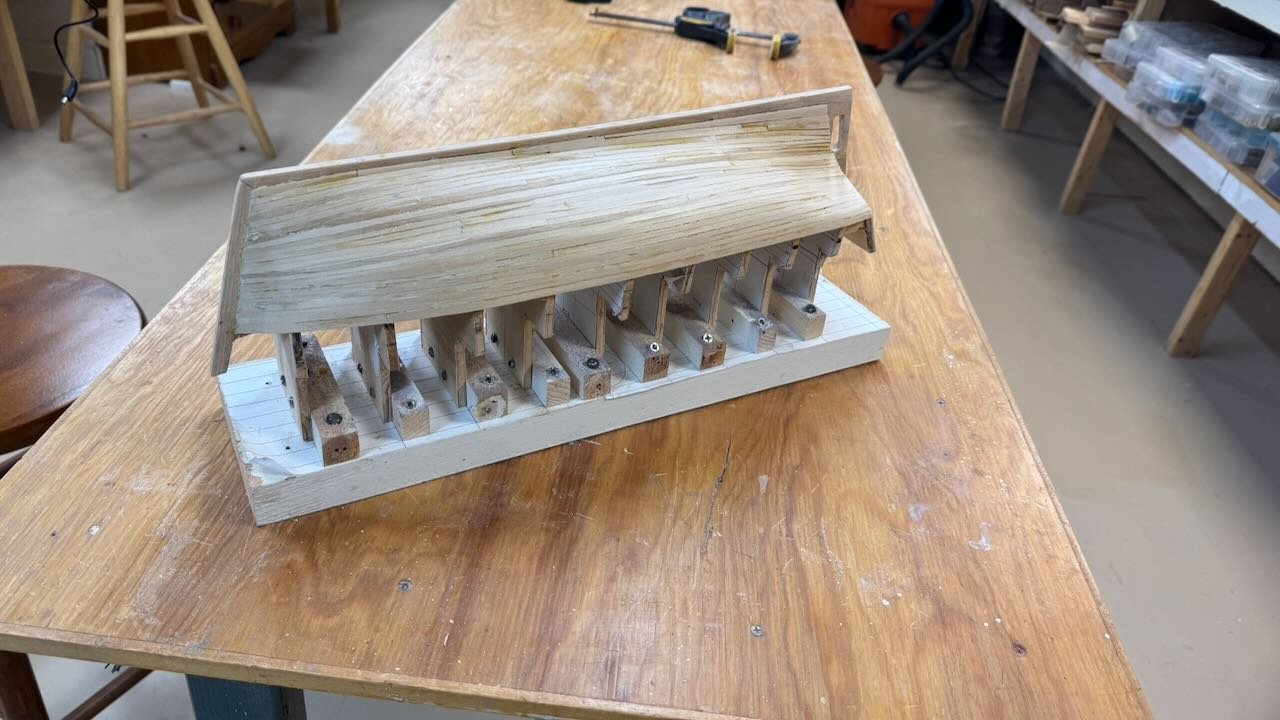
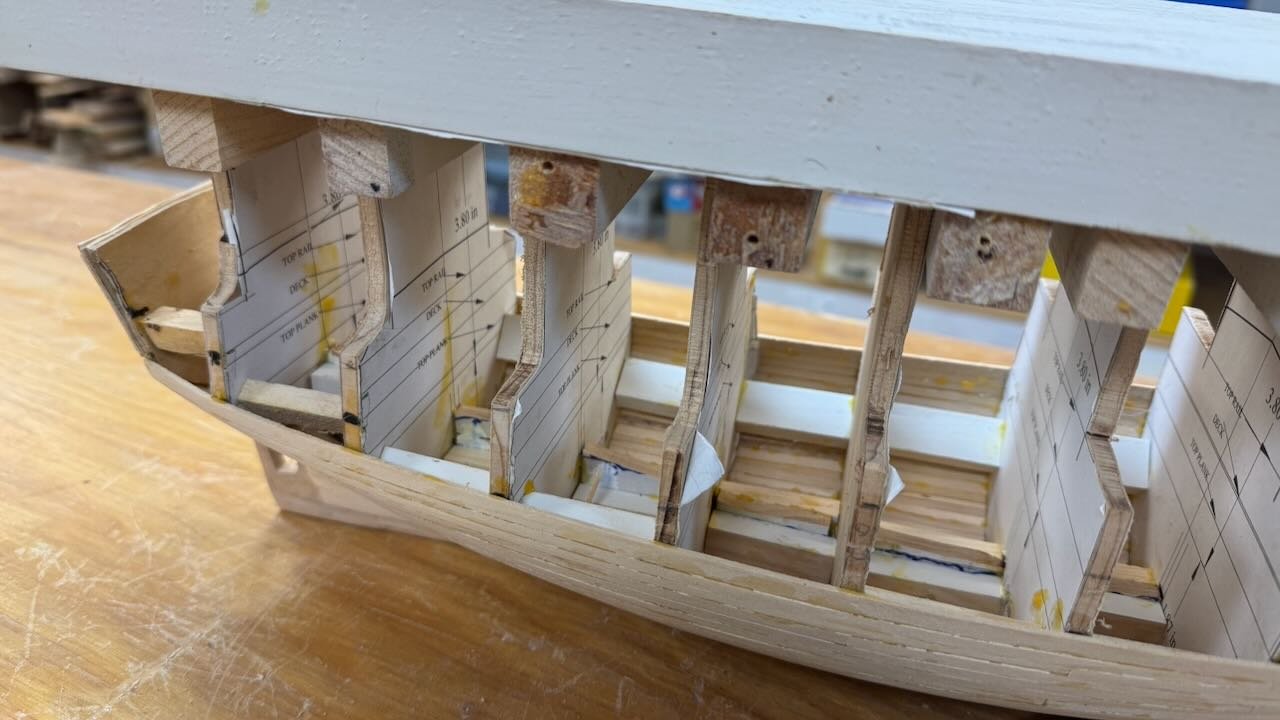
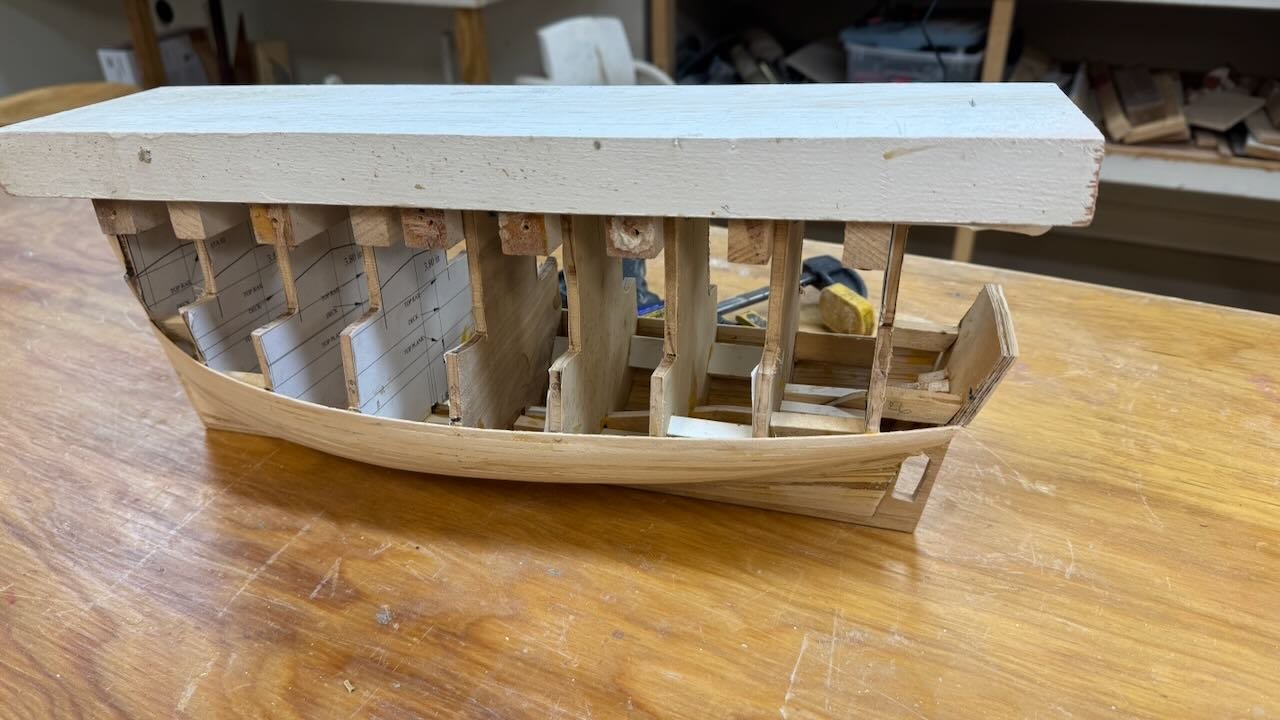
Painting. I like building Maine boats, One reason is they are typical either black of white. Gjoa is quite fancy and I need to stretch my skills accordingly.
- 6 The next image shows the hull in front of a Gjoa museum internet photo showing a nice detail of how to both planks and paint the upper hull. In the image below the top stake installed today will be green. when I go upward I will use two thinner strakes for the red then one thick green.
-

So I am off to the sanding and pre-paint prep to get the waterline on using the level benefit of the current build board before I remove it.
Cheers
-
-
3 partway through the planks
We had a little excitement last month when our annual Northeast Shipmodelers Guild show took place in Bath Me. We went this year to the shed associated with Maine's First ship. That is the reconstructed replica of the 1607 Pinnace built here,named Virginia, known to the be first European vessel built in America.-

- Here is their website internet image of her sailing from the shed
-
 Here is an image of Gjoa sitting with other of my collection at the show inside the shed. The idea was for all of us to bring models being worked on. The audience was lots of fun, some came for the models and others were waiting to go sail on Virgina.
Here is an image of Gjoa sitting with other of my collection at the show inside the shed. The idea was for all of us to bring models being worked on. The audience was lots of fun, some came for the models and others were waiting to go sail on Virgina.
Over the past several weeks I dove into the reading of Amundsen’s diaries of the venture across the top of Canada. Wow. What incredible people and how, according to Amundsen they all got along so well. Lots of fun sailing tales too. The gaff seemed to break several times, and the lack of wood was a big impact. During their third winter they were on a beach loaded with driftwood and the tried to replace it....more on that later.
Progress
- The next 7 images are the familiar porcupine type images of early planking and all the finagling we do to fit clamps.
-
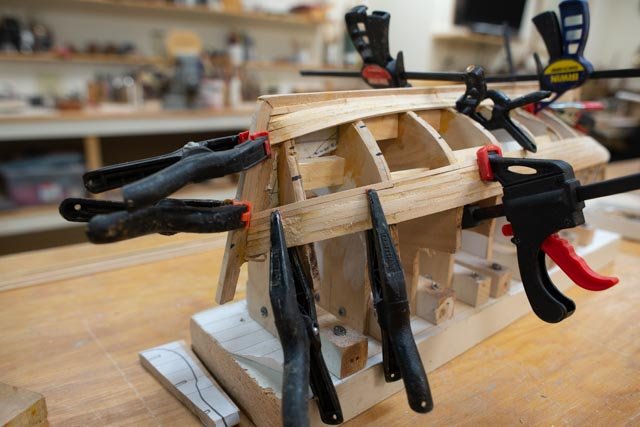
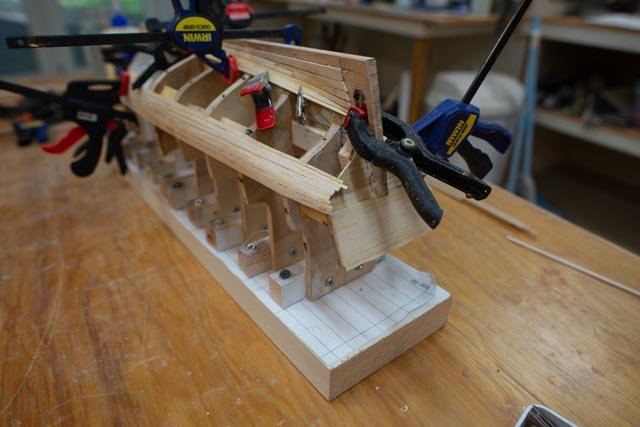
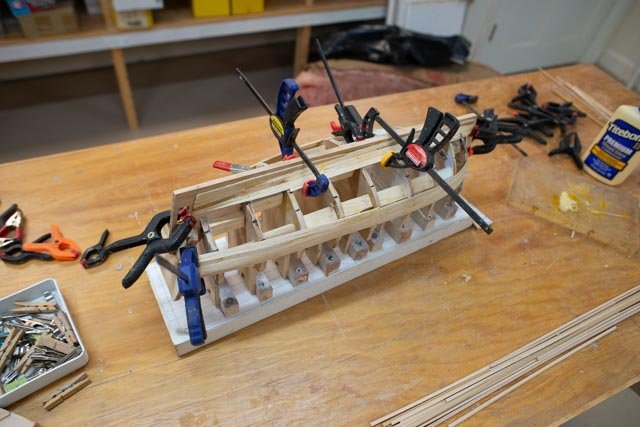

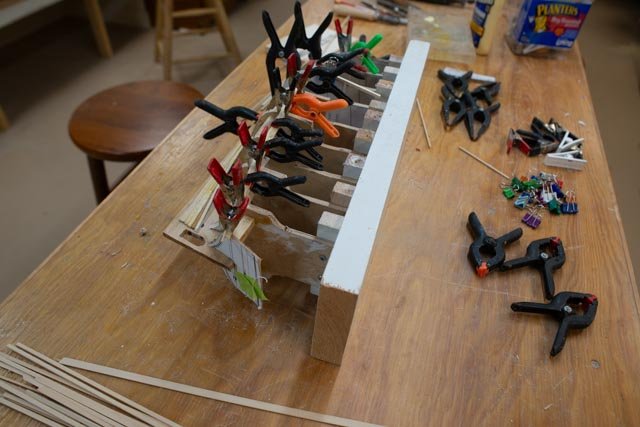
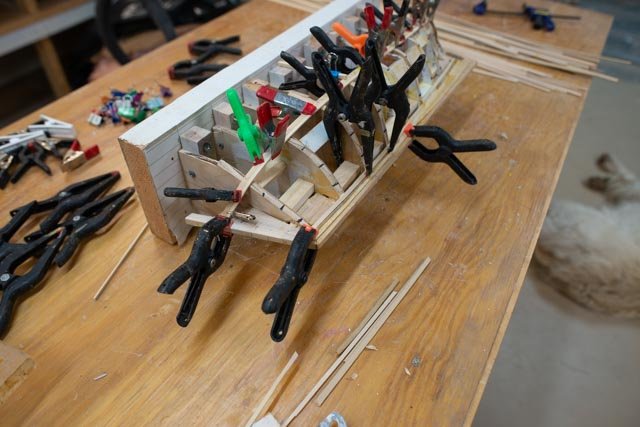
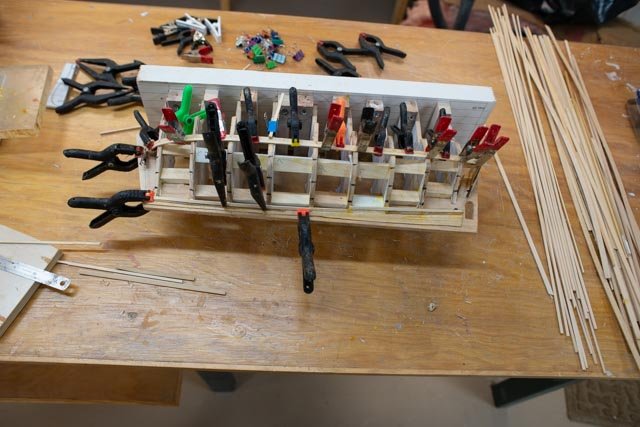
-
Here are two images while at a breathing point, when the first two bands are done and planning the tough center ones commences. Since this is a painted hull, I am milling a few types of scrap wood. most of the planking is cut down bass wood, but a few maple planks are in the stock.
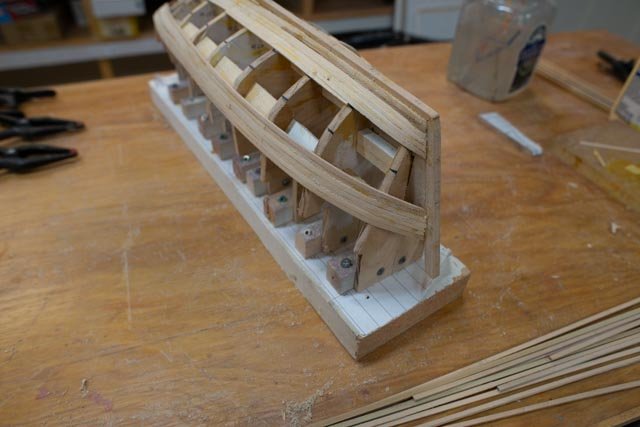
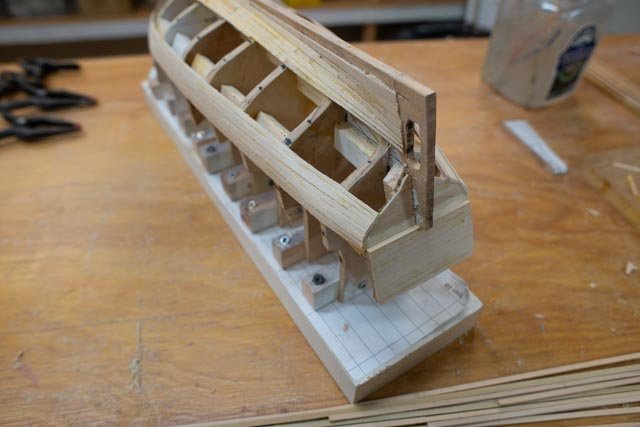
- tarbrush, Cathead and JacquesCousteau
-
 3
3
-
-
-
12. we are back to work
This update is to celebrate the resumption of my build of this fun schooner. During the past year I diverted into the arctic where half of my current and near future builds are planned. I hope to continue in parallel with arctic stories and vessels and the Boothbay region shipyards, stories and vessels. The real live full-size work in our town this year is the rebuild of the vessel Niagara from Erie Pennsylvania. I have been down several rabbit holes over the years following the Ernestina Morrissey and Bowdoin rebuilds but have chosen not to focus on this area. I will visit a few times and what I learn I will share on whomever has an open log. She is quite the popular vessel, so I am sure I will find one.
The first event that got Elizabeth Howard off the shelf was our annual model show in Bath, Maine. This year we moved to the shed that houses Maine First ship, the 1607 Pinnace Virginia. I stood up the masts and added a few shrouds just to have some visible change. The intent is to include models that are being built as a part of the show. In the view below she is among several other builds and anxious to return to the shop and not to the shelf.
In my posting of last year, I showed the photos that I am using to figure out how best to show the deck. My current activities include adjusting things to better fit the dimensions that I have extracted from the photos.
-
 2 here is image showing a printout of the fore deck photo with hand measurements. It’s very low tech as the view shows the dimensions on the photo compared to the 11 inches bow to foremast. I also realized that the foremast head stay is not going to the samson post, so I needed to move that aft and then, like on other schooners, rig an iron loop from deck structure around the bowsprit to take the load of the lower foremast stay. I also have rebuilt the bowsprit so it can now come aft to the samson post near the windless.
2 here is image showing a printout of the fore deck photo with hand measurements. It’s very low tech as the view shows the dimensions on the photo compared to the 11 inches bow to foremast. I also realized that the foremast head stay is not going to the samson post, so I needed to move that aft and then, like on other schooners, rig an iron loop from deck structure around the bowsprit to take the load of the lower foremast stay. I also have rebuilt the bowsprit so it can now come aft to the samson post near the windless.
Next up is the windless and its machinery. Probably 10 years ago I bought a “fisherman windless kit “ . It has been sitting in a box all these years so now is the time to use it.-

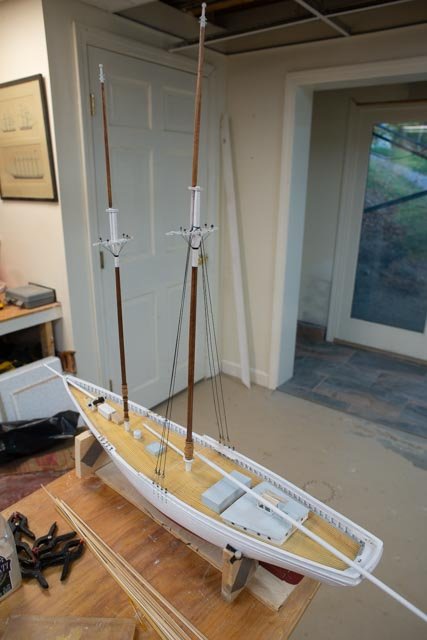

- 3-5 here we see first setting the main mast and rigging the shrouds. One can also note my arctic build Gjoa is at the far end of the worktable, so I can divide my time. The other two deck overviews show where we are starting, with the kit windless in place……. something is just not right
I find it is missing a key ingredient, a direct drive wheel to connect to the donkey engine that surely would have been there. Looking even more closely to the photo above I see what I wanted to see; a second set of bitts just forward of the engine box, very fuzzy but clearly with a flywheel. So, borrowing experience from my schooner Bluenose build, I went ahead and had some fun.
Here is my low-tech approach to adding a drive gear to the barrel. These 4 images show:
-
 First attempt to simply cut the “barrel and drill a hole to receive an extended shaft to hold the gear. This was an oops
First attempt to simply cut the “barrel and drill a hole to receive an extended shaft to hold the gear. This was an oops
-
 Second attempt when I realized I needed to shrink down the spool to make room for the gear drive.
Second attempt when I realized I needed to shrink down the spool to make room for the gear drive.
-
 Drilling the winch to receive the other end of the shaft
Drilling the winch to receive the other end of the shaft
-
 Using the drill press to carve two new winches
Using the drill press to carve two new winches
-
 And here is the partial reassembly.
And here is the partial reassembly.
I will need to add some chain and the breaks for the anchor windless. One of the details I like in this option is the second windless is obviously a higher speed than the big windless barrel and more reasonable for raising sails.
All for now I am just happy to have at least started again.
- ccoyle, JacquesCousteau and Colin B
-
 3
3
-
-
02 Starting the reading and preparing Drawings
In preparing for my builds there is always a lot of fun reading. I just added about 8 books to my library, [ it's like stacking fireplace wood before winter] and I am sure more are in the wings. I got the Fram Museum illustrated diary of Amundsen’s voyage through the passage, a joy. I also bought the two-volume reprinted [ English] diary that Roald wrote. The publisher printed it in the faint broken font of a 1910 typewriter. What funThis build is but a chapter in the tale of the Scandinavians. I believe my tale will include:
• Nordenskiold on the Vega making the Northeast passage 1878 to 1880
• Nansen- Sverdrup [FRAM to be another build but same story} 1893-1896
• Sverdrup FRAM. Canadian Arctic 1898 – 1902
• Amundsen Gjoa Northwest passage 1902-1906
• Amundsen FRAM Antarctica 1910 -1912
• Sverdrup/Amundsen Maud 1917-1926Before deeper study these are my understood points of reference. Mostly from other reading or recent internet sources. I hope to expand my understanding though this winter as I build the two models.
- Nordenskiold is our starting point. There is some cross reference as Sweden and Norway were not separated until 1905. My reason to pull this story in is the geographical relevance, but more to our mission, a study in the evolution of active exploration vessels. The Vega was a steam powered bark, a Sealer. She was launched in 1872. Many of the vessels used by explorers up through 1913 included a wide selection of similar whaling/ sealing steam powered barks. Robert Peary used them, including the Winward which the year before had recused Nansen from Franz Josef land. Greely and Hall used them 1860’s to 1880's, and MacMillan used them from USA up through 1913 and found much difficulty. He was finally rescued by Robert Bartlett in 1913 after being in Etah, Greenland for 4 years.
- Nansen understood the effects of ice on the hulls though over wintering, and FRAM was all about the shape. She was quite successful. The fact that Amundsen not only took her to the Antarctic but used her design for the third vessel Maud speaks to the correctness of “fit for purpose”.
- Gjoa was a 1872 Norwegian fishing sloop [ cutter rig ]. Amundsen understood the need for less than 10 feet of draft, and a small profile to be able to maneuver through the narrow and shallow inshore passages which he both expected and indeed did find. He had a new type 13 horsepower engine that could burn many things. I hope to learn more about it. I look forward to the details by reading his diary.
Off to the drawings.
There are several exchanges in the MSW logs about drawings for these vessels. The models of Gjoa are apparently not currently available as kits. Dialogues suggested that the Model Shipways 1950 vintage drawings for their solid hull kit were even better than the expensive ones from the Oslo museum. I found an old Model shipway kit on eBay and thus I have a set of prints.
Scale….I plan to build this vessel at 1:48 as that is the same scale as my Schooner Bowdoin. I will show these vessels side by side as an extended chapter. It will discuss the influence of this little gem of a vessel and its impact on MacMillan programing his schooner in 1920.The scene….it is too early now but starting out I think it be good to show her moored in ice /water as she spent over 14 months in what today is Gjoa Haven, Nunavut.
Working
To change the scale of the drawings I scanned the lines, added them to TurboCad…simple 2d cad… and traced out the stations and what I call the “keelson” assembly.- The first 3 images show the Turbocad effort. First is the rescaled line drawing followed by a typical station layer. I added lines to mark the top plank [ planks are thicker below this line][ then the deck and the top rail. The 3rd image shows the transom that needed to be stretched to accommodate the angle of the transom from the vertical line.
- The next two images show the keelson drawing rescaled in front of the old kit box. Not sure what I will use the hull for and all the other stuff all went into general supplies. The stations are all printed out and glued to 4mm plywood.

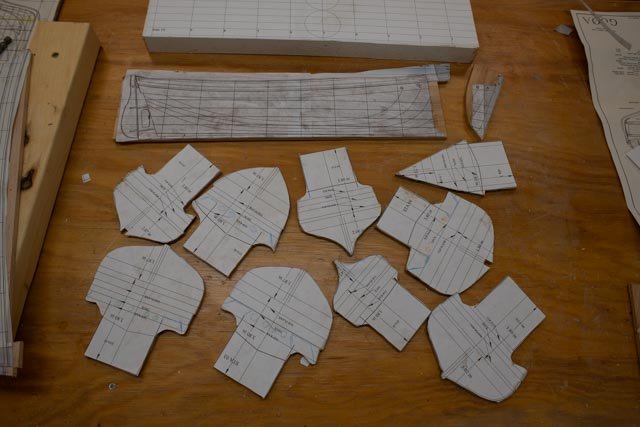
- The next two images show the marking and cut out of the keelson assembly. I used a maple blank for this piece. The paper plan is glued with kids glue, so with a simple brush of water it will all come off.
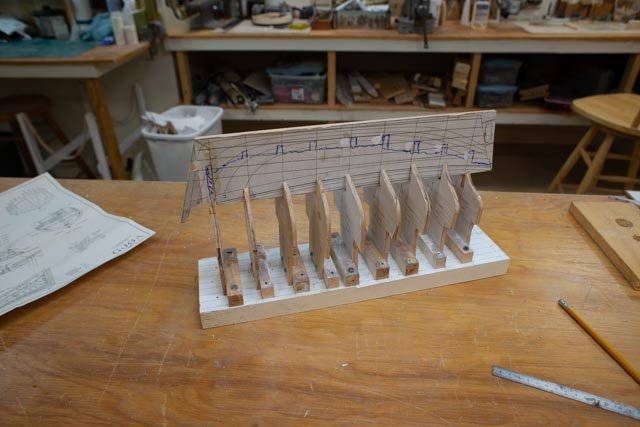
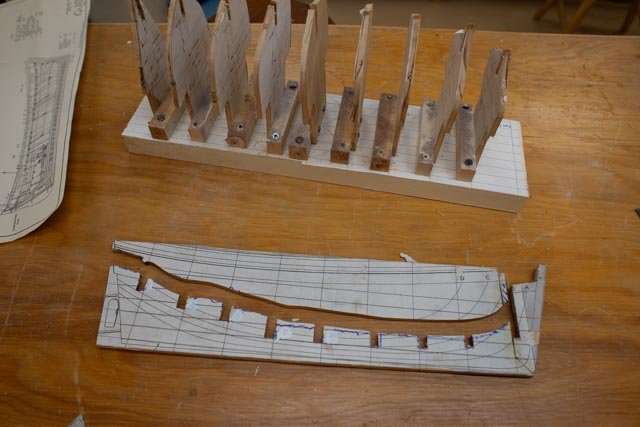
- The final three images show front or back views of the glued stations and then the overall with the outer blocking supports.
-
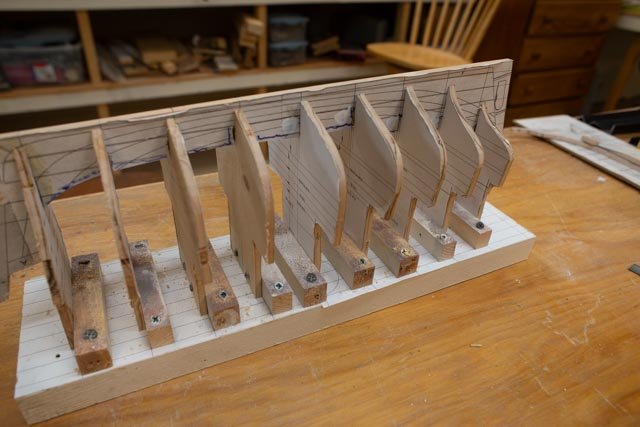
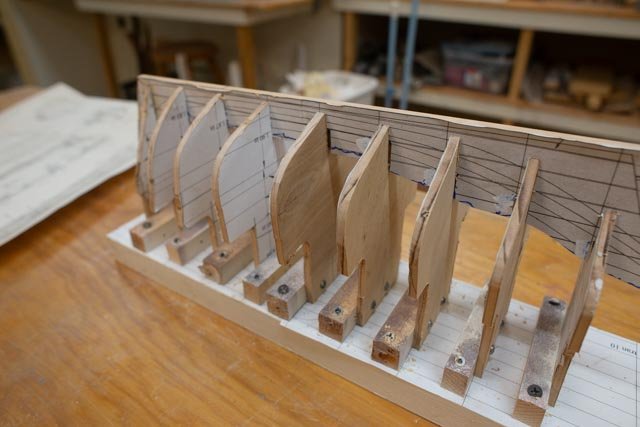
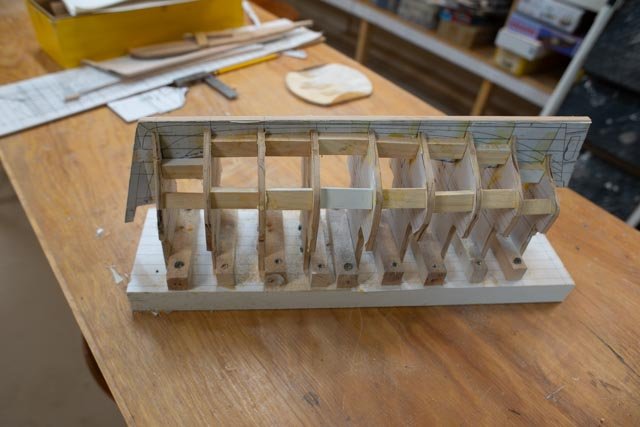
Next up is a slower process...it is all the prep needed before planking
- Cathead, Harvey Golden, tarbrush and 1 other
-
 4
4
-
Just a postscript.
First…Where does one keep a diorama of this size?
Here we are in the study. Perhaps it is now the arctic room. Not sure if this is sustainable but it's good enough for now.
Second… I was asked to give my talk a second time and wanted to avoid carting the big diorama around. I made up a few slides to focus on the story. I just wanted to save them into the log.
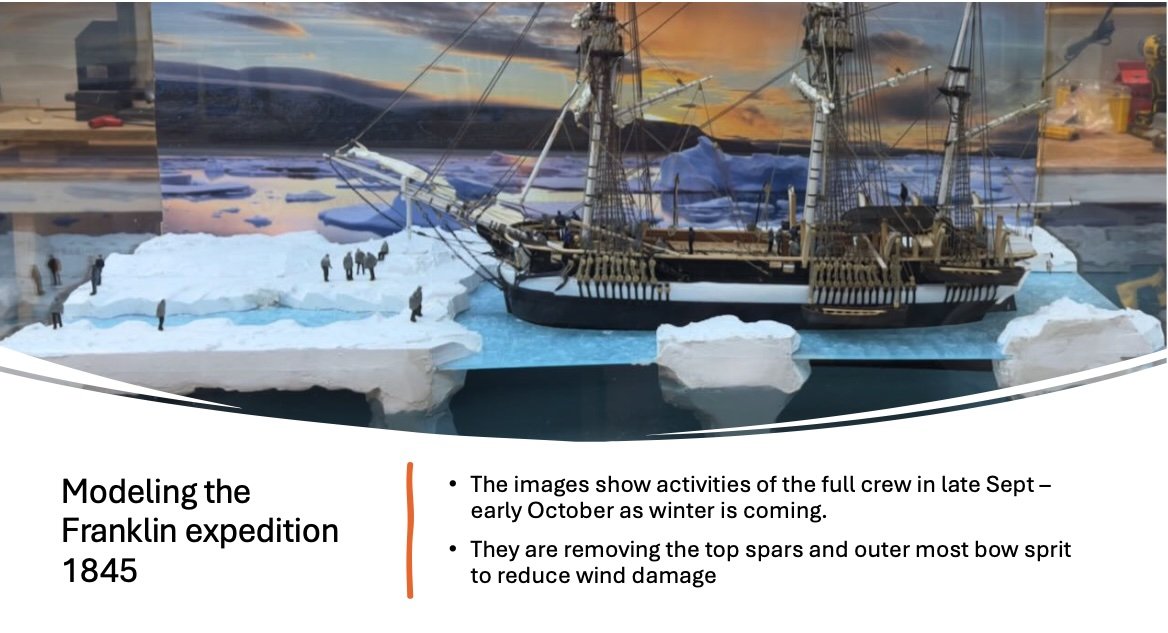
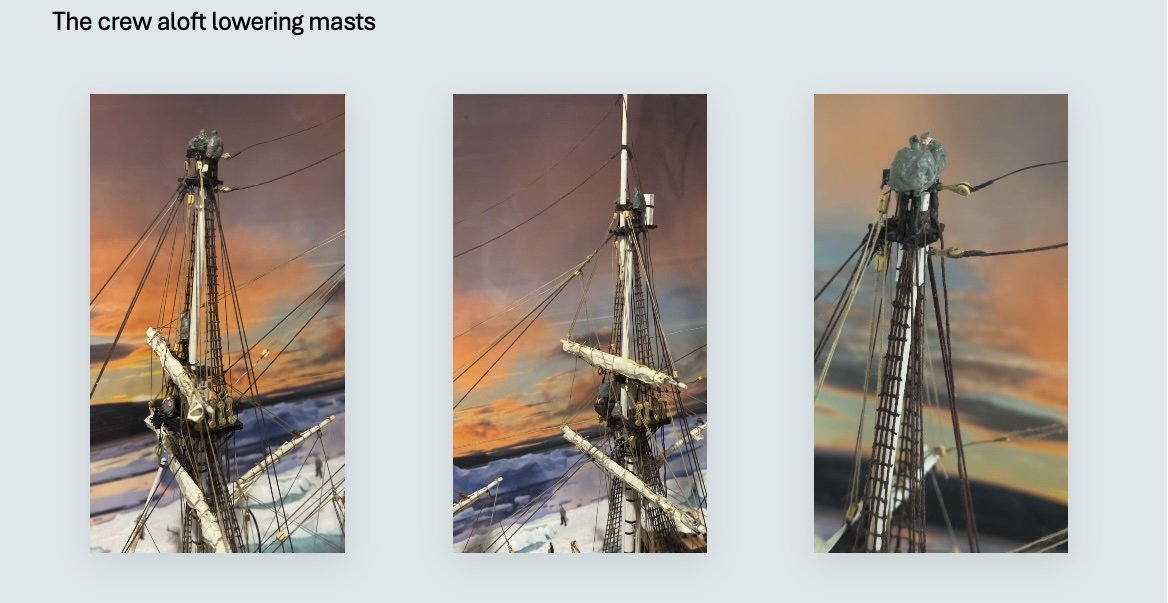


Thanks all ... this has been a journey
Jon
-
01 The Beginning.
This build is the first of three I plan for the next series of stories. Over the next year, I plan to return to Greenland via Iceland following the Viking trail. That is to the best of my knowledge the beginning of the story of European explorers. To Complete the story of the Northwest Passage, begun with my recent build HMS Terror, I will have two Norwegian builds, Gjoa and Fram. Finally, my last of three builds will be to go along with my planned trip to the Greenland settlements. I will build a Viking vessel. First up will be the two Norwegian vessels. Fram will be a kit build and follow this scratch build of Gjoa. So let’s get to it!The cutter Gjoa was the ultimate winner in the search for a sailing route through the Northwest passage. I first learned of this vessel several years ago while studying the life and times of Donald MacMillan and the schooner Bowdoin. The Schooner Bowdoin was built in our town here on the Maine coast in 1921. That story is with my build of Bowdoin that I display as a diorama showing her second overwinter experience in the summer of 1924. In the story of MacMillan’s early life, and the issues that led to his having the Schooner built to his specification, was his research into other experiences. He was fascinated with the Fram story of a round bottomed vessel designed to survive mid arctic ocean ice. He also realized after all of his personal experience, that Amundson got it right when he chose the small sailing vessel with its auxiliary engine to find his way through. The relationship of Macmillan study of these two vessels demonstrates the value of their design.
By example, Admiral Peary had MacMillan with him on his last venture to try to get to the pole. Their vessel the Roosevelt, built in 1905 at Bucksport, Maine, was quite different. It was quite big and powered by a 1600 horsepower engine. It had in Bob Bartlett a great captain to smash their way up through the Kennedy and Robeson channels to the shore of the Lincoln Sea on the North coast of Ellesmere Island. They got there yes, but when they returned to New York the following year, the vessel was in sad shape.
Gjoa did not smash its way anywhere. She was the right size to squeeze through the shallow inshore waterways south of King Williams Island. After staying in Gjoa Haven for two winters and spending one more winter further west, she sailed into San Francisco harbor as a hero.There are other builds of the vessel and a current one that is a must read for both research and beautiful craftmanship of this vessel. My build is once again to build a prop for telling a tale. I am scratch building it in the same scale as the Schooner Bowdoin, so they can sit side by side and one can appreciate the comparison. One tale will be about Gjoa and Fram and their influence on Macmillan and the other is of the great man Amundson at both ends of the globe. As I understand it, he took Fram South in his race against Scott to get to the South Pole.
Time to chase up some drawings.
- Paul Le Wol, tarbrush, Cathead and 3 others
-
 6
6
-
Chris, Keith, Greg
Thank you for your kind comments.
Greg
the lathe came from my past brother’s shop many years ago. He had bought it as a combo that sherline offered. One removes the lathe motor assembly and connects the mill “stock” assembly including its motor. I am able to switch back and forth. I also have a normal midi lathe and except for tiny things too small for the midi, I mostly use the sherline as a mill. My brother scratch built some 25+ steam engines. I on the other hand have yet to machine any metal parts. I really valuable it most when drilling tiny holes and am concerned about where they end up. 🤓A small drill press is great, but i find it harder to drill fife rails and the like. Small holes through spars are easier too.
i have a friend who is an excellent machinist, and he has been working on me to shape some brass fittings. My next scatch build is Gjoa and maybe it’s time for me to try.
- clearway and Greg Davis
-
 2
2
-
19….the end
After a few months of resting on the bench and summer activities taking over my time, the punch list didn’t really get done. I also did not find the right adhesive to attach the black corners to the case. I picked her up and took her to the Yacht club for the summer art show, and then a few nights ago, I gave my talk on the general history of the Northwest Passage explorers and the vessels. The model showing HMS Terror laying at Beechey Island getting ready for winter was featured. My talk also covered highlights of how today one follows the path of the Franklin expedition.
The images show her resting at the Yacht club after the art show, I was traveling in New Brunswick and missed it. Then she was in the lobby advertising the talk....Tracing the Northwest Passage.

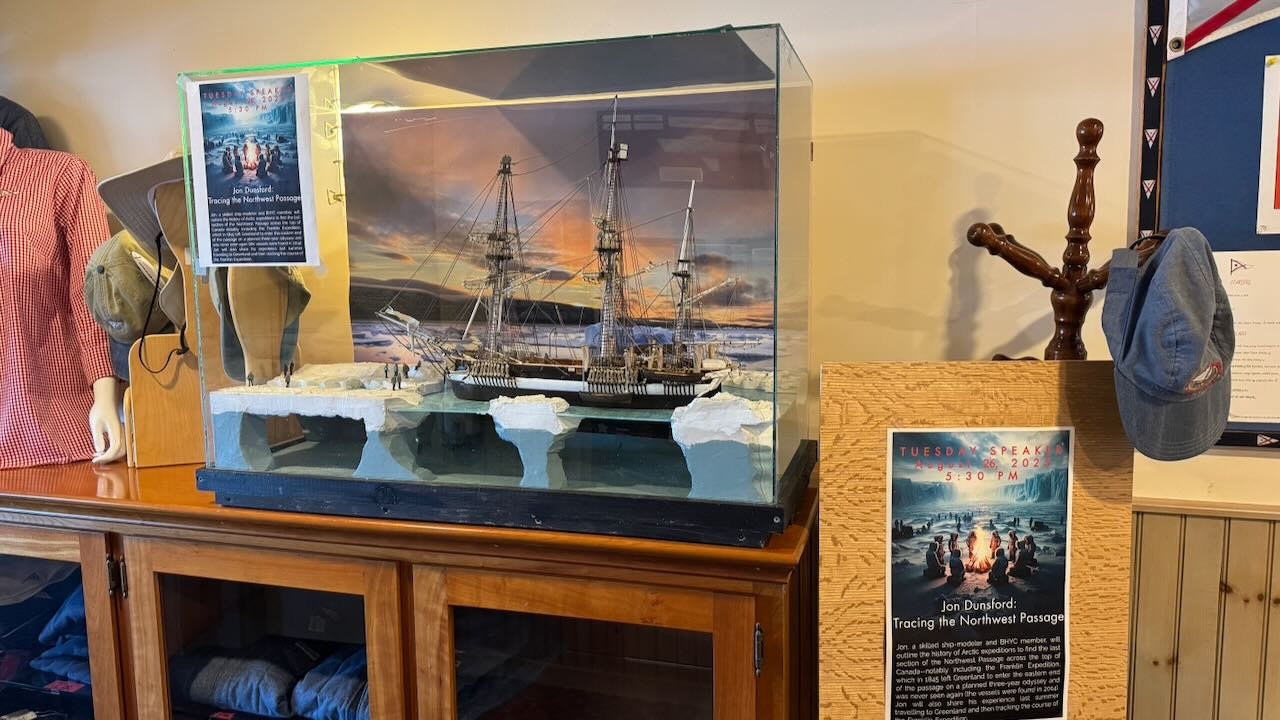
So, to the future. I will be next focusing on the two Norwegian vessels Gjoa and Fram for new builds, the first to be scratch and the second a kit. I also need to return and plug away at the Schooner Elizabeth Howard. And truthfully, I need to find a place for this huge box of a diorama. That is currently a mystery. I still have the alumnum strips and some day I will attach them. I also have the remaining soars and things to place on the deck. Our Guild has a show at the end of September in Bath Maine, and that will be fun too. So, Terror may rest , but no rest for me I guess.
cheers
jon
-
Keith
one thing that should be said move often is that your sense of photography makes reading your updates extra valuable. I really look forward to seeing your work as time goes by. I have learned a lot from it. Another of your fine lessons is the sense of sequence. Getting all of ths tie off points in place early makes so much sense.
thank you for sharing so well!
Jon
- clearway and Keith Black
-
 1
1
-
 1
1
-
18. almost done; Setting crew, building a case and working off the punch list
It has been a while since any real progress was made as spring finally came and outside work took over. I need to get the diorama ready to go for show and tell in July, so I’m back to work.
-
1

-
I took her to the local Guild meeting in May and posed a few questions. Happily, I receive some good answers:
- • the footropes on the yard arms would have been lines and removed, or as lines been inconsequential as to being stored in the racks on deck. I should remove them all and then store the two top gallant yards, along with some spare blanks.
- • How to build a case. Buy green Optix at Home Depot or Lowes. The Optix green means the edges are green and it looks like glass. The cost is about $50 for each 24”x36” piece. Then follow U-tube to see how to weld them into a box.
- • Support for my opting out to attempt to paint of wash or fool around with coloring within the ice, since the back lighting is early morning. I am no artist and the white with more added snow will be just fine…..I hope . I can always change my mind.
- • I had about 10 crew on board, and the group all agreed that more crew would add to the story.
So after much yard work, and a detour to cut down two previous dioramas that are too big sit on shelves. we are back to work.
-
2-3.
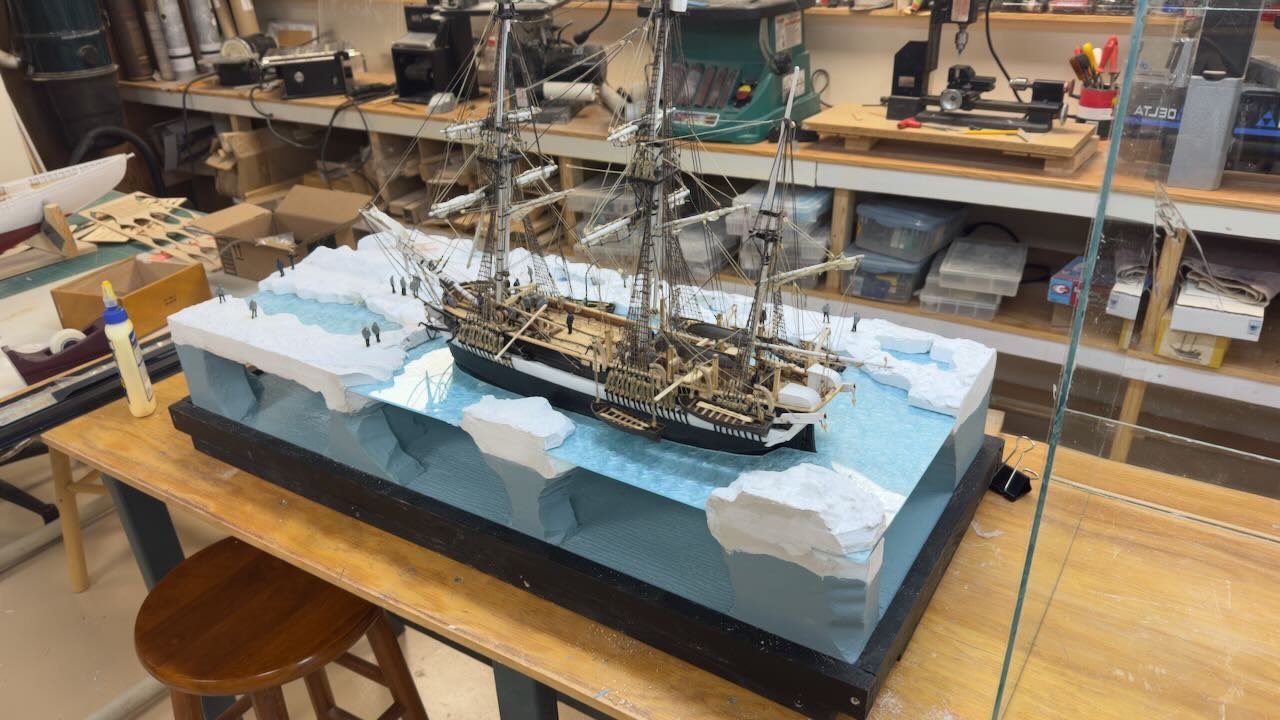
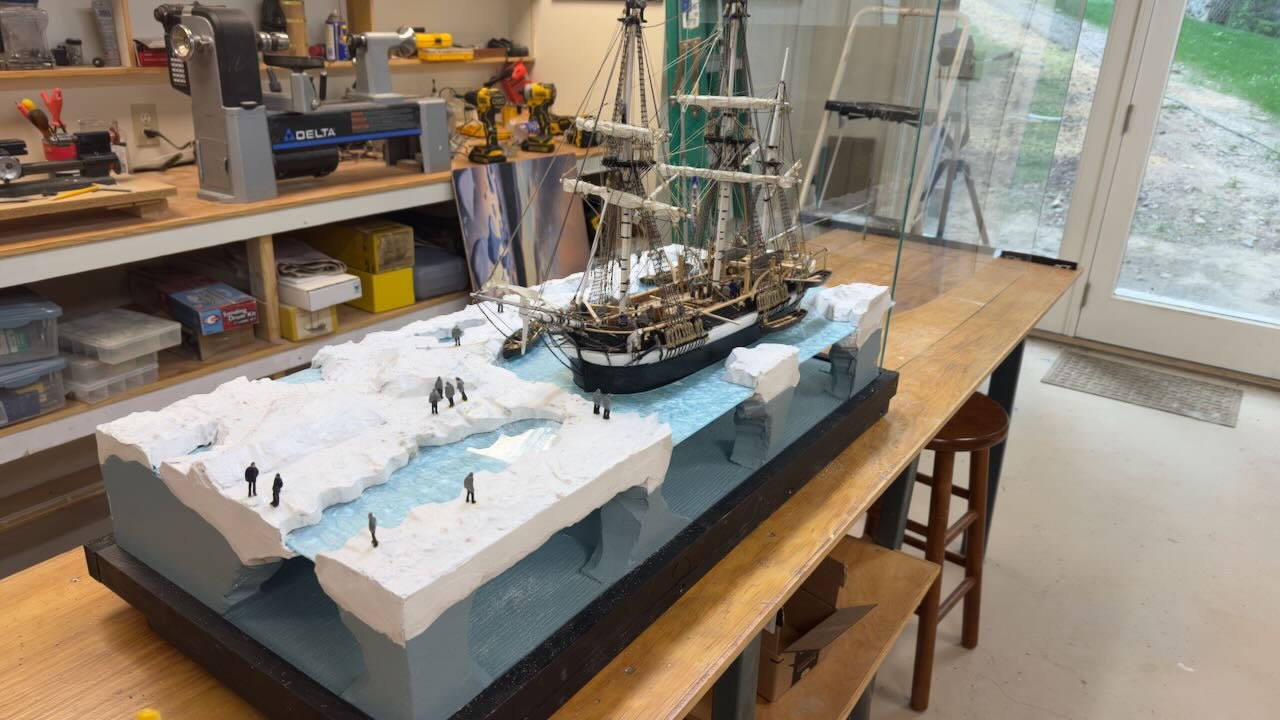
- here a few days back I had many of the crew located. The full crew including officers and scientists etc. was 64. In these two images I have 50 placed.
-
4-5
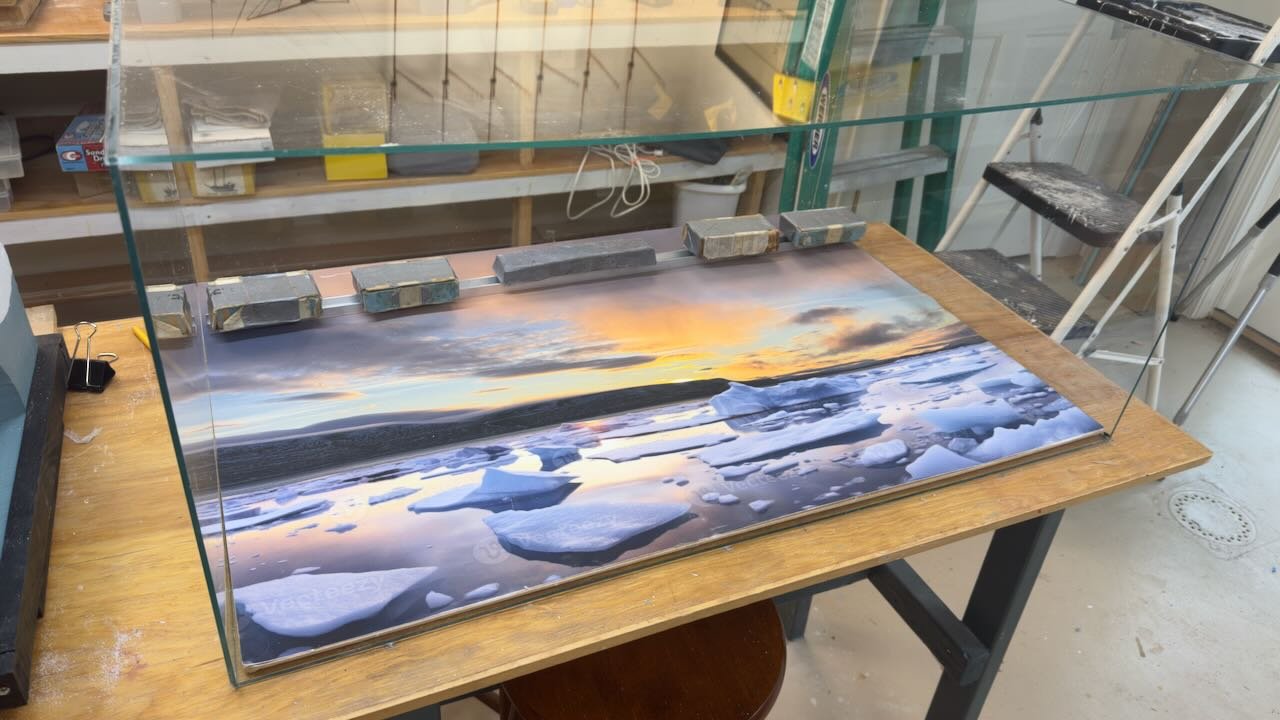
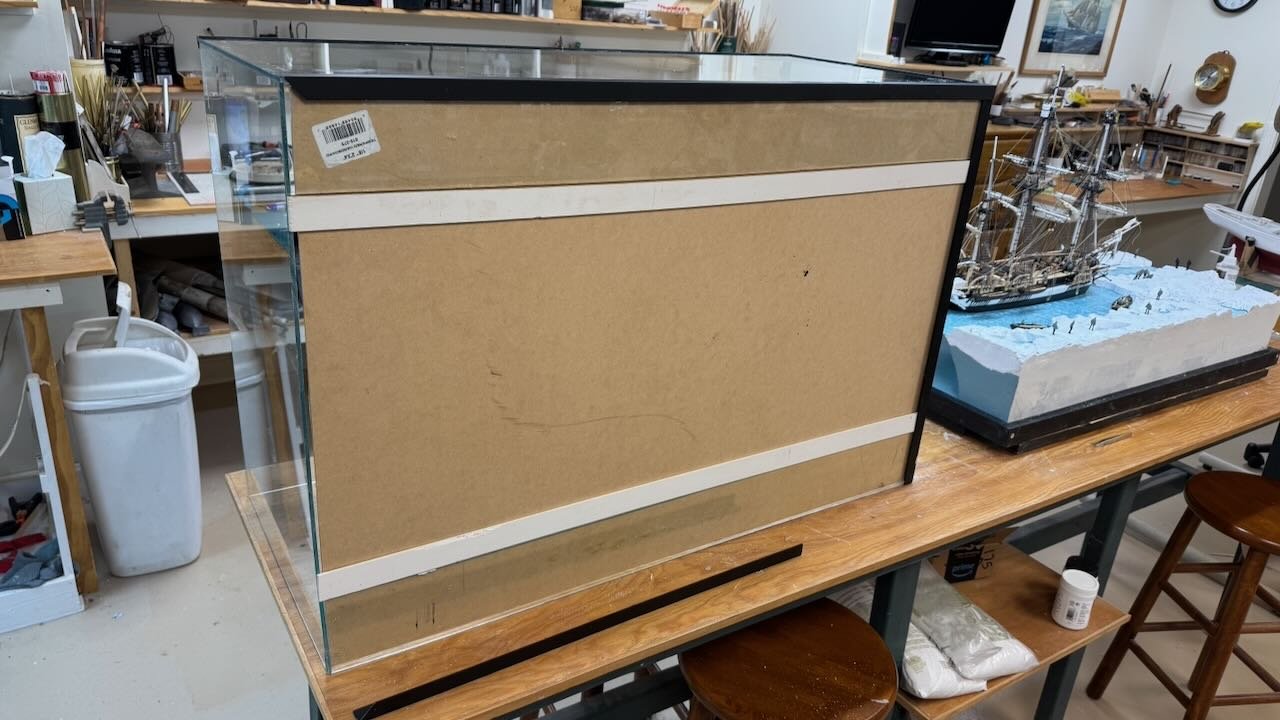
- here was an adventure. How to incorporate the poster into the case. A key issues is that glue between acrylic and other materials is just not recommended. My approach was after cutting the 16.5-inch top piece, I took the remainder from the 24” inch sheet and cut it in half. I then welded it to the top and bottom of the back. I then laid the poster on thin mdf on 3/16” strips of wood using normal wood glue. I used aluminum channel and weights to keep all as flat as I could. In the second photo of the completed back, one sees the two wood strips adjacent to the two back strips. They are extended past the sides to hold the poster in place. I hope it works…
-
6-7.
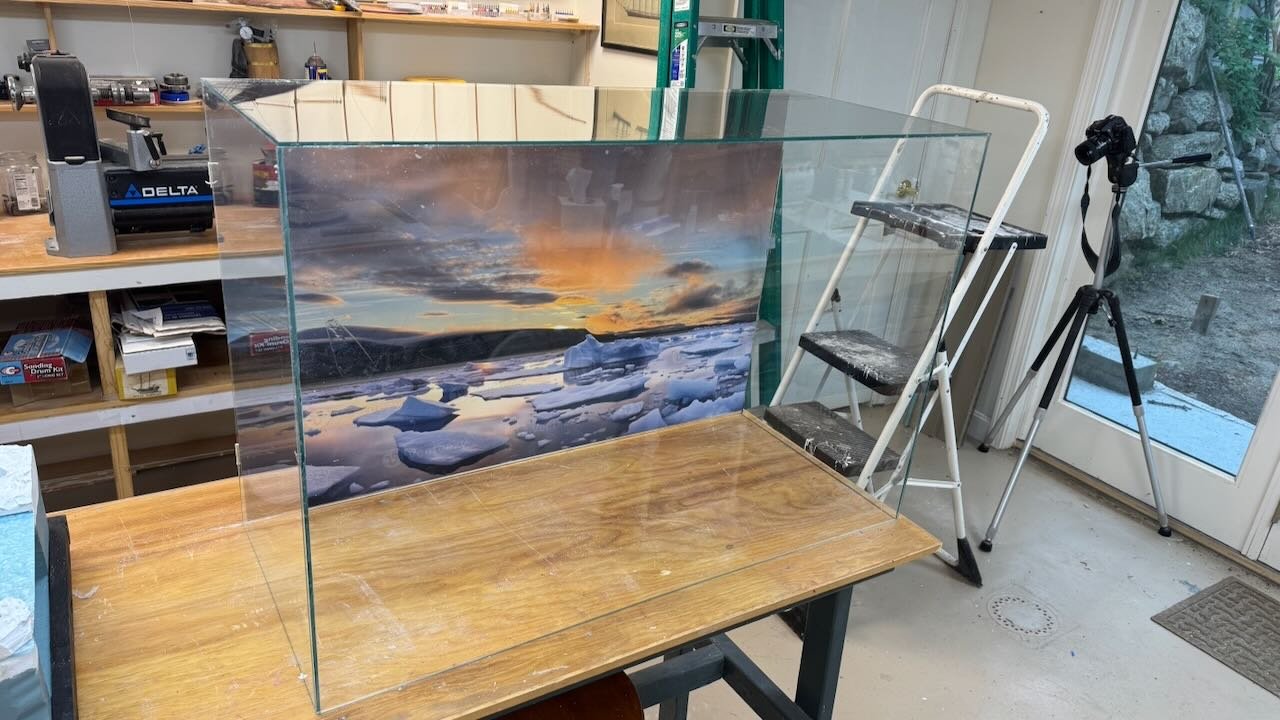
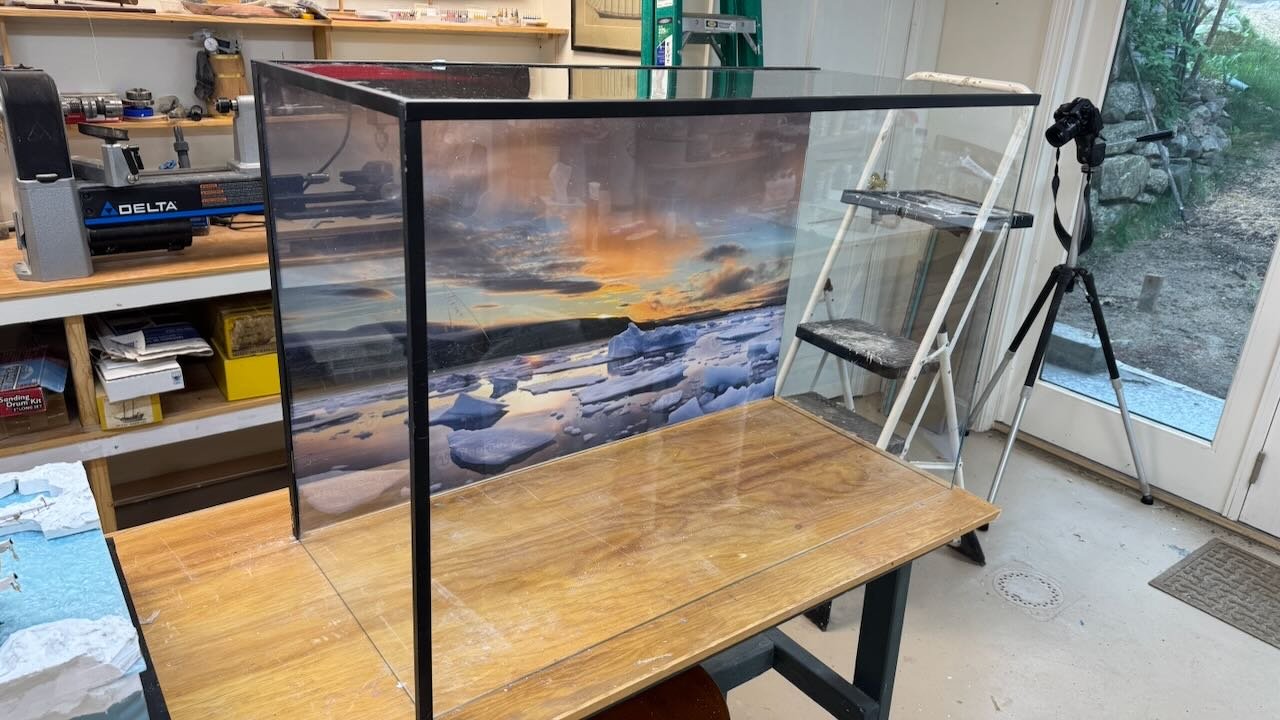
- here we see the welded up case…my first so there are a few oops…. In the first view we see the green edges. For simplistic affect I agree the green choice was a good one. However, every oops is there to see. In the second view I have taken aluminum strips and spray painted them flat black over auto primer. Before I proceed to add the aluminum, I need to learn how one glues painted aluminum to acrylic. I thought to try clear silicon sealer, but it failed. I guess I need to experiment.
-
8-9.

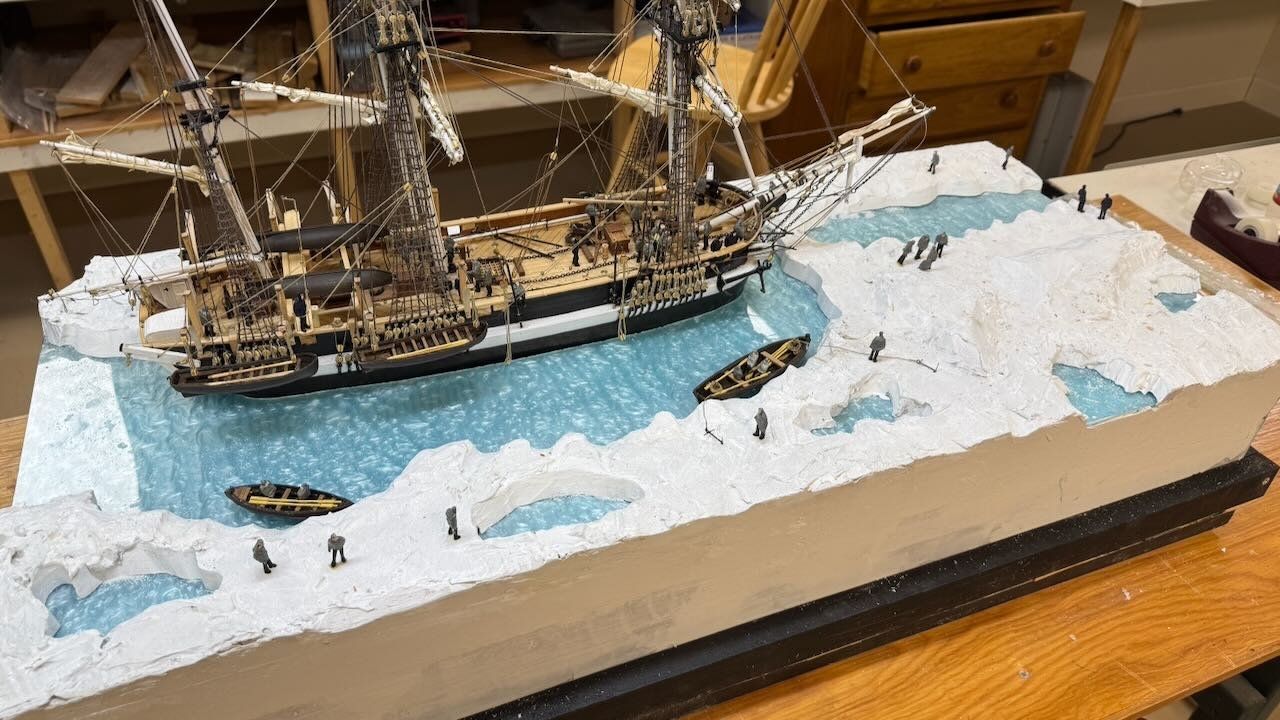
- after more thought, I decided to take the remaining figures and put them all out. There are 21 on the ice and 39 aboard. That is all but 4 of the crew who may well have been up and about on the early morning in the later fall of 1845. My real reason was to show in the story how huge the crew of the adventure was. That huge size is one of the key reasons the attempt to traverse the passage became such a tragedy. These two views are both not what will be normal . the first is from the top and the second from behind.
Next up is the punchlist and completion of the case. Then to move it, does it stay inside the case? I hope so and that is one reason I did not repeat my earlier uses of glass. It is just too heavy for moving.Happy summer
-
1
-
post 34
This one-time post is to update the life of the diorama of the pinky schooner Superb. As a reminder, since this is 5-year-old build, this pinky schooner Superb was the first built by the Hodgdon family of Boothbay in 1816. They are a still running active shipyard where the 6th generation is just taking on the leadership from Tim Hodgdon. I used the kit for Glad tidings as a material source and drawings from the Adams shipyard [ contemporary with and adjacent to the Hodgdon yard].I have discussed in other logs that the museum Store in downtown Boothbay Harbor was closed after several fun years. It was a very unfortunate occurrence as today, some two years later, there still is nowhere sufficient to collect and share the 200 plus years of maritime history we have.
Both dioramas of Superb and schooner Bowdoin had been relegated to my garage…..not nice. I have been concerned but as they had cases and it is heated, I felt they would be ok. In my recent build of the HMS Terror, I came to the time that one must considerer a home for the completed project. That is without building a new home. Before I get back to another build, I want to fix this problem. A two foot plus square platform is not practical for home display. The first option is to remove the vessel and put it on a traditional stand. That takes too much away from the story.
After much consternation, a light bulb went off in my head……cut the diorama to a 10-inch depth and place it on a shelf. Then she can come to the model gallery and sit with the others. If we ever do get a museum type opportunity to tell the story, I could make a poster for a backdrop to regain the imapact of the larger format.
So here is the renovation
- 01 -02. here the platform has been stripped of the vessel, work crew and loose parts. I then turned it up so I could remove the bottom frame that I will replace with a smaller one later.
-
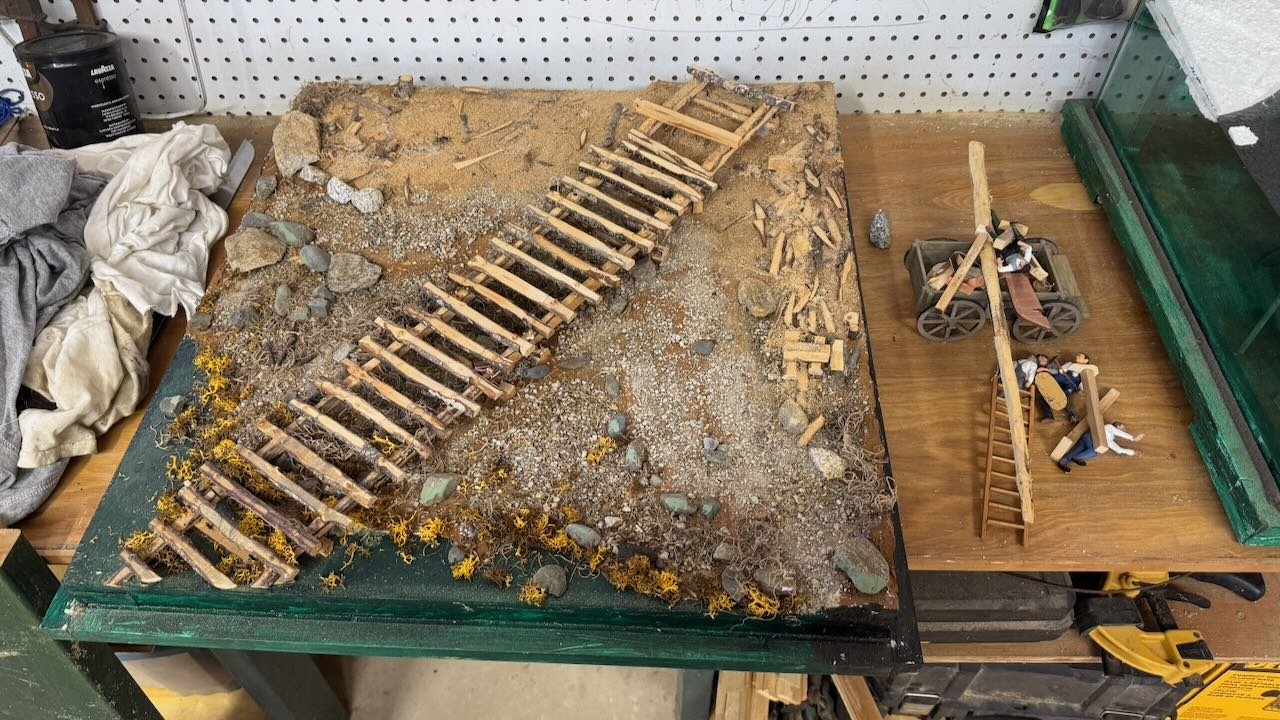
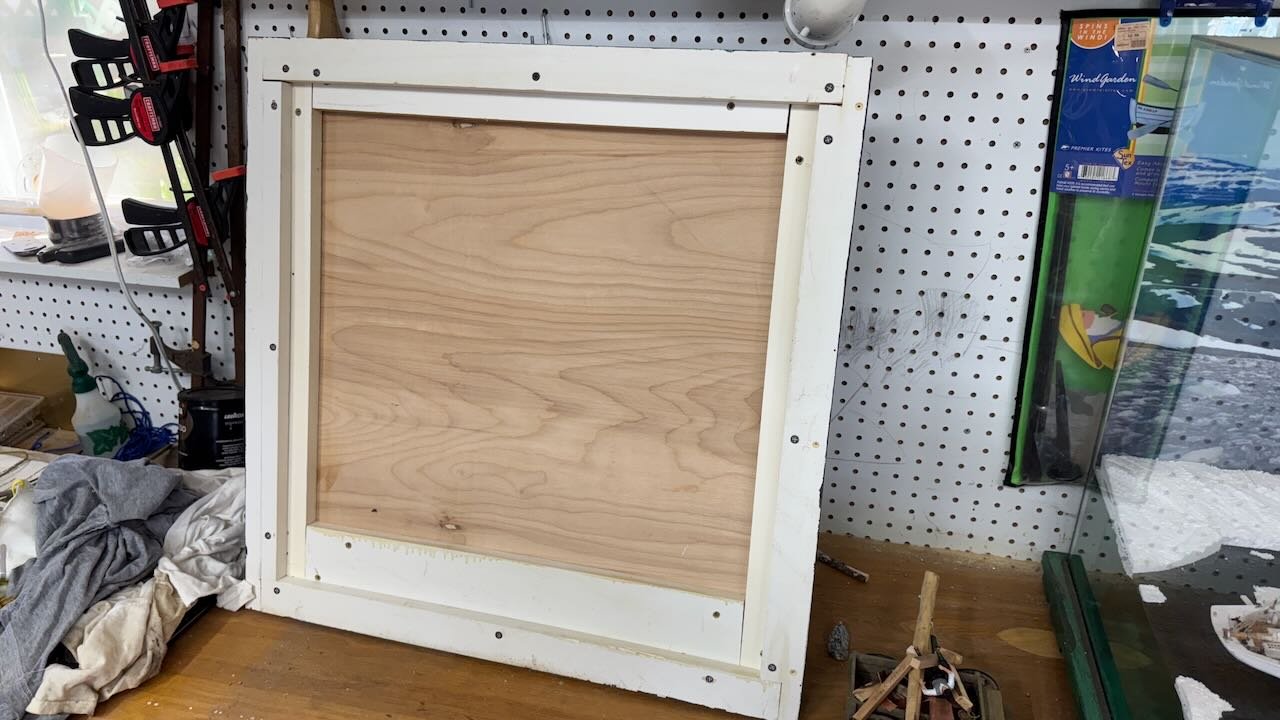
- 03-04. here I am cutting. The power saw blade was too short to go through all so I needed the old fashion one to complete the two cuts.
-
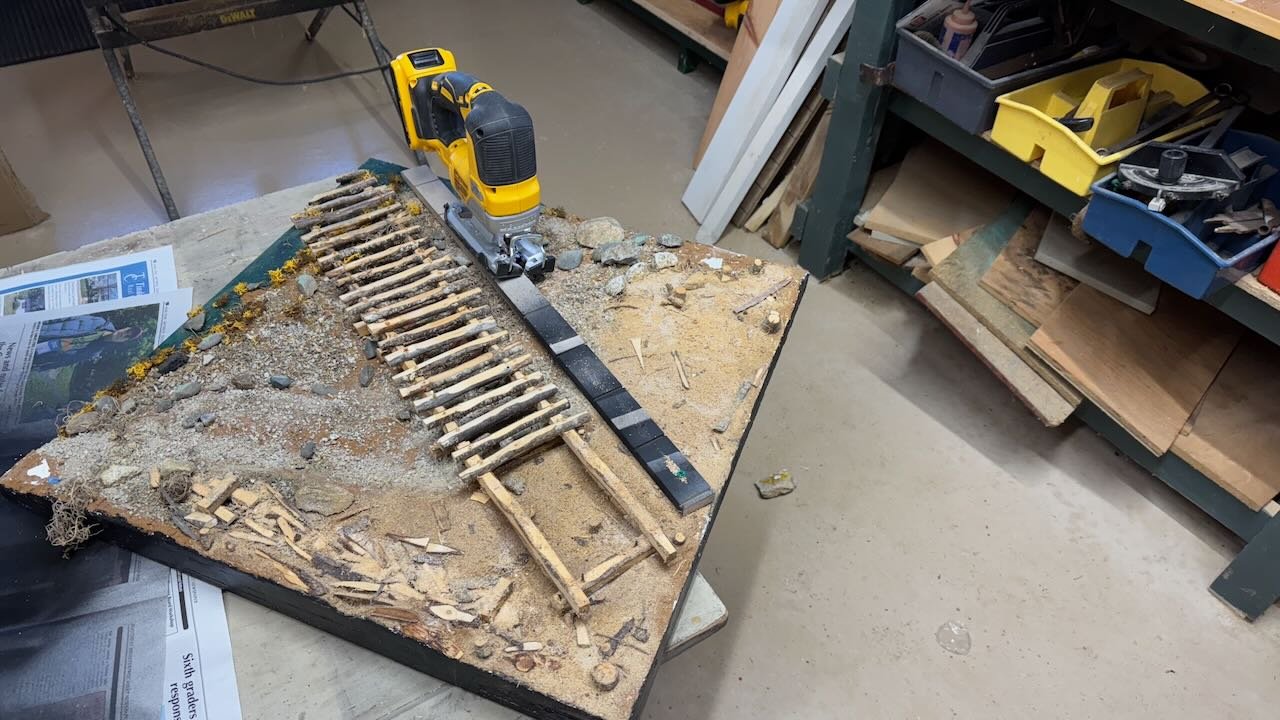
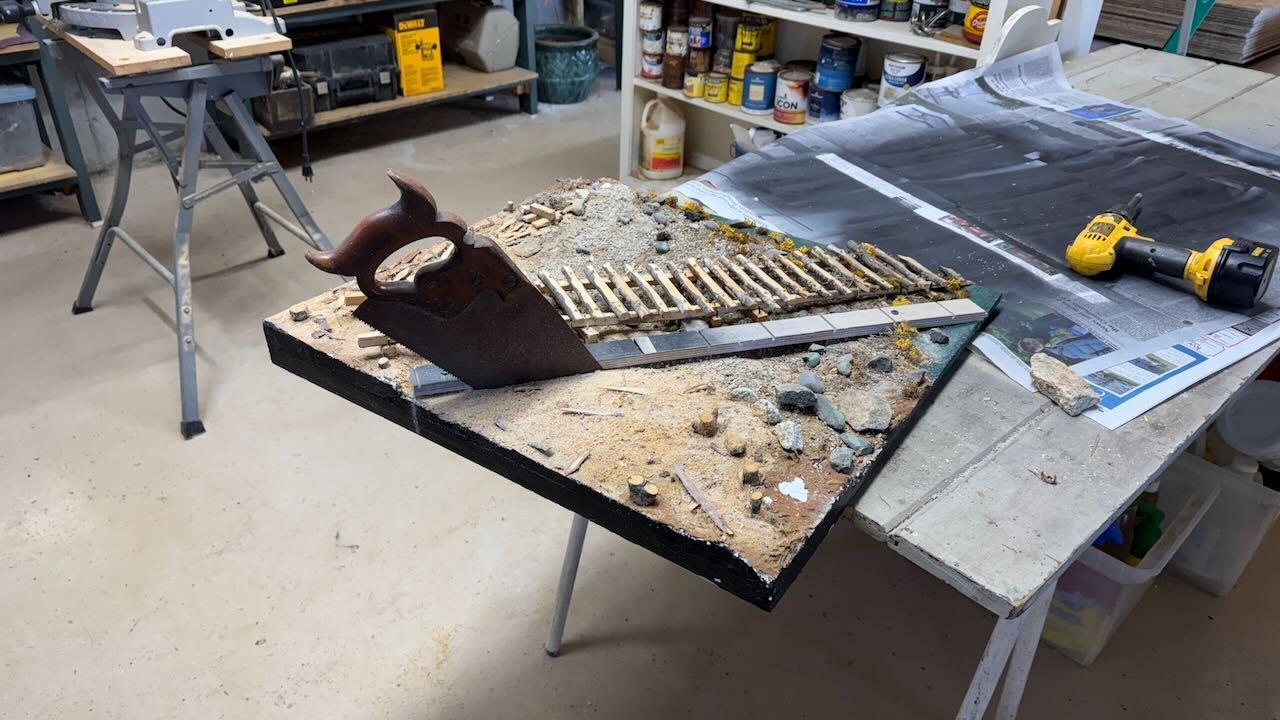
After rearranging the landscape, a little bit and focusing the work crew on the front side, I used some thin ply to band the cut edge and paint it out. I also added a small bottom frame to lift the platform off the shelf.
- 05-09. these shots show the completed rebuild on the work bench and ultimately in its new home shelf in the gallery.
-
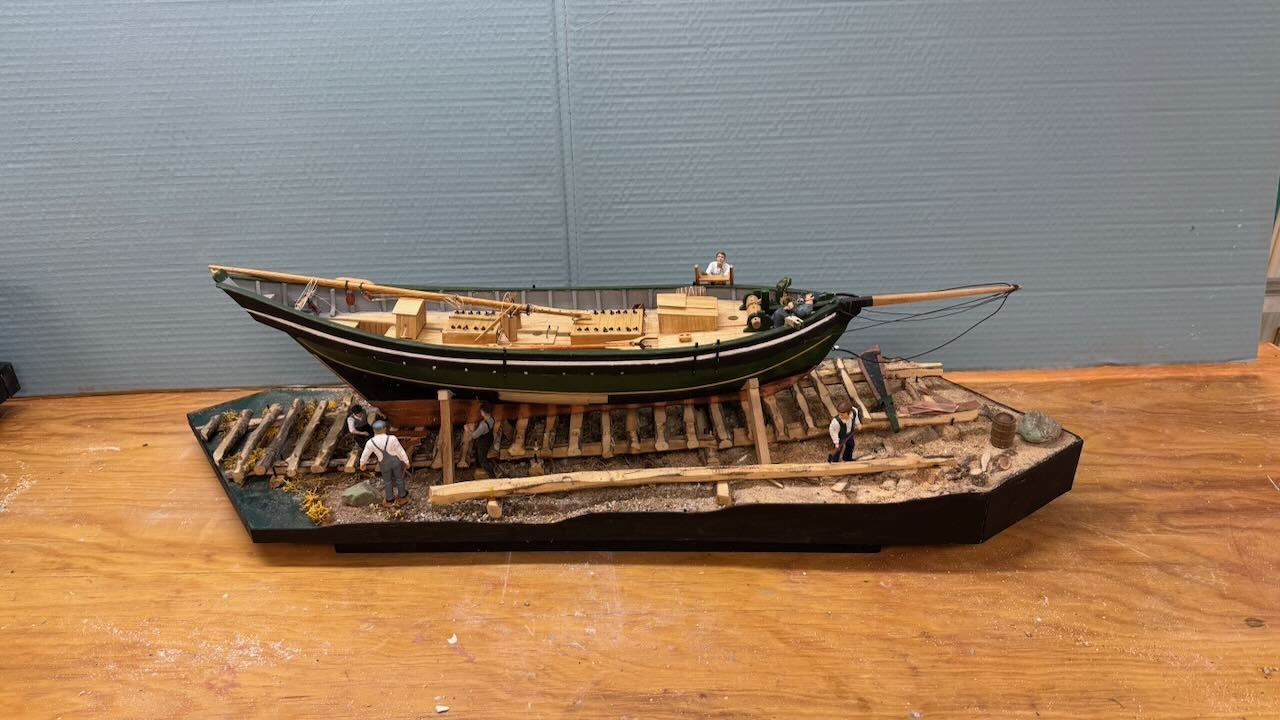

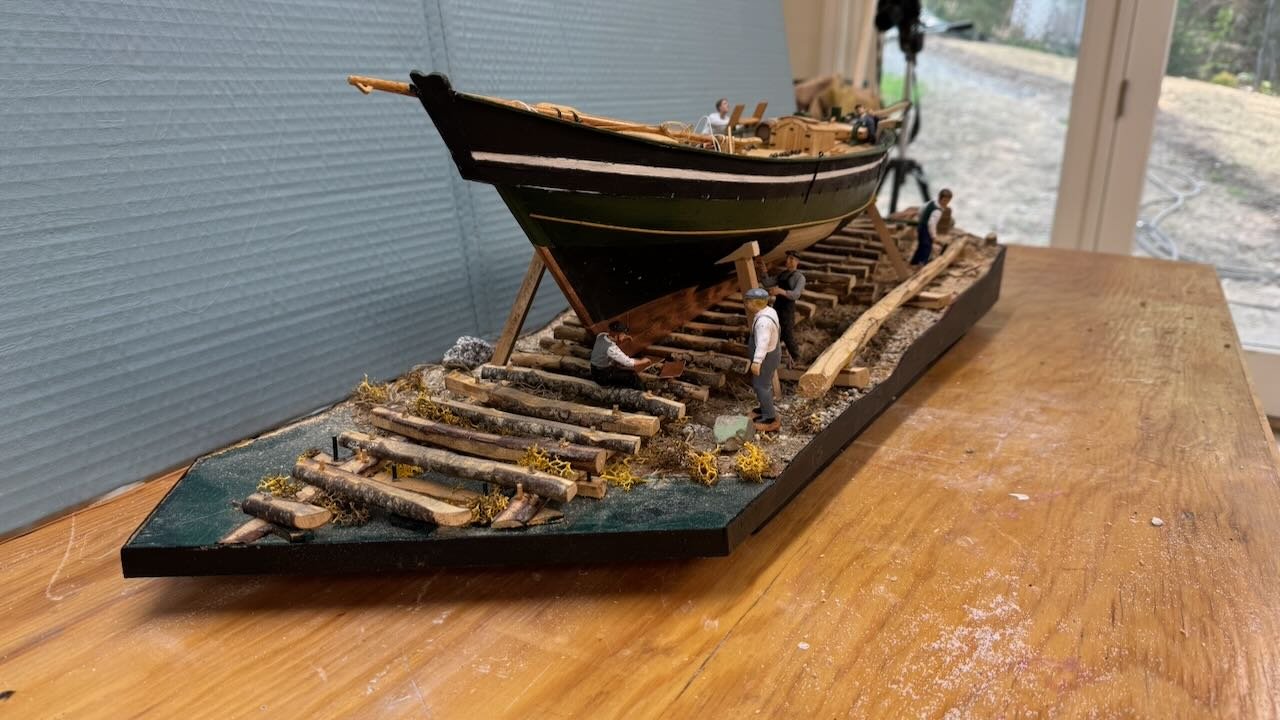
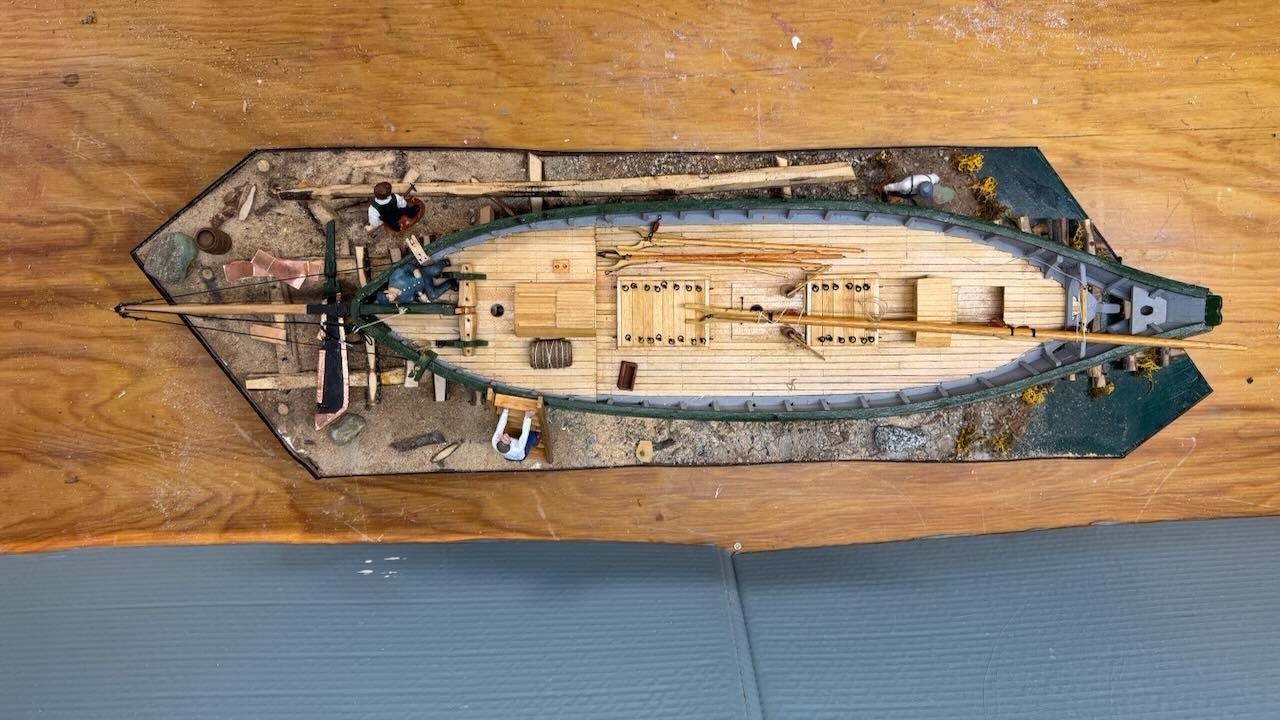
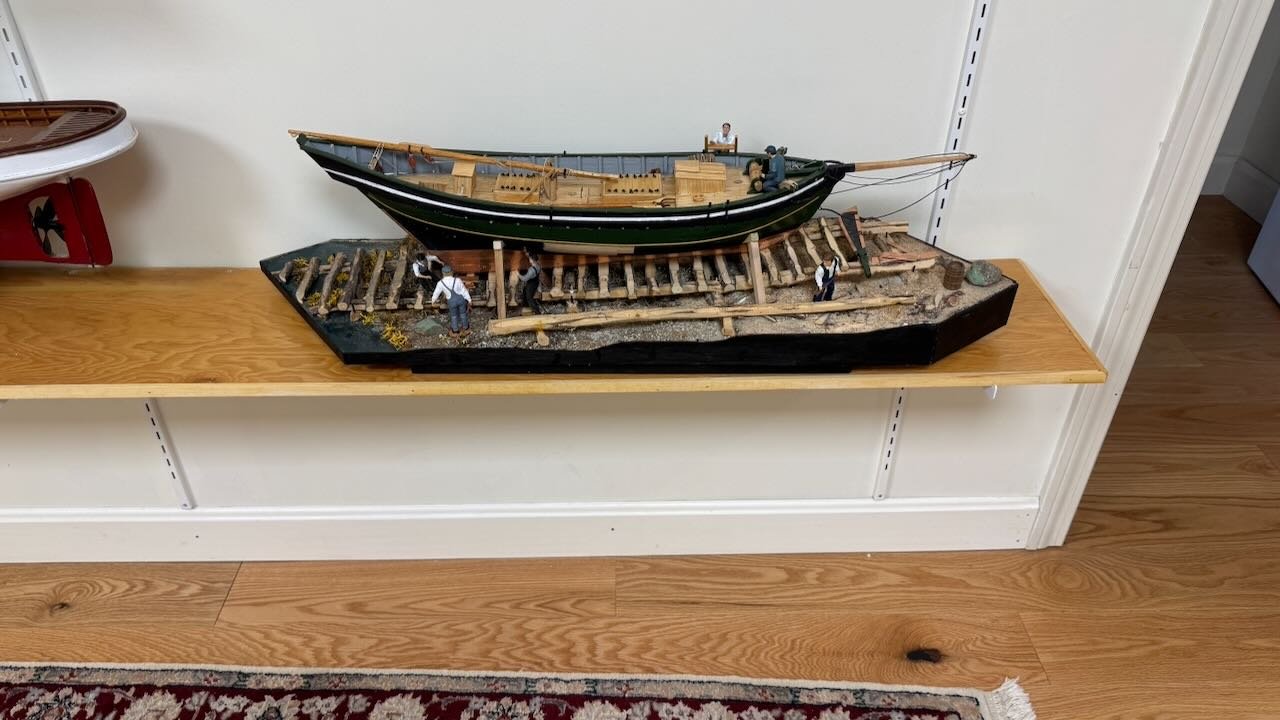
Not that many will get to see it, Superb is waiting for a chance to escape.
Cheers
- Paul Le Wol, JacquesCousteau, ccoyle and 4 others
-
 4
4
-
 3
3
-
17. little people, little boats. Other little things
It has been a month and slow. "little' progress gets made. Competition with spring outside requirements always interfere. I also I spent much time this month cleaning up and sorting the shop.This two-part update comes as I need to prepare and present the diorama to the local Shipmodelers guild. One is never totally ready for that…ha ha. First up is details and punch lists before the meeting and the second part will include the process to pick up and move the whole kit and bring it home again.
The crew had arrived months ago and it is time to prep them and to start to put them to work. The 1:75 scale limits the choices. More importantly I am looking for a good sized crew. They sailed with some 64 people. It is possible that all were up and about at the same time, but I figure many were and 'many' is a loose number. Second what did they look like working in subfreezing weather.
Here we go….
People……... I purchased a pack of 100 +/- figures, likely meant for a train station or the like. Taking the men, I wrapped them with some paper mache [ paper tower scraps and dilute white glue.] Then painted them light and after darker gray to simulate wool hats and sweater coats. The officers were selected as the 12 figures in coats, so I painted the coats dark blue and the hats black. The scientists perhaps were in civilian clothes, so I guess part of the officers in all black. About a dozen figures were sitting and that was fine. Everyone got black pants. I then coated the paper mache parts and officers with Mod Podge to improve the surface of the paper towel and hopefully add a little bulk to the jackets.
-
1-5
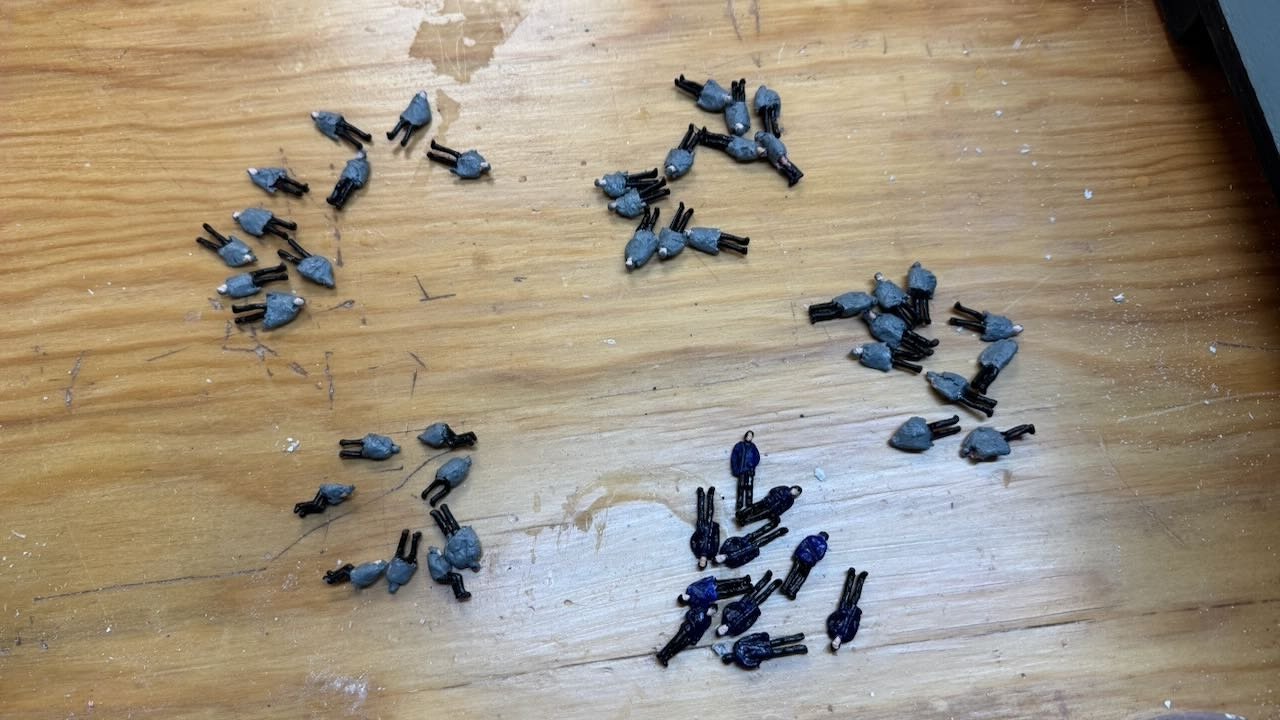
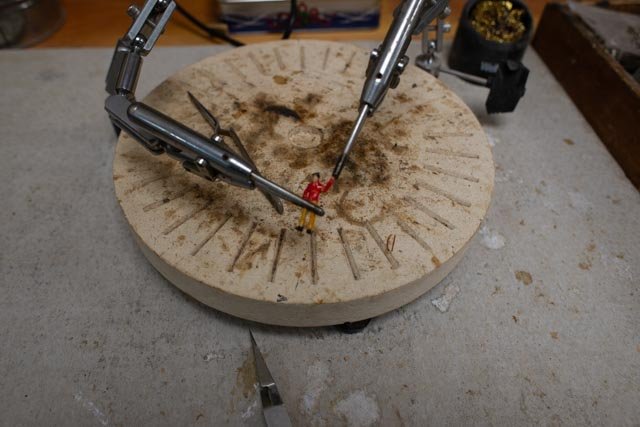
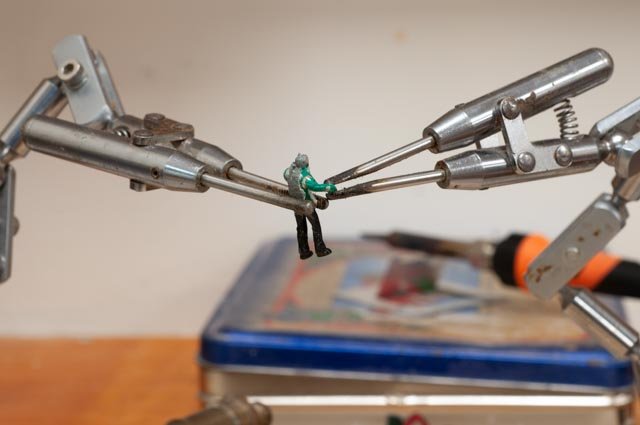
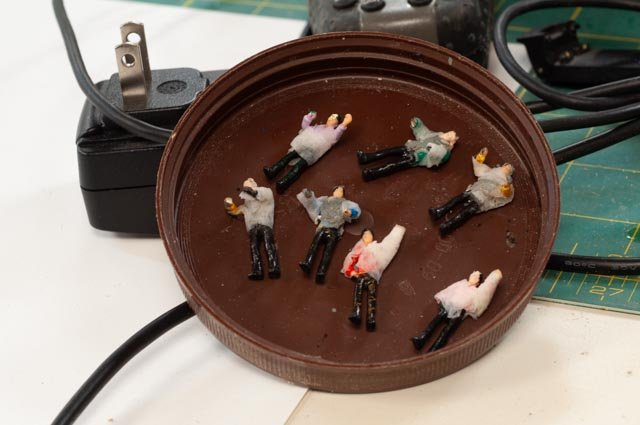
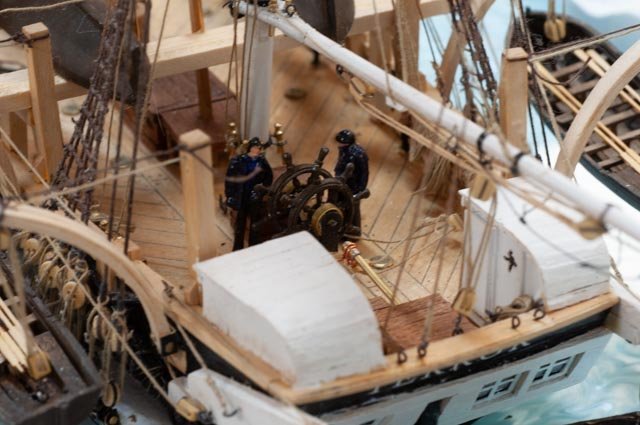 these views show first most of the crew in finishing steps of paint, trim, repaint, etc. Then I realized I need a few figures to be in action with arms reworked to hold lines or themselves to the rigging. I used the soldering station to maneuver them and went through 7 figures. the action figures have first application of paper mache. Finally to follow some protocol, I placed two officers near the helm to be first aboard.
these views show first most of the crew in finishing steps of paint, trim, repaint, etc. Then I realized I need a few figures to be in action with arms reworked to hold lines or themselves to the rigging. I used the soldering station to maneuver them and went through 7 figures. the action figures have first application of paper mache. Finally to follow some protocol, I placed two officers near the helm to be first aboard.
-
6.
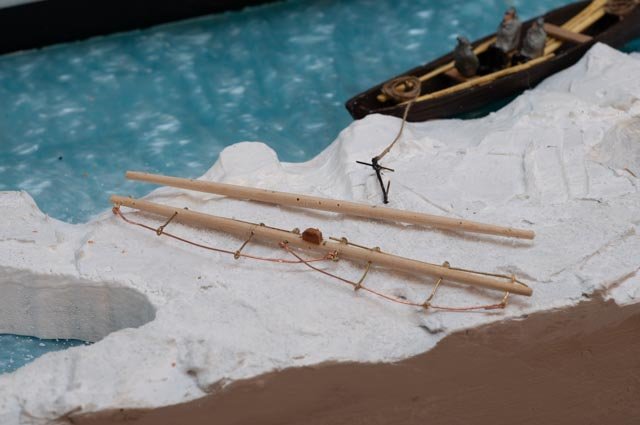 here is a question of what to do. The two topgallant yards would have been lowered and stowed. I have gone ahead and started to add fittings to one of them. It would have been very awkward to handle and stow, but also a pain to disassemble. Perhaps I should remove the foot ropes. I am not sure and still thinking. Perhaps I think too much.
here is a question of what to do. The two topgallant yards would have been lowered and stowed. I have gone ahead and started to add fittings to one of them. It would have been very awkward to handle and stow, but also a pain to disassemble. Perhaps I should remove the foot ropes. I am not sure and still thinking. Perhaps I think too much.
-
7-8.
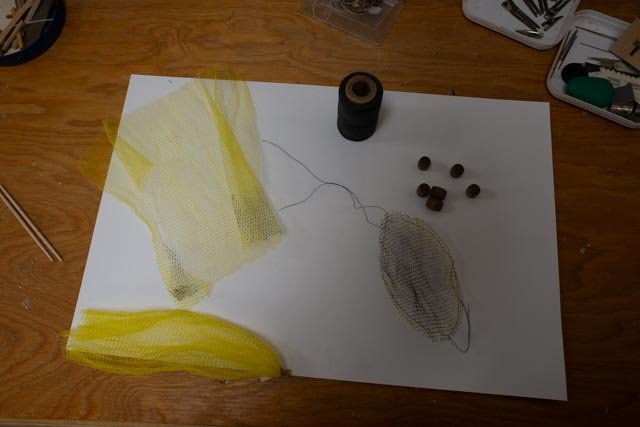
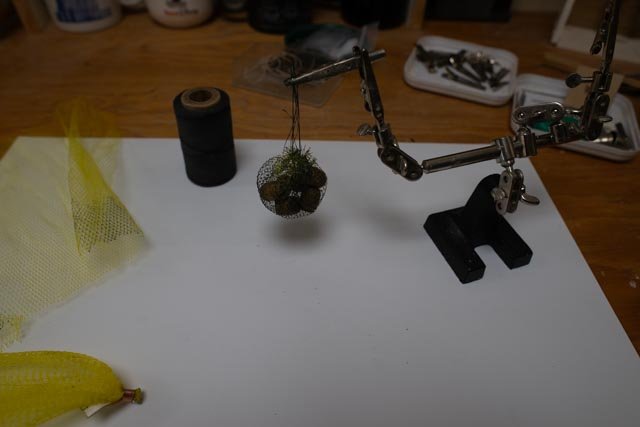 these views show an experiment. I bought some veggies in these neat little yellow net bags. I have always wanted to make a net carrying barrels on to or off of a model. Maybe this time is my chance. Using a little magic marker to blacken the martial and cutting it into a circle, I weaved tie lines and drew up the bag with 6 barrels inside. I think it is a nice idea but….
these views show an experiment. I bought some veggies in these neat little yellow net bags. I have always wanted to make a net carrying barrels on to or off of a model. Maybe this time is my chance. Using a little magic marker to blacken the martial and cutting it into a circle, I weaved tie lines and drew up the bag with 6 barrels inside. I think it is a nice idea but….
- They would have done it after iced in to set up emergency supplies on the ice off the boat in case of crushing etc.
- The trysail gaffs just barely makes it over the side. Was there more rigging attached to the idle yard arm for this purpose?
- Finally, I note the trysail gaff is not long enough to reach the hatch. How would they have rigged for pulling barrels and other goods from the hold to the deck? Perhaps, like a whaler or other vessel managing such things at sea, there had to be more rigging spanning the two masts to get to the hatch and then the yard arms to get over the side.
-
9-10
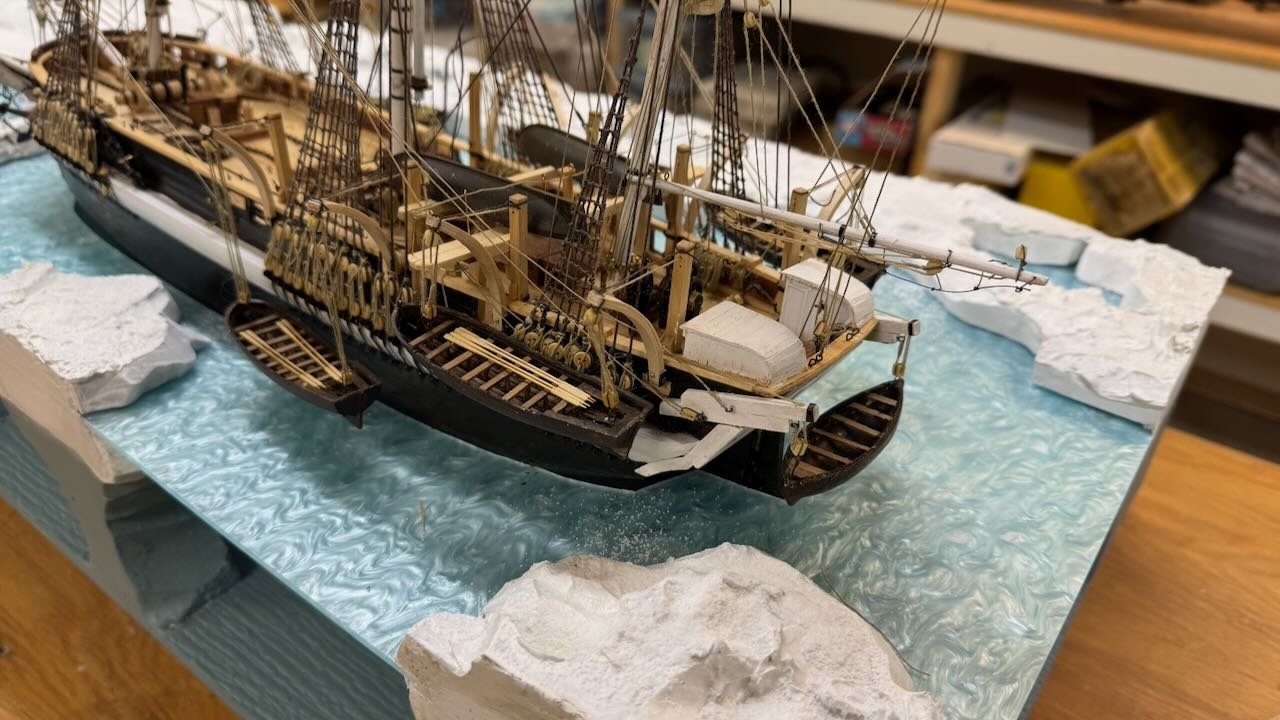
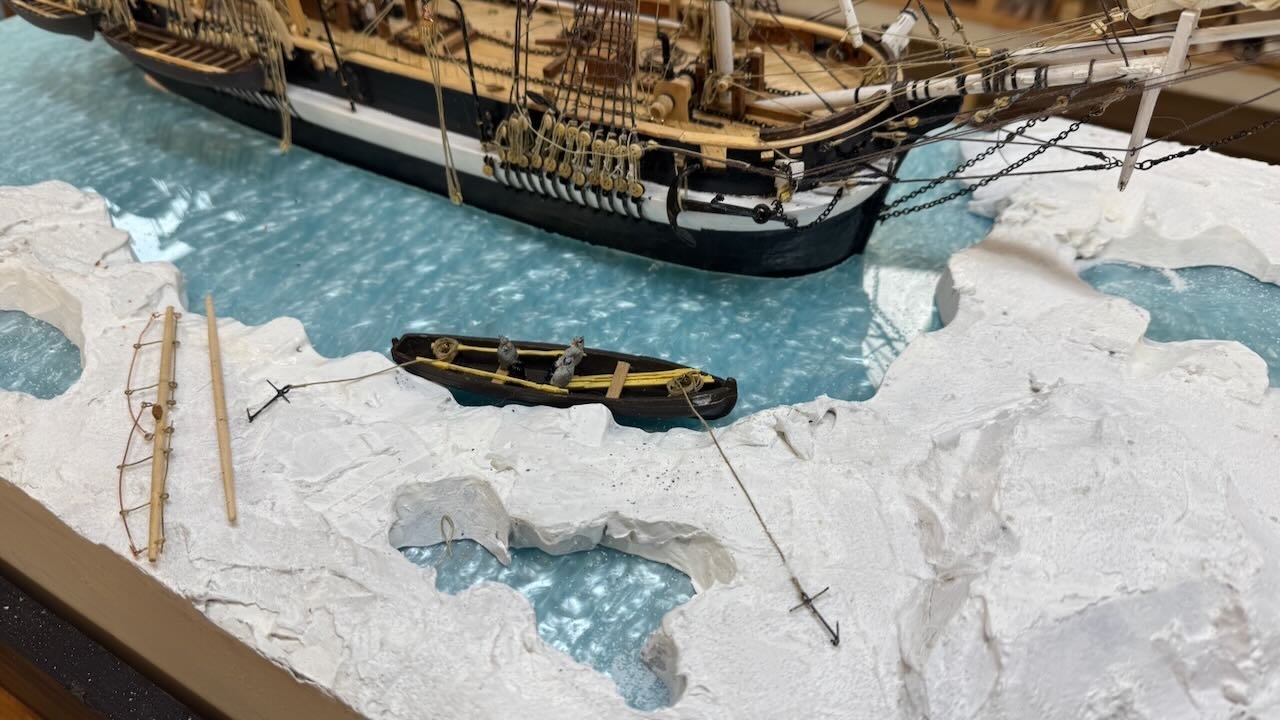 the boats are now on board, and the main Pinnace is overboard. I made up anchors with brass wire, as any from fitting options that i saw seemed too big for a small boat. I still need more oars and coils.
the boats are now on board, and the main Pinnace is overboard. I made up anchors with brass wire, as any from fitting options that i saw seemed too big for a small boat. I still need more oars and coils.
- so off to the meeting this week. I capture what happens to transport this monster, as it most go two more times this summer.
cheers
- clearway, SiriusVoyager, PaddyO and 1 other
-
 4
4
-
1-5
-
Thank you John and keith
it is unfortunate the museum store in Boothbay had to close. I had three dioramas and a schooner there and enjoyed helping out with minor repairs to others from time to time. Now those models have all come home. The Pinky Superb built by Hodgdon in 1816, the Schooner Bowdoin built here 1921 and replanked in 2016 at Bristol Marine and Ernestina Morrissey Bob Bartlett's schooner completely rebuilt here in 2020 bracket 200 active years of Boothbay shipbuilding. the latter two also highlight my fascination with the arctic. Unfortunately continuing to tell the local story is a challenge. Your builds including your Red jacket are part of our Maine story too . Unfortunately both the pinky and Bowdoin are no relegated to my garage.
cheers
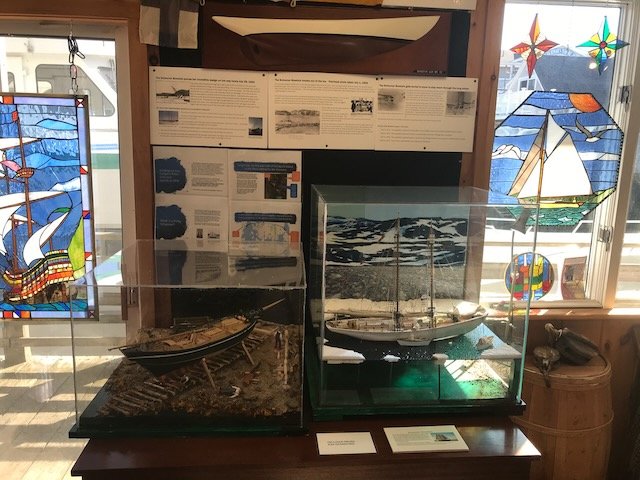
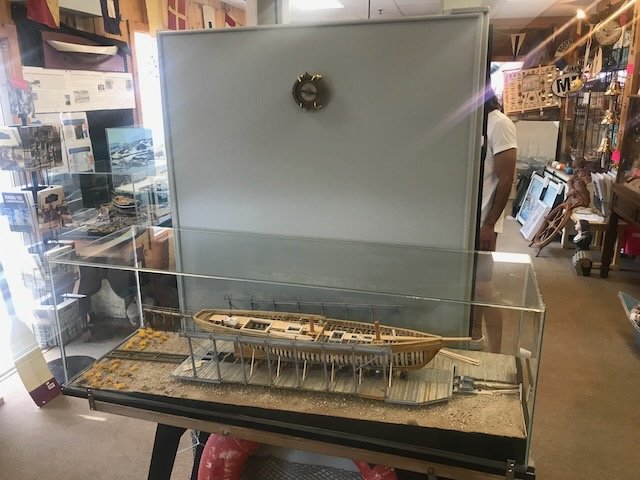



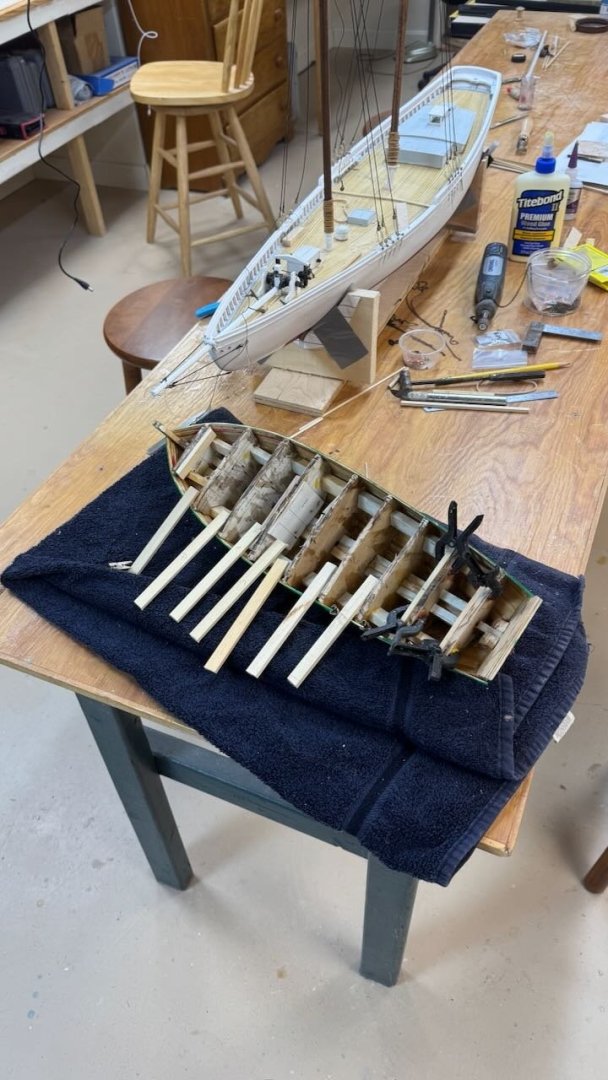
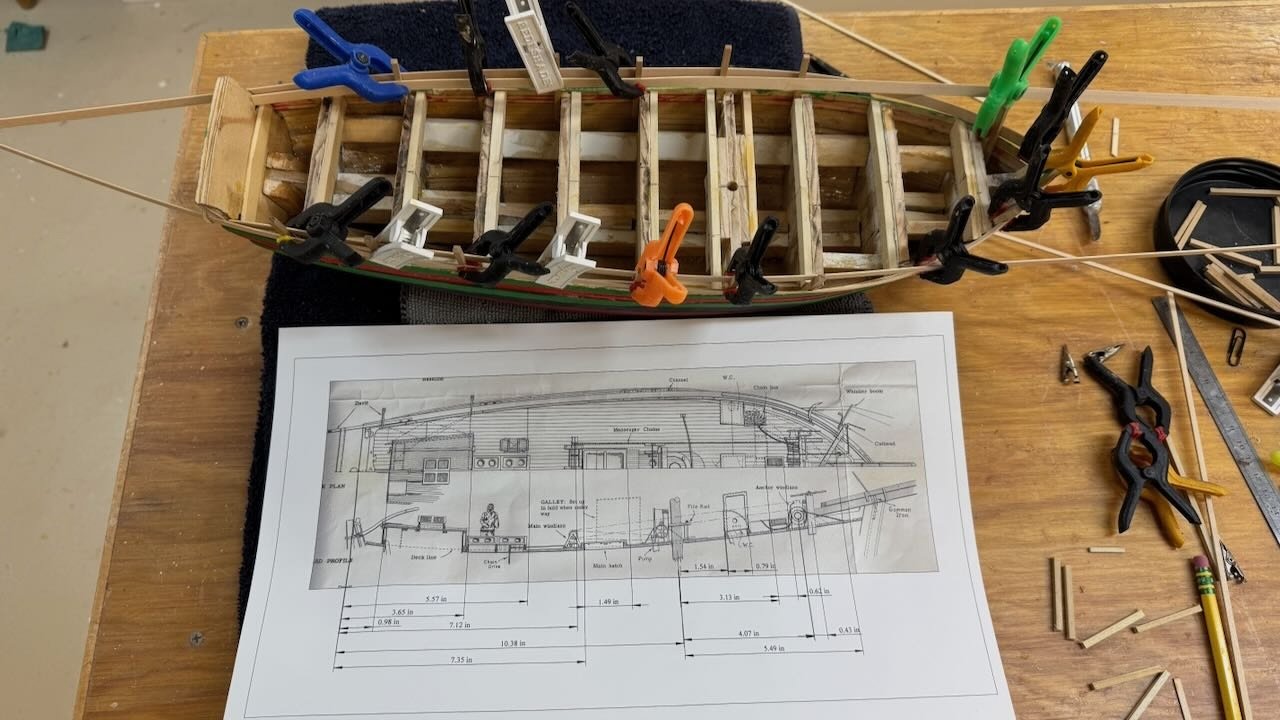
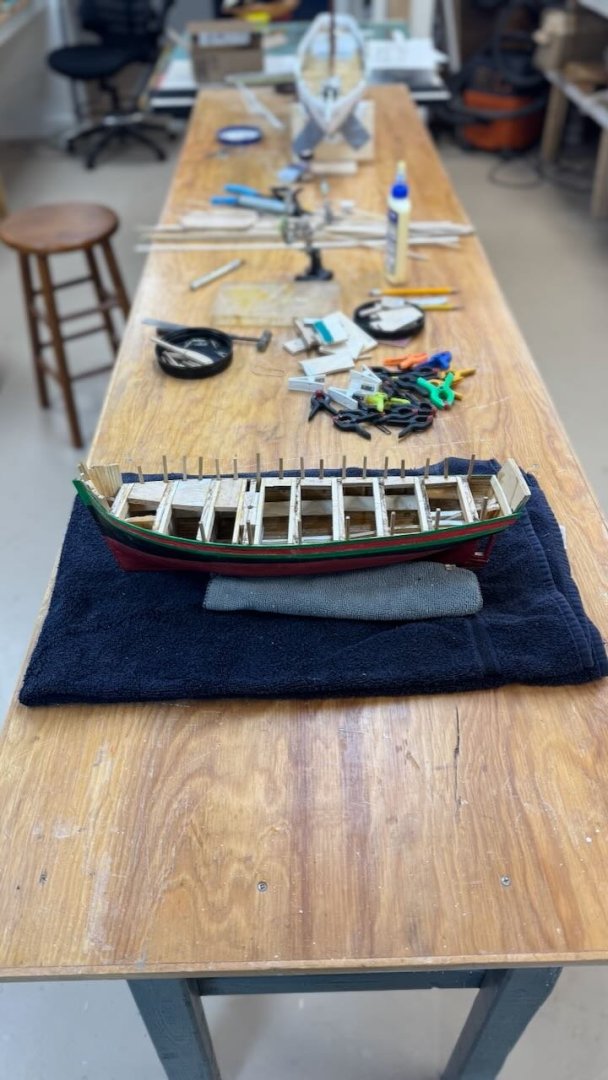
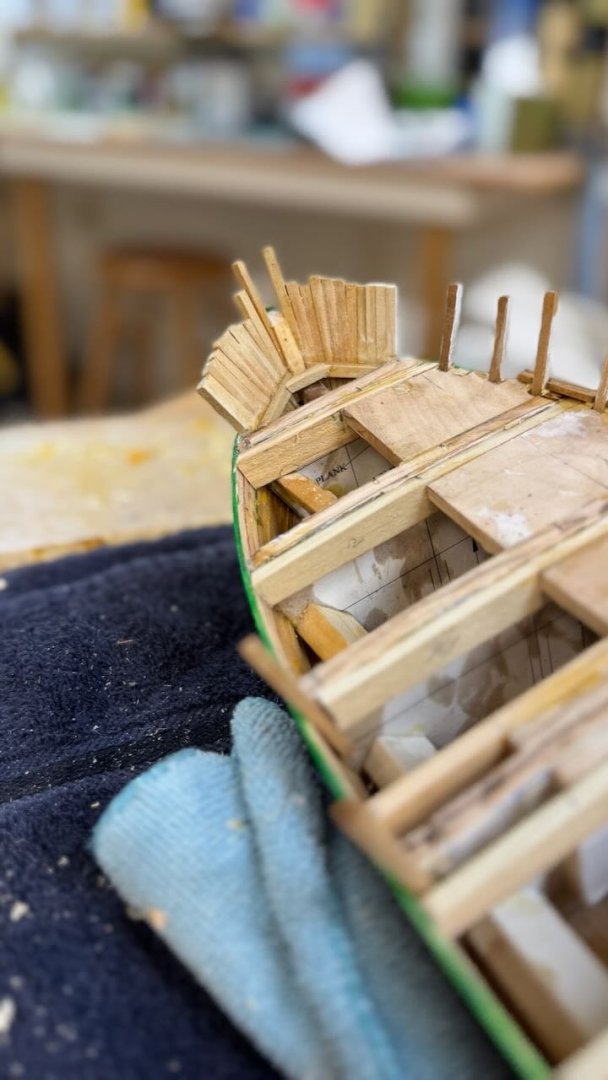

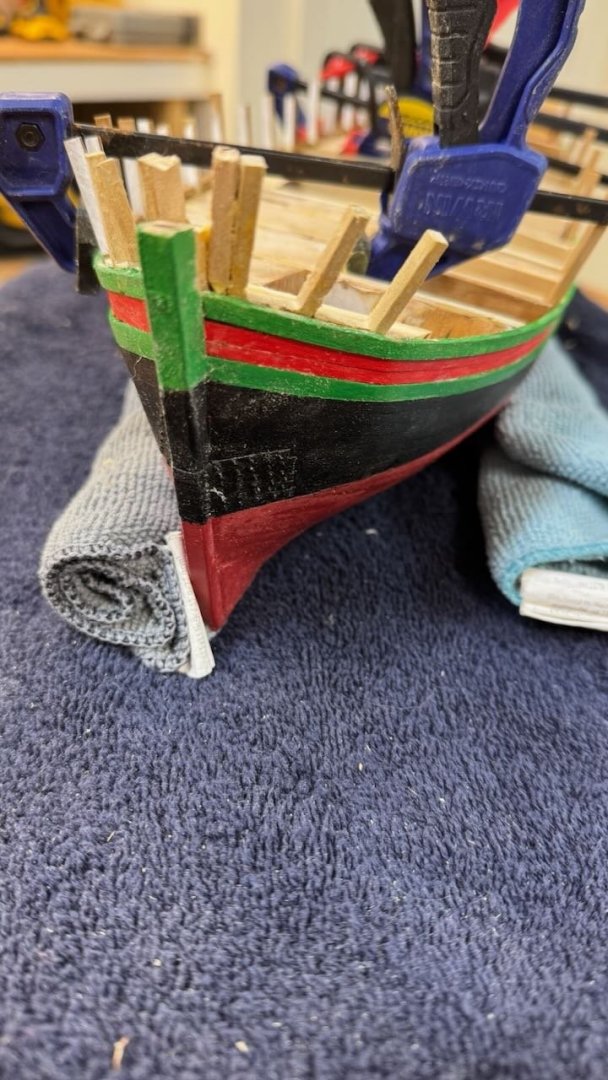
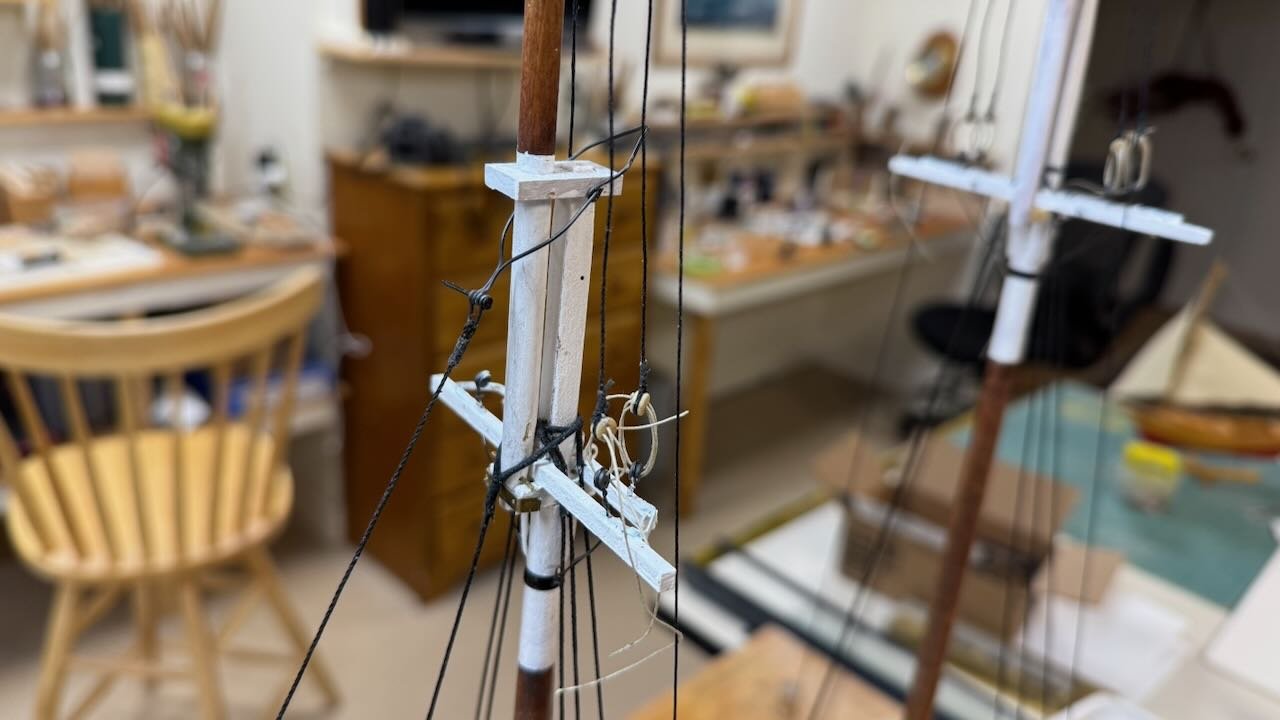
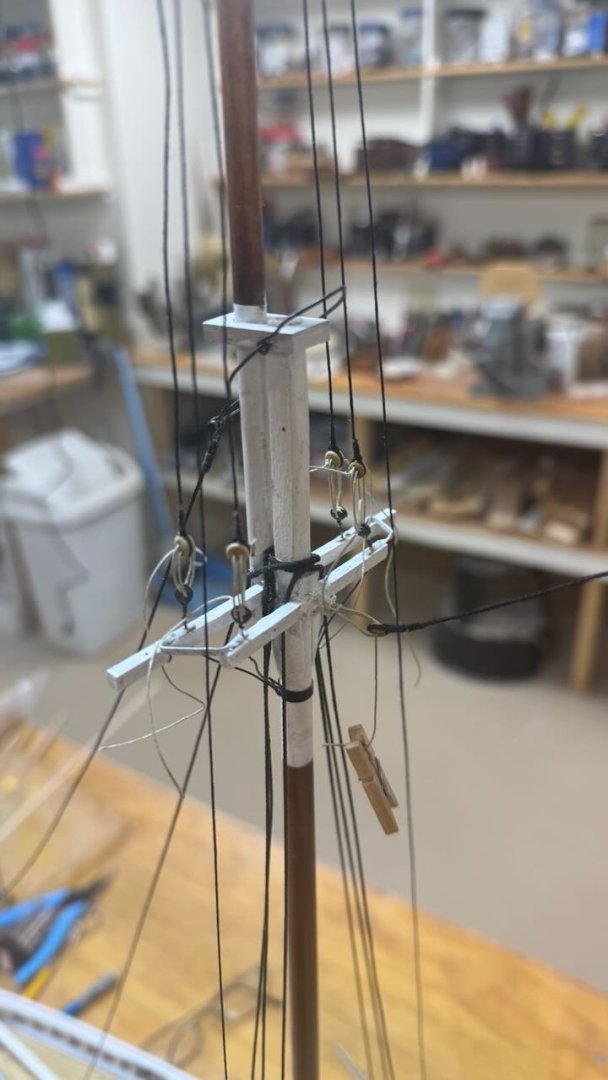
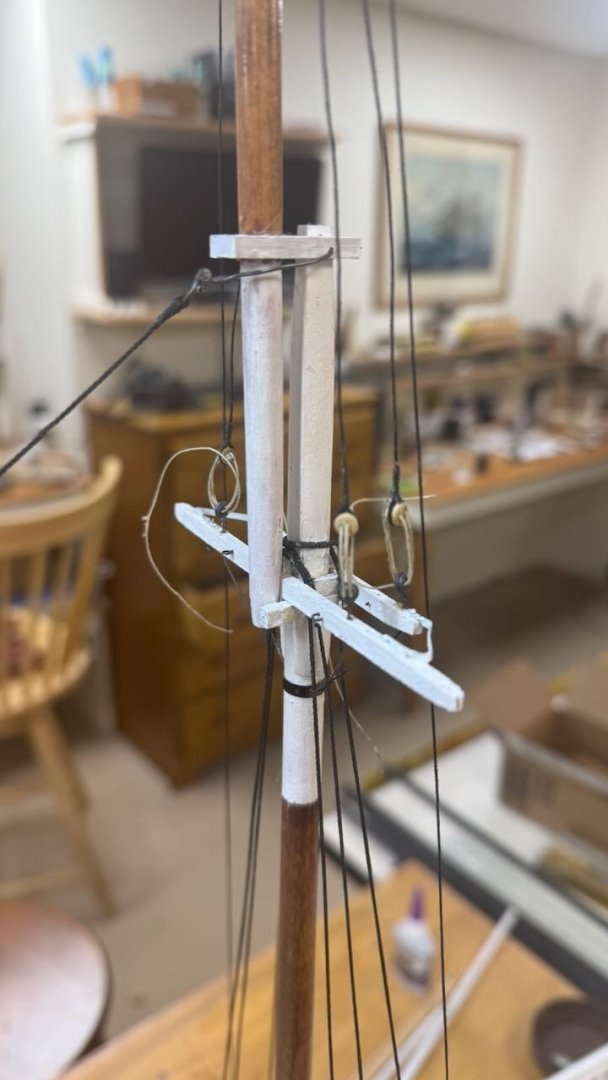
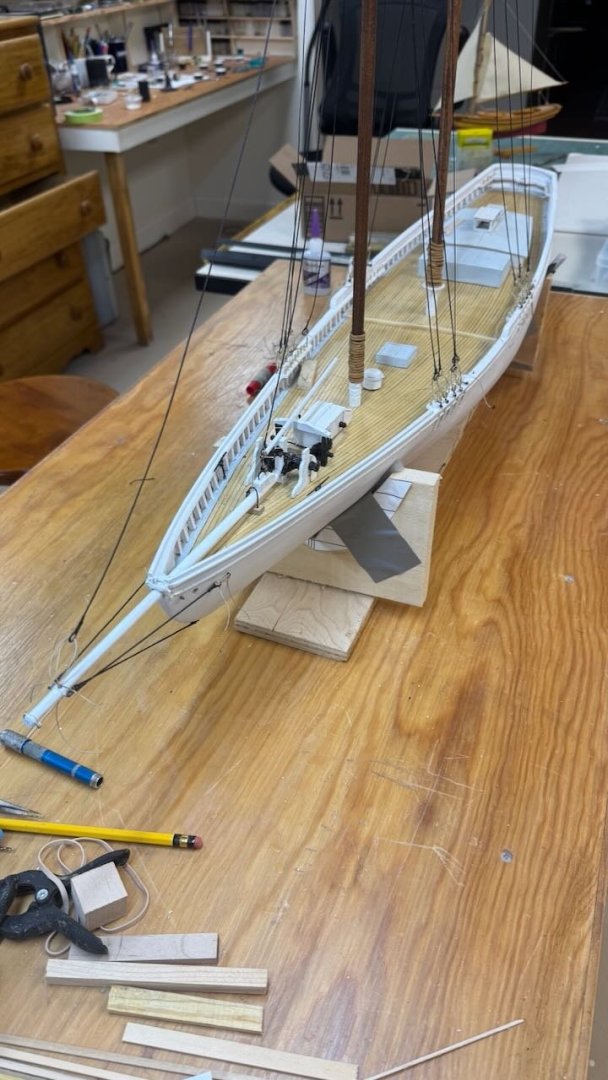
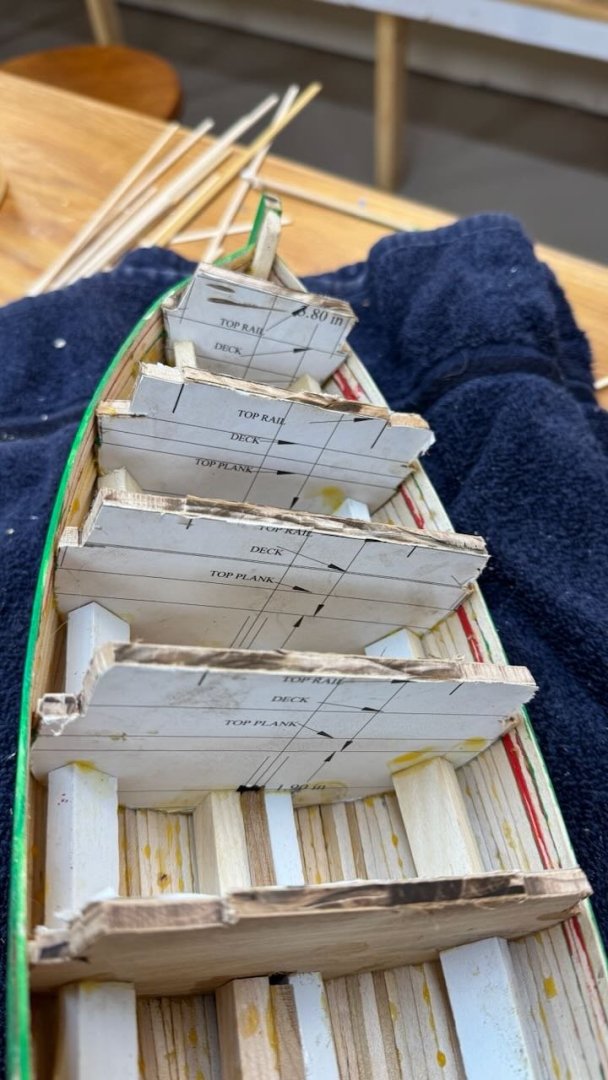
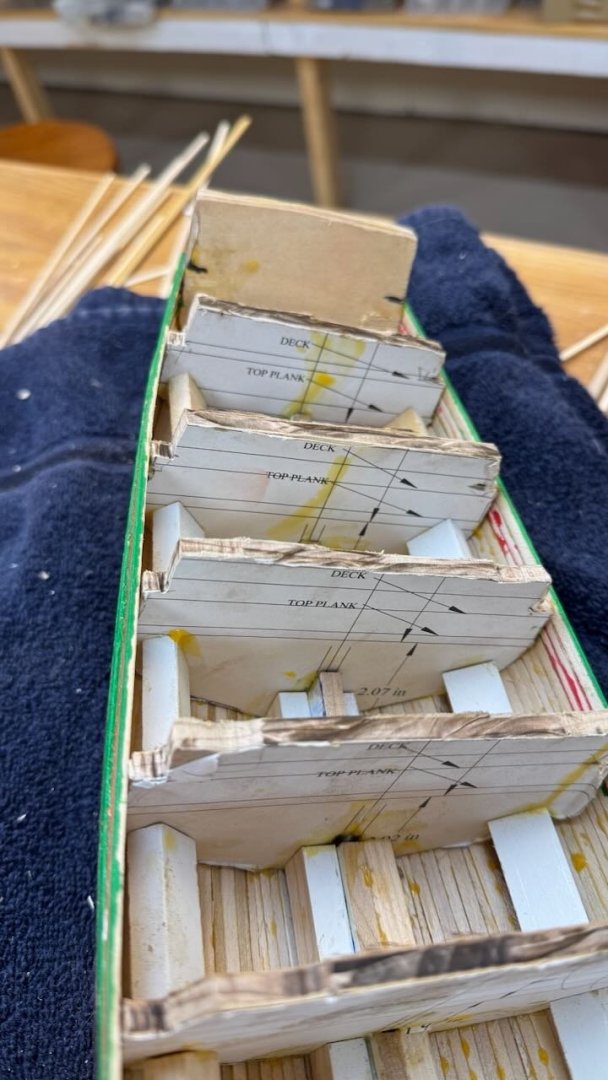

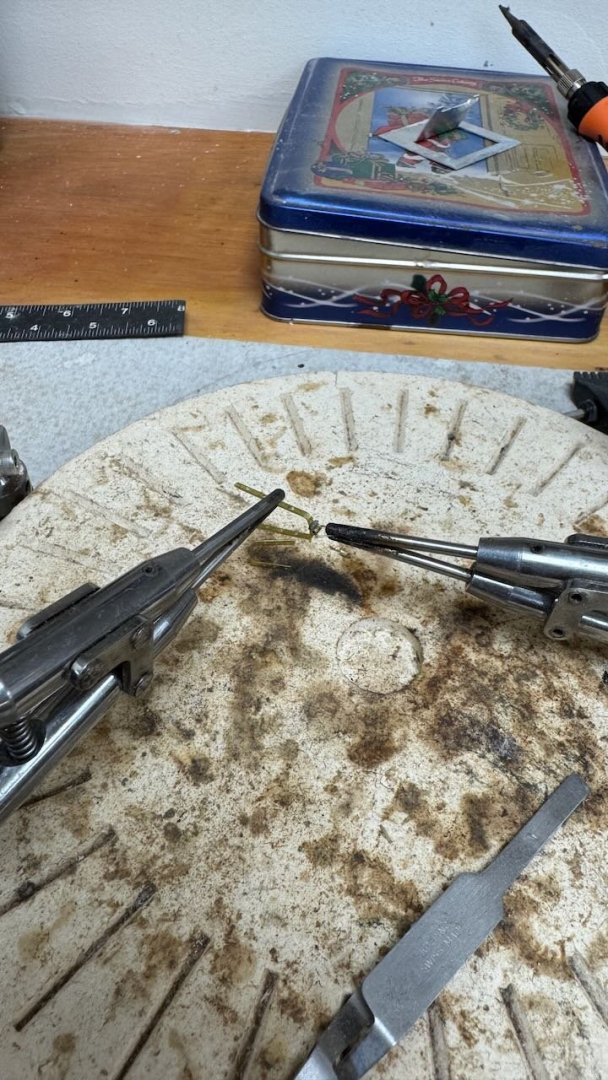

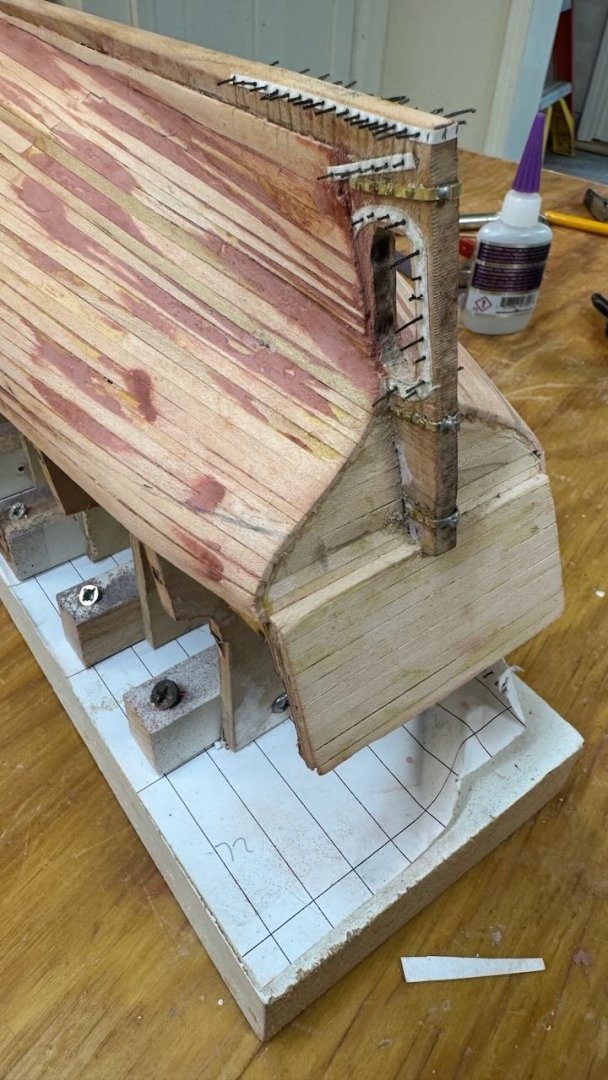

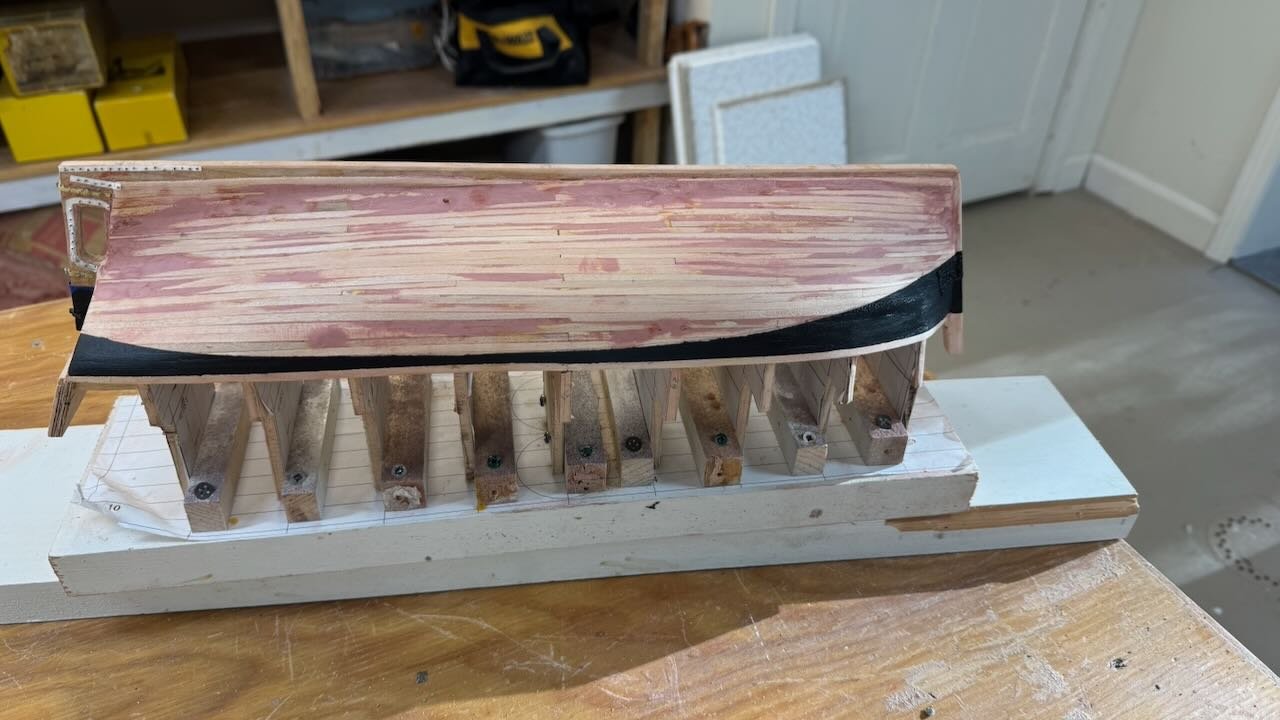


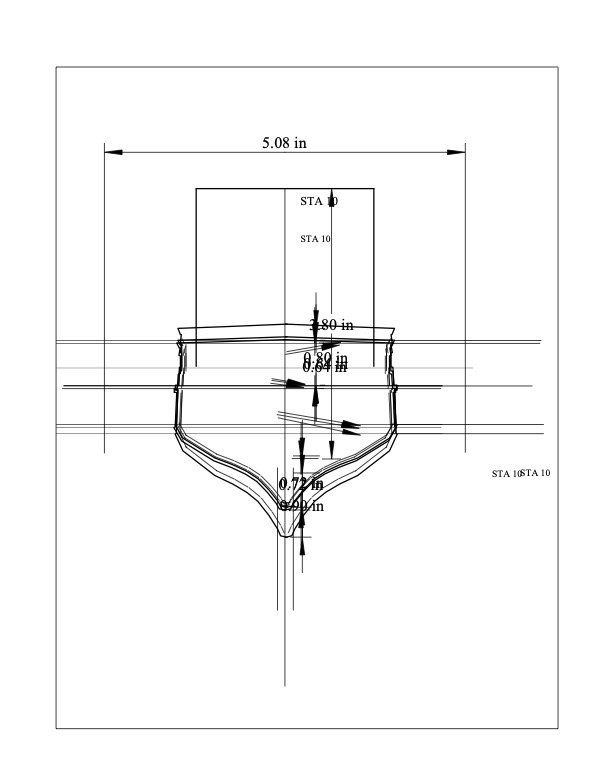
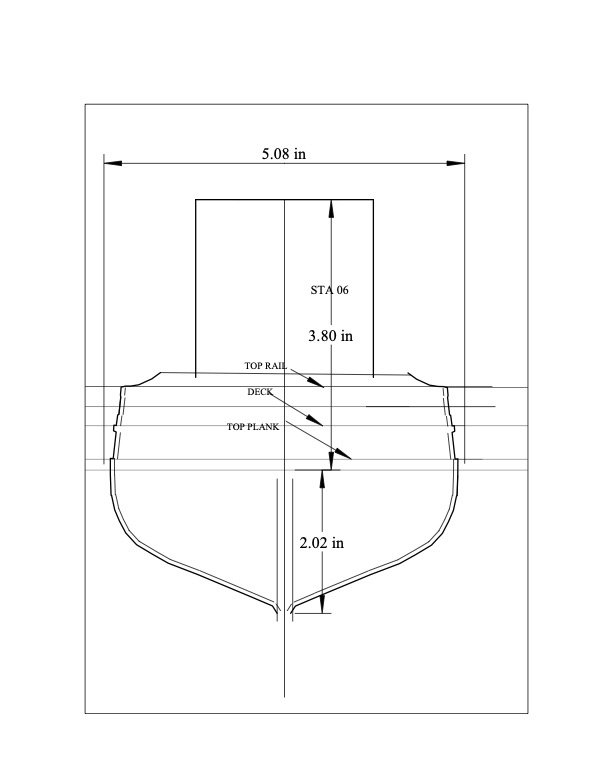

Gjoa 1872 by Jond - 1:48 scale - Amundson's Cutter
in - Build logs for subjects built 1851 - 1900
Posted
Thanks John for dropping in. Yes it is great that Jim has rejoined our group. In past years he always had incredible builds and very valuable advise especially for folks like me learning our way.
I must say the work you do on Red Jacket is beyond belief sometimes. It's just great to watch and see when you bring her along. Both of my builds are 1:48, so I can at least see the blocks
cheers